Allison Collection Photos
June, 1943
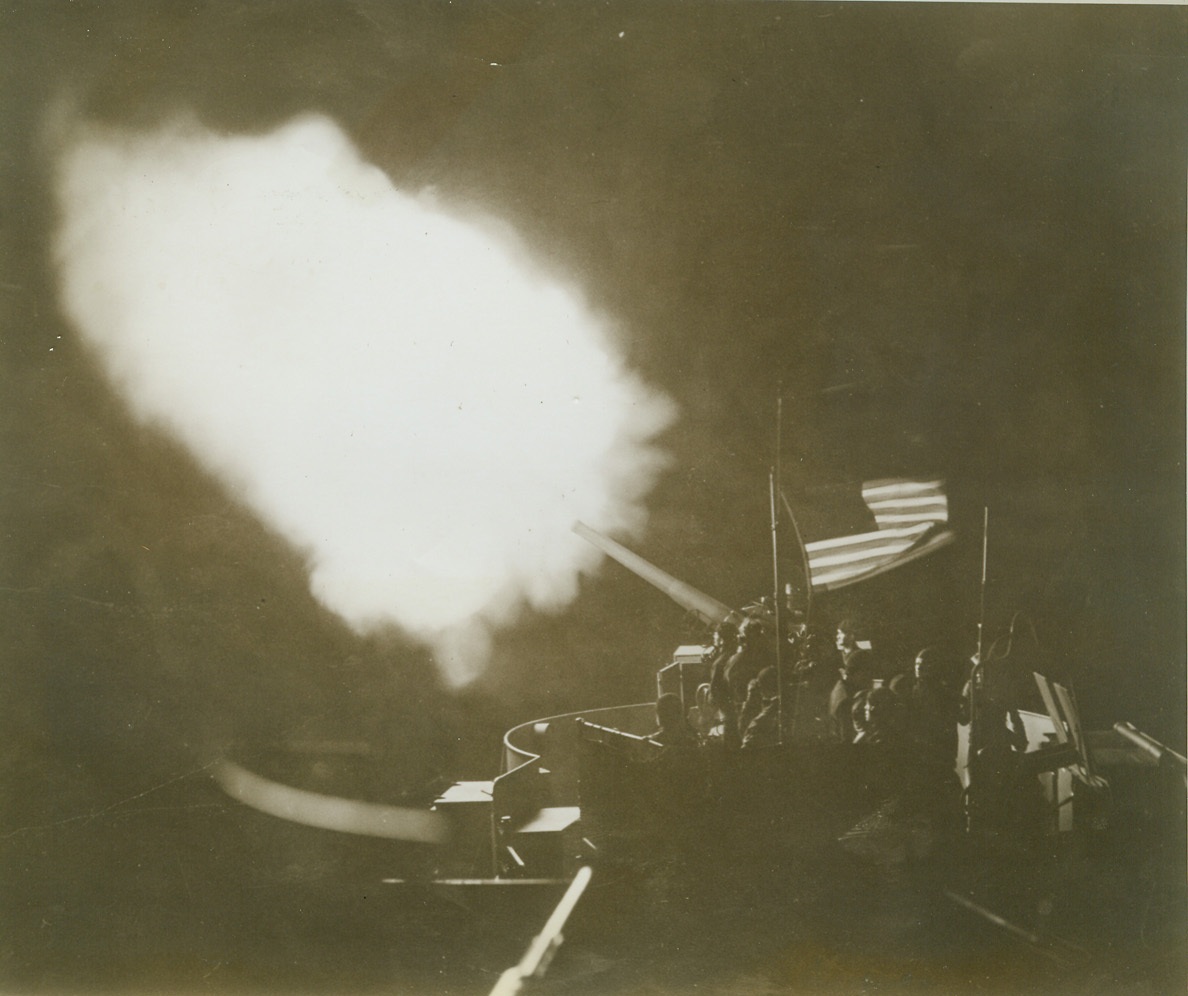
“Proof Thru the Night…”, 6/10/1943. Somewhere in the North Atlantic – Sending a fiery blast into North Atlantic skies from the deck of an American Destroyer, this gun casts a glow on “Old Glory” giving “proof thru the night that our flag was still there”. The gun crew went into action while escorting a United Nations convoy through sub-infested seas. Credit: (Official U.S. Navy Photo from ACME);
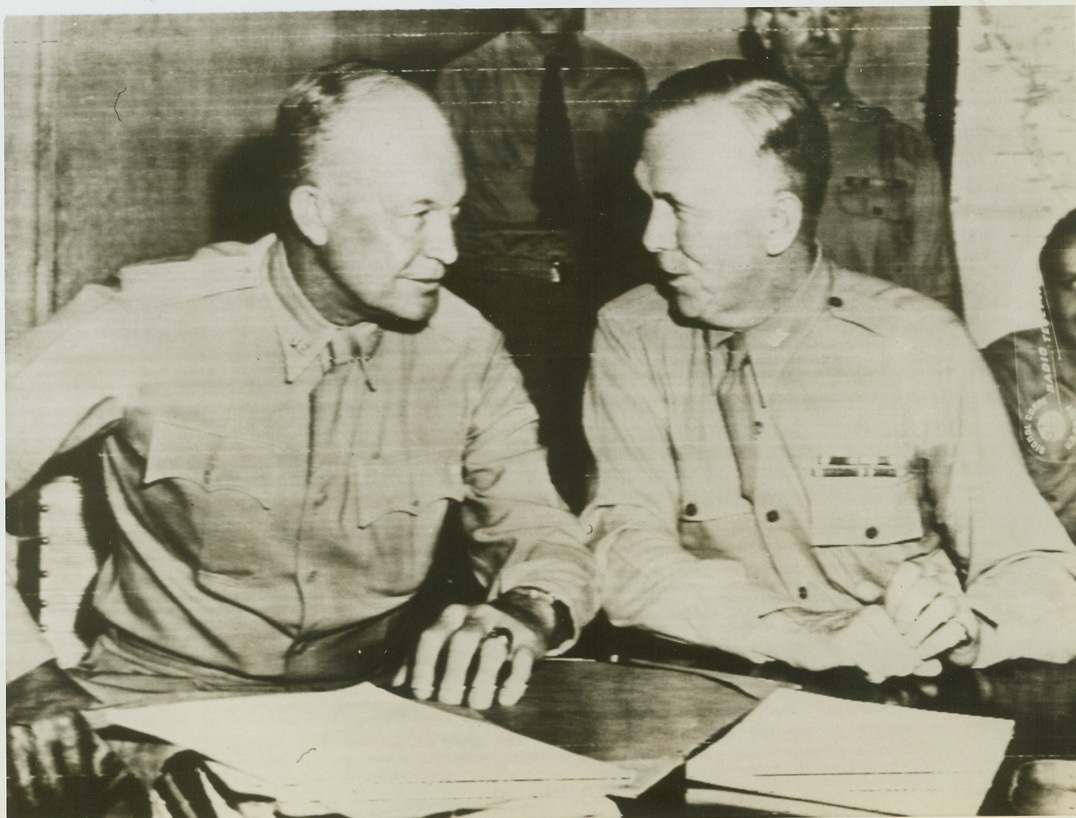
MARSHALL AND EISENHOWER CONFER, 6/5/1943. NORTH AFRICA – General George C. Marshall, U.S. Army Chief of Staff, is shown conferring with General Dwight Eisenhower (left), Allied Commander in Chief, during an informal press conference held at Allied Headquarters in North Africa. Gen. Marshall accompanied British Prime Minister Winston Churchill to North Africa from Washington. Credit: Signal Corps photo via OWI Radiophoto from ACME;
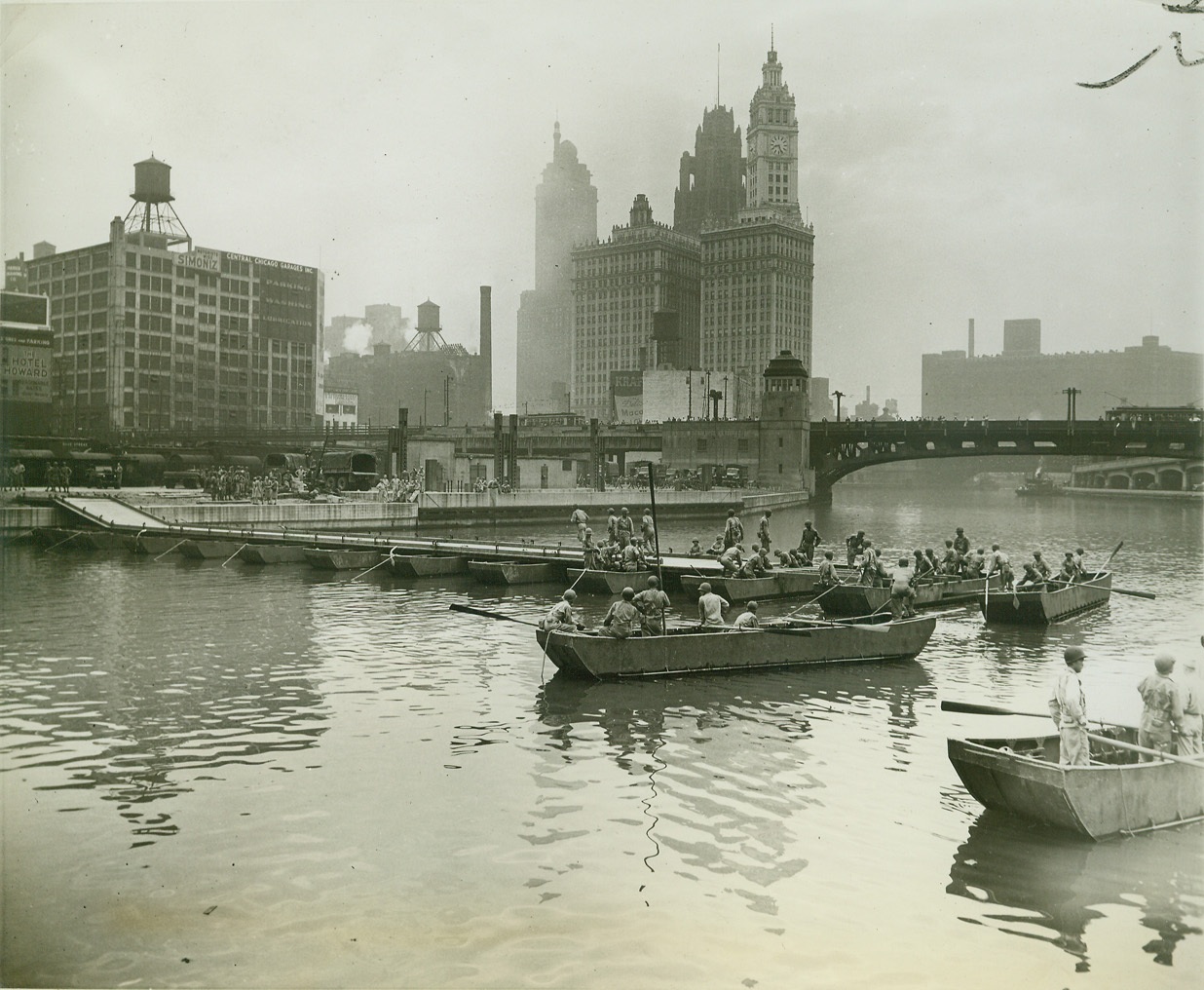
ARMY BRIDGES CHICAGO RIVER IN 55 MINUTES, 6/16/1943. CHICAGO – In a little less than an hour, U.S. Army engineers from Camp McCoy, Wis., built across the Chicago River at State Street a pontoon bridge capable of carrying a load of ten tons, and within another hour had dismantled it. The demonstration was made in celebration of the Engineers 168th anniversary. Credit: OWI Radiophoto from ACME;
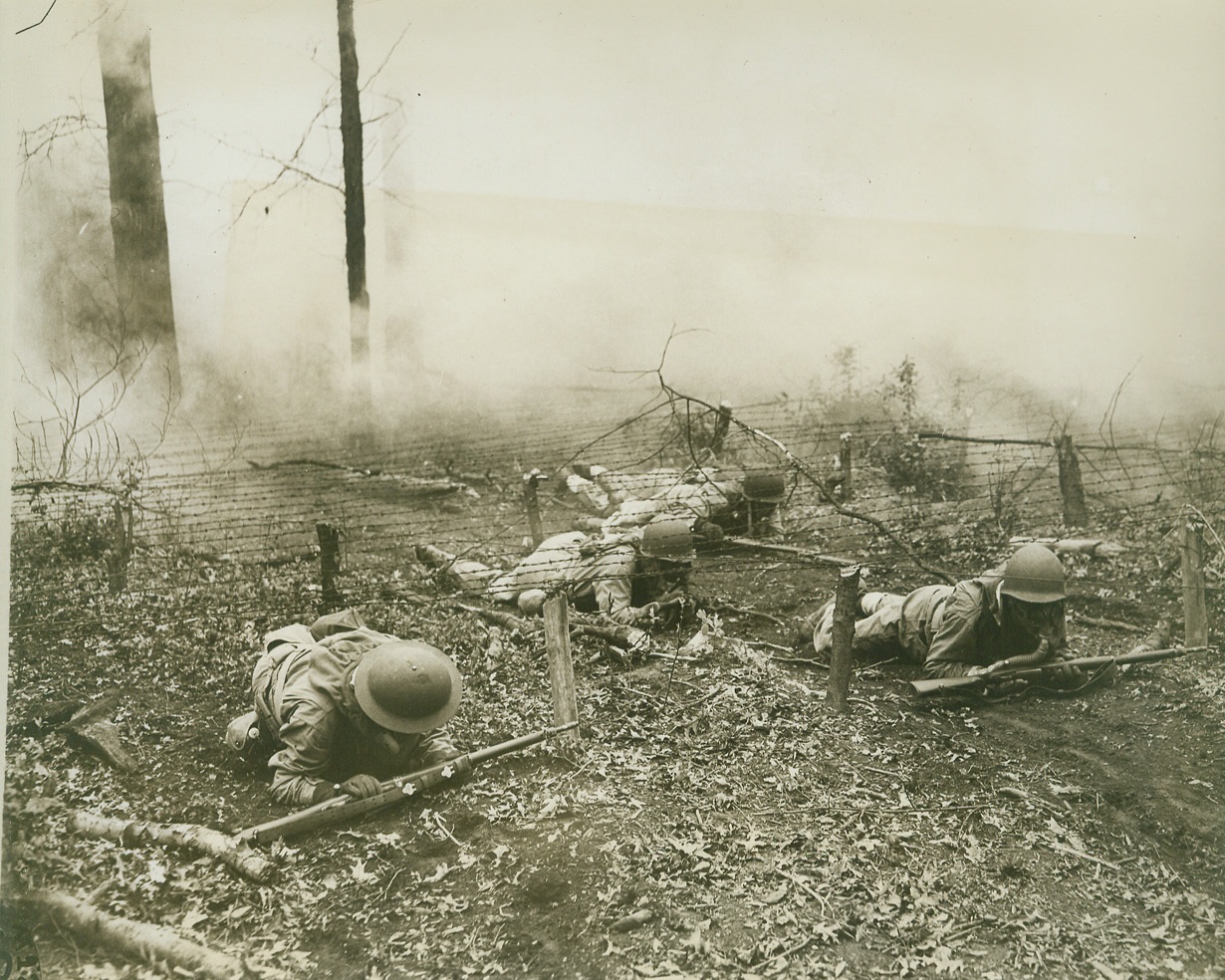
IF AXIS WANTS GAS, THEY’LL GET IT!, 6/9/1943. WASHINGTON, D.C. – For the third time since the war began, President Roosevelt has warned the Axis powers that if they use poison gas in a desperate effort to stem the Allied tide of victory, the United Nations will bring “full and swift retaliation in kind” upon Axis munitions centers, seaports and other military objectives. “Acts of this nature committed against any one” of the Allies will be regarded as having been committed against the United States itself and “treated accordingly”, the President promised. Here is sound proof that Roosevelt wasn’t bluffing. At an Eastern Arsenal, U.S. soldiers are taught to fight during a gas attack. Credit: OWI Radiophoto from ACME;
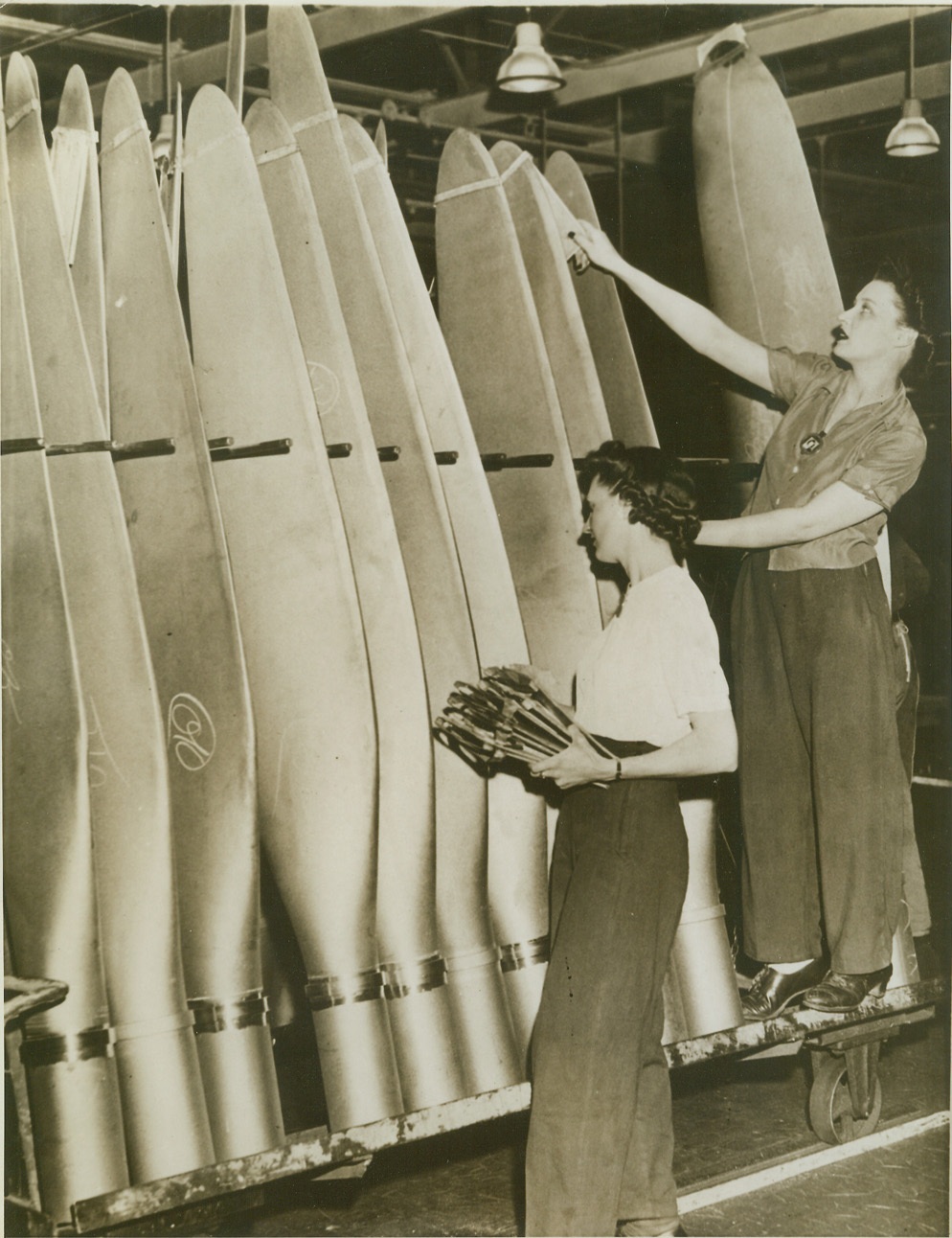
HOLLOW STEEL READY FOR THE SKYWAYS, 6/20/1943. PITTSBURGH DISTRICT, PA. – Gleaming hollow steel propellers, soon to whirr on United Nations warplanes, are checked on the final assembly line by Kathren Krumpe and Ann Newdonski, workers at a Curtiss-Wright propeller plant in the Pittsburgh district of Pennsylvania. The plant is reported to be the largest producer of hollow ground steel blades in the nation. Credit: ACME;
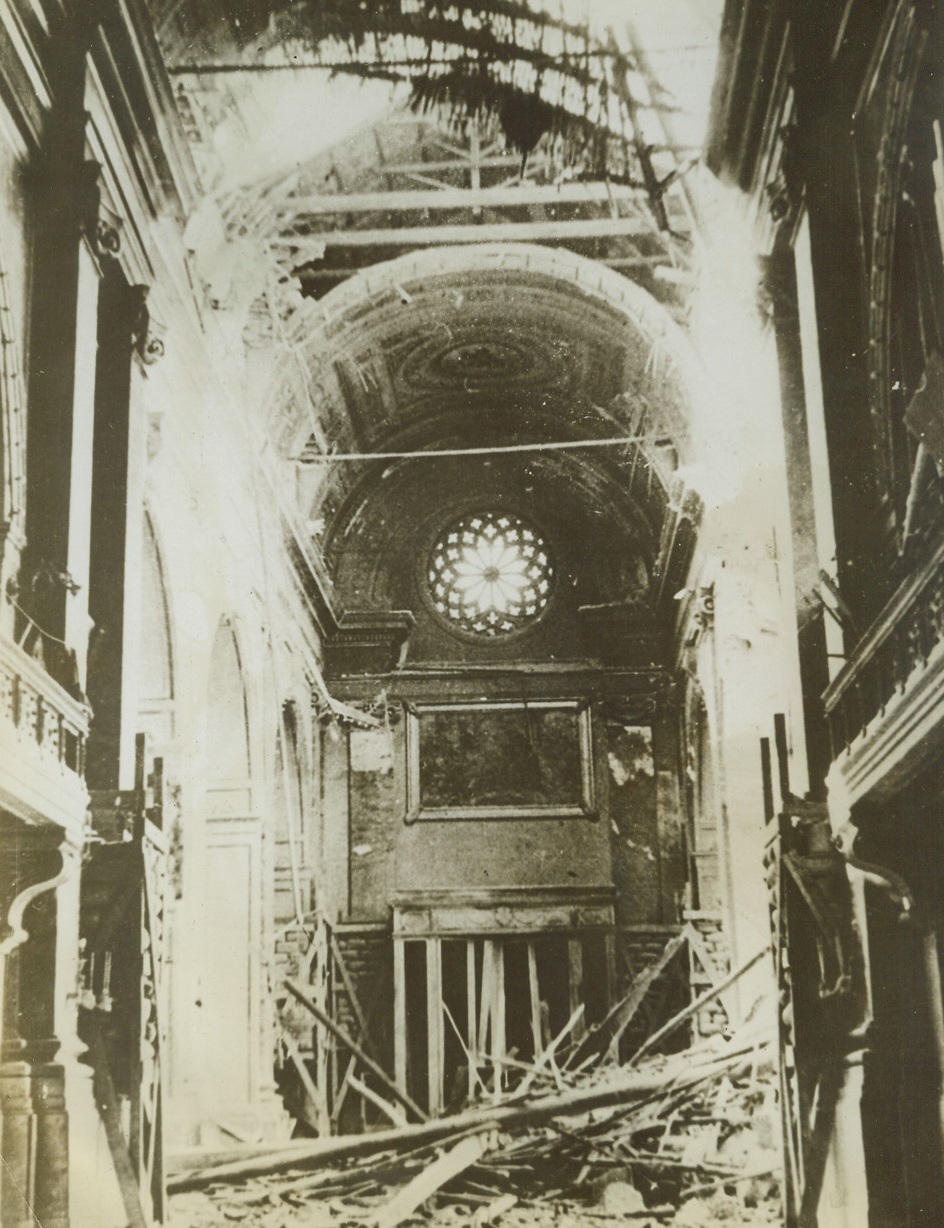
Palermo Church Hit by Allied Bombs, 6/29/1943. SICILY—Allied bombers, attacking Palermo, according to the caption on this picture received from a neutral source. Although our airmen have pledged themselves to steer free of the Vatican should they bomb Rome, it is not always possible to pick out industrial targets in crowded war centers. Credit: ACME.;
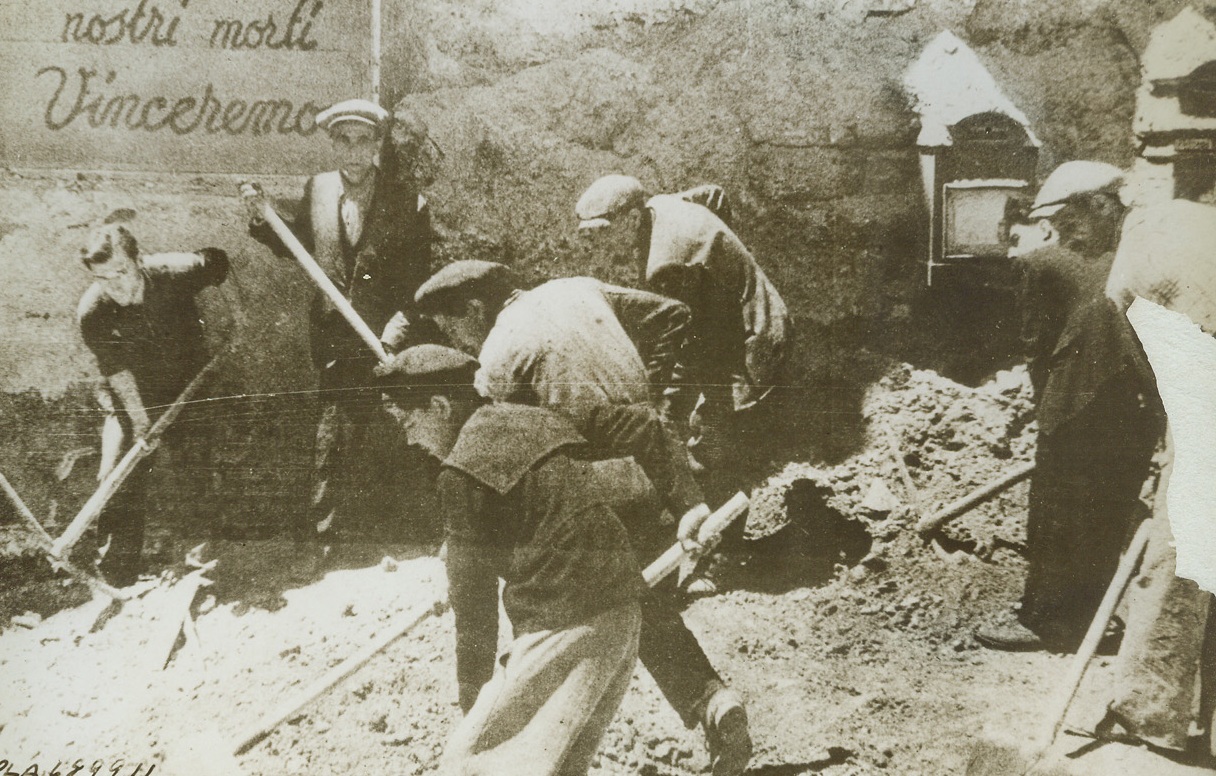
Wanted: More Clean-Up Squads in Sicily, 6/29/1943. SICILY—So great has been the damage done to Sicily by Allied bombers that workmen have been sent over from Italy to aid the clearing of the debris. The poster in back of this street cleaning squad reads: “In the name of our dead we shall conquer.” Sicilians aren’t so sure, a Mussolini orders all but essential workers to evacuate the island’s cities. Photo received in London from a neutral source. Credit: ACME.;
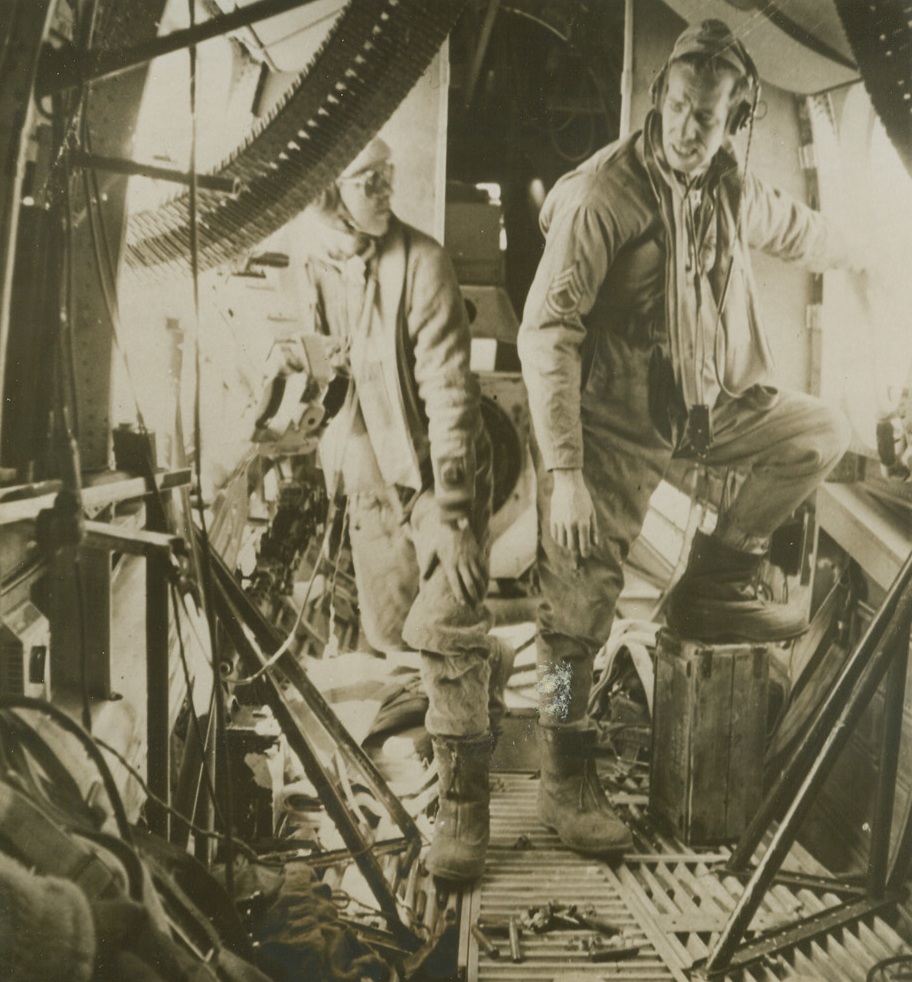
Liberator Bomber Calls on Italy, 6/27/1943. The story of an action-packed ten-hour flight of a formation of Liberator bombers that winged from a Libyan airport to blast Grottagli, Italy, is told in this series of pictures. Aside from the high altitude chill, the photographer’s main difficulty was keeping out of the way of battling waist gunners in the Liberator he rode. A formation of 12 German Messerschmidt 109’s attacked the U.S. bombers of the Army Air Force and were beaten off. Here are some of the high spots of the recent raid. New York BureauTwo waist gunners let out a deep breath and compare notes on the trouncing they just gave German planes. They are T/Sgt. H.M. Conlee (left), of Mord, Ore. And T/Sgt H.M. V.F. Wachs, of Pittston, Pa. Credit: ACME.;

Liberator Bomber Calls on Italy, 6/27/1943. This is the tense moment of the raid as Waist Gunners T/Sgt. H.M. Conlee (left), of Mord, Ore. And T/Sgt H.M. V.F. Wachs, of Pittston, Pa., blast at the Nazi attackers with their machine guns. The German planes are yellow-nose Messerschmidt 109’s. Credit: ACME.;
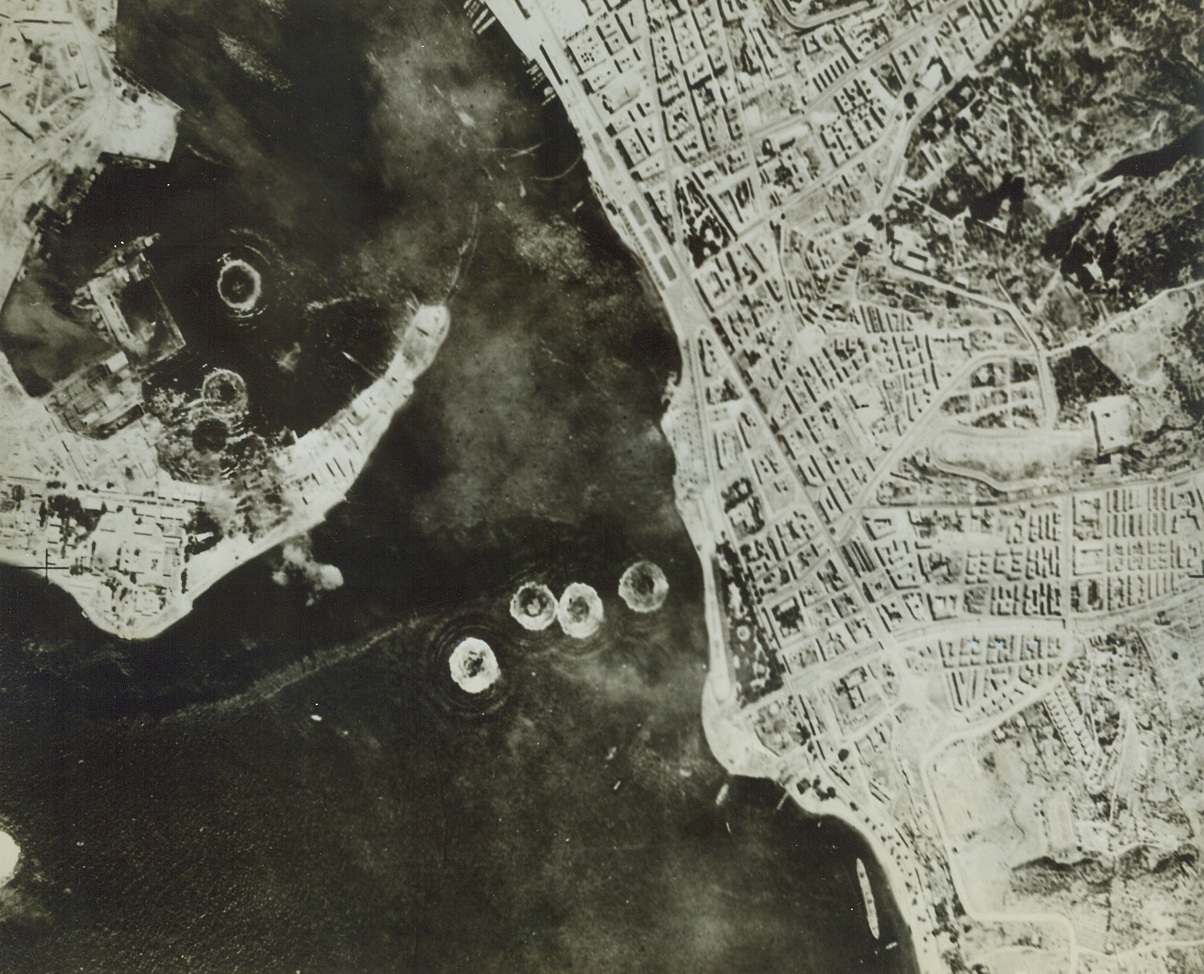
Softening Up Messina, 6/18/1943. Allied bombs are shown exploding on the strategic waterfront area of Messina Harbor in this photo taken from an American high altitude bomber. Without let-up, the daylight bombing of important cities such as this one along the southern coast of Italy continues. Credit (U.S. ARMY AIR FORCE PHOTO FROM ACME);
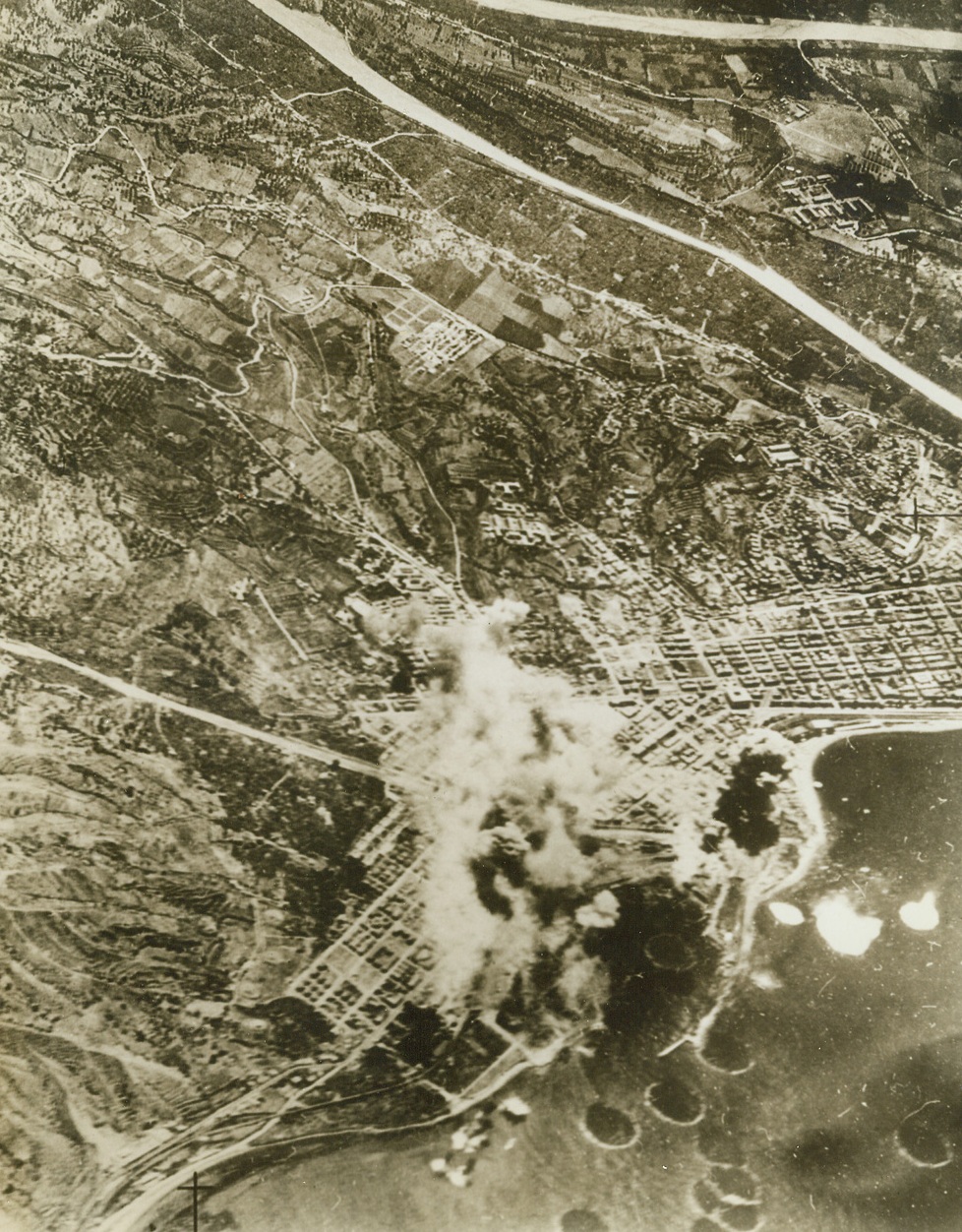
Reggio Gets Some of Pantelleria’s Medicine, 6/12/1943. REGGIO, ITALY – Now that Pantelleria has succumbed to the relentless Allied “invasion by air”, the United Nations air forces are turning full force on Mussolini’s mainland. Smoke and debris soar skyward as Reggio, a key Italian port at the tip of the boot, facing Sicily, feels the impact of Allied bombs. Both Reggio and San Giovanni are learning of the deadly accuracy of American bombardiers as they batter at the not-so-soft underbelly of Europe. Credit Line (Official U.S. Army Photo from Acme);
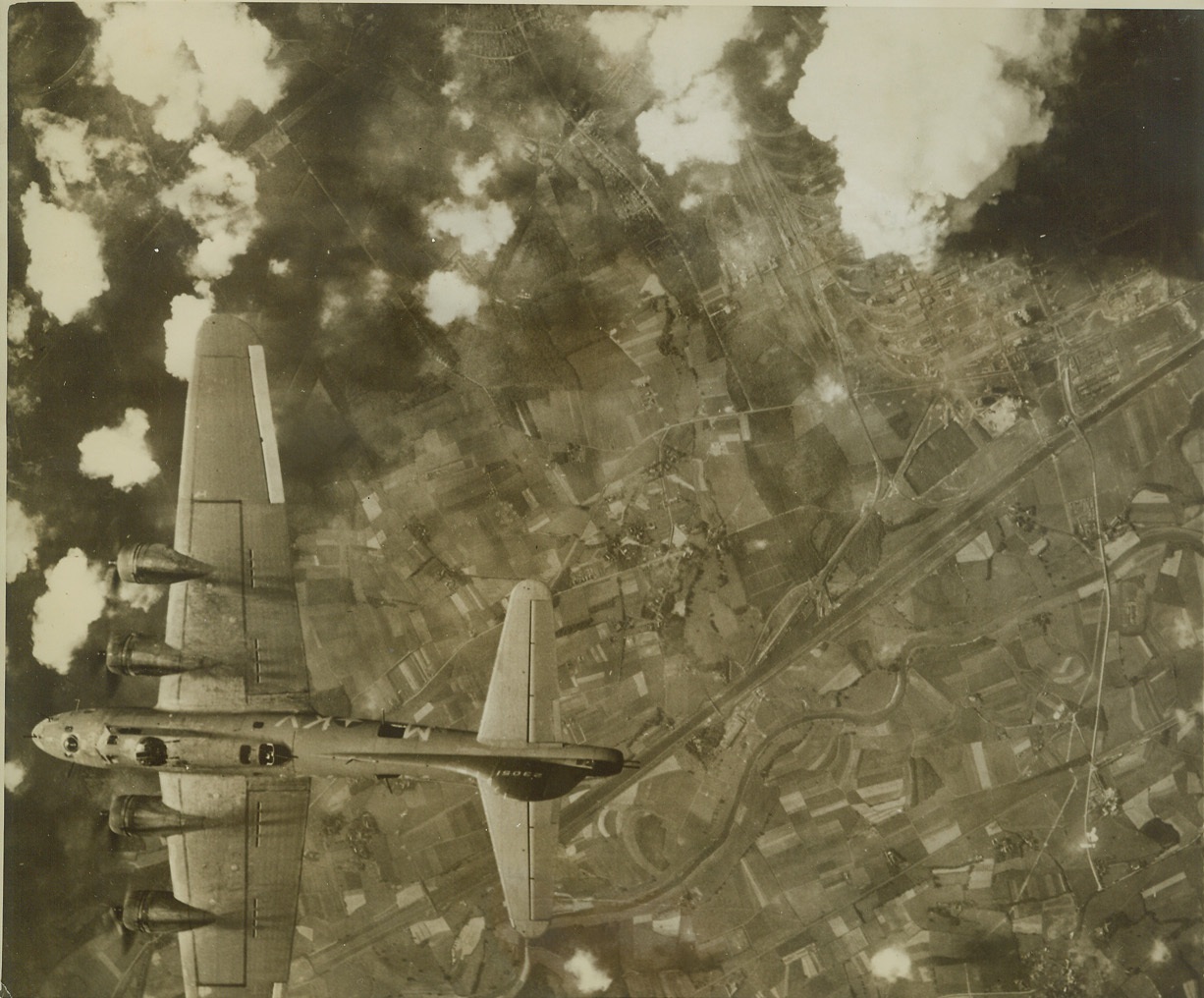
Rub-Out on Rubber, 6/29/1943. RUHR, GERMANY -- Hell breaks loose in the Ruhr, as a close-packed formation on Flying Fortresses scrambles synthetic rubber plants at Huls. The camera picked out this one Fortress out of the close formation flown by the big bombers to mass their fire power against enemy fighters. In the upper right hand corner the smoke from a blasted factory rises up over the target area as group after group of Fortresses roar through their bombing runs. Credit: (ACME);

Tiny Stepping-Stone to Italy, 6/15/1943. RAF Boston Bombers roar over Lampedusa, the tiny bleak island off Italy which fell to the Allies on June 12. Wave of bombers hammered the Italian isle into submission while ships of the British Mediterranean fleet bombarded Lampedusa’s only harbor and later supported Allied landing forces. Mitchells, Bostons, Baltimores and Lightenings and Warhawks lambasted the small island until a white flag of surrender flapped an invitation to invasion. Credit (Acme Radiophoto);
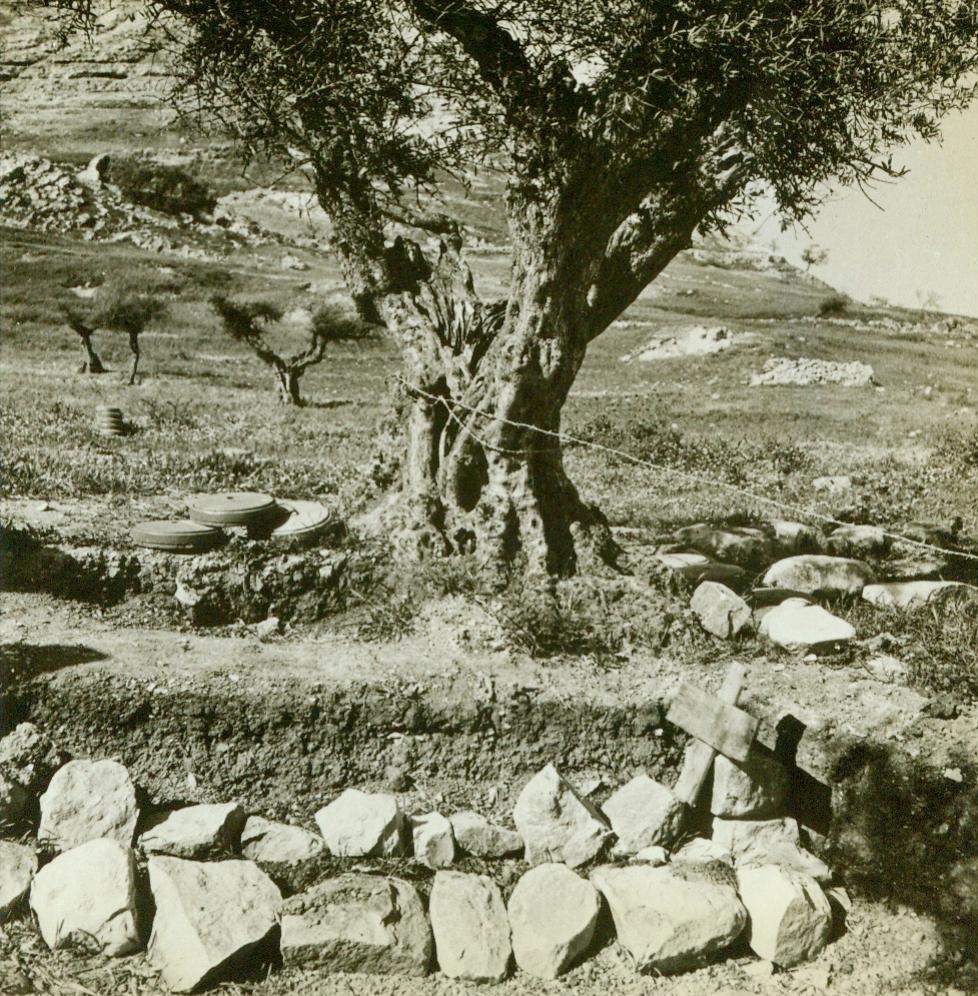
Hill 609 Bizerte, 6/5/1943. Tunisia -- German Graves, Land Mines, Foxholes, Barbed Wire, Ammunition, Artillery Fire Mounds 6/5/43;
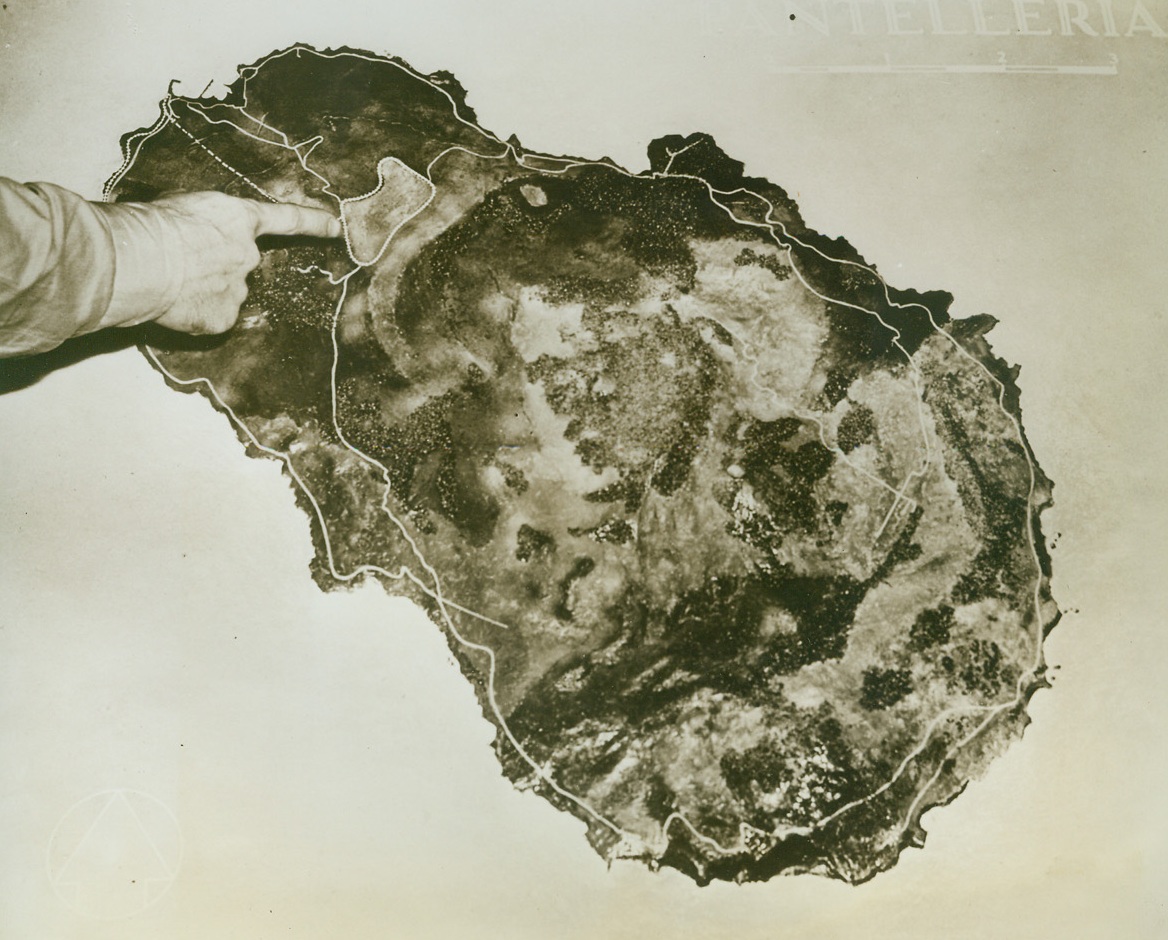
Relief Map of Pantelleria, 6/12/1943. Here’s a bombardier’s view of the newly-won Mediterranean island of Pantelleria, which surrendered after a record blasting by American bombers. Narrow gauge railroad may be seen running from quarry along the shore to the village and harbor, from which another railway runs uphill, mostly underground, to man-made caverns which housed Axis planes and repair shops. The rugged nature of the terrain is demonstrated by this photograph of a model. The darker areas represent lava flows. Credit Line (Official US Army Photo from Acme);
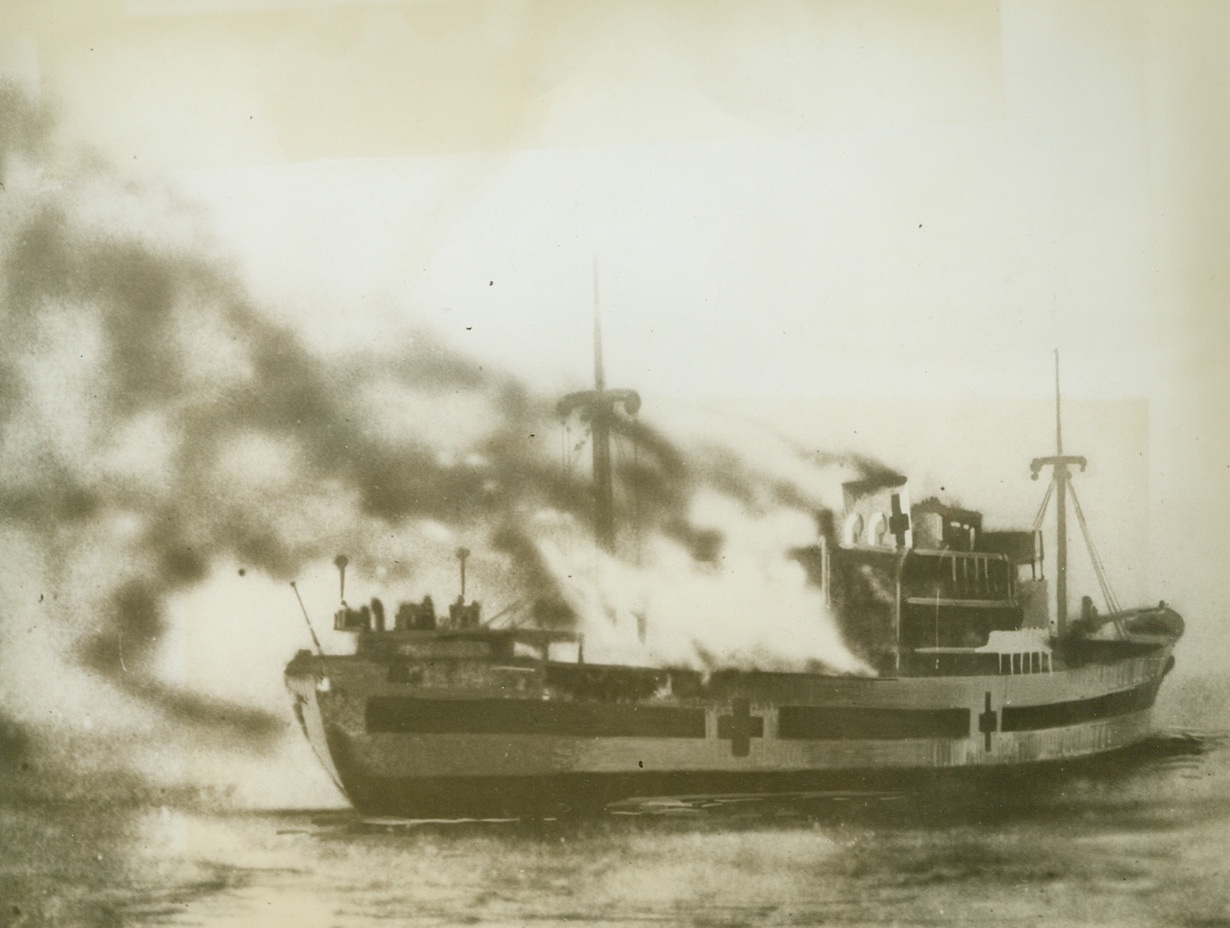
Red Cross Glows ‘Neath Flame, 6/10/1943. A red cross glows from the side of the burning hospital ship, “Ramb IV,” visible now as it was when enemy aircraft bombed and sunk the vessel in the Mediterranean on May 10th. There were six hundred wounded soldiers aboard the mercy ship when she left Tobruk. Originally an Italian hospital ship, the “Ramb IV” was detained in 1941 for use by British and enemy wound. Photo was made by one of the survivors. Credit Line (Acme);
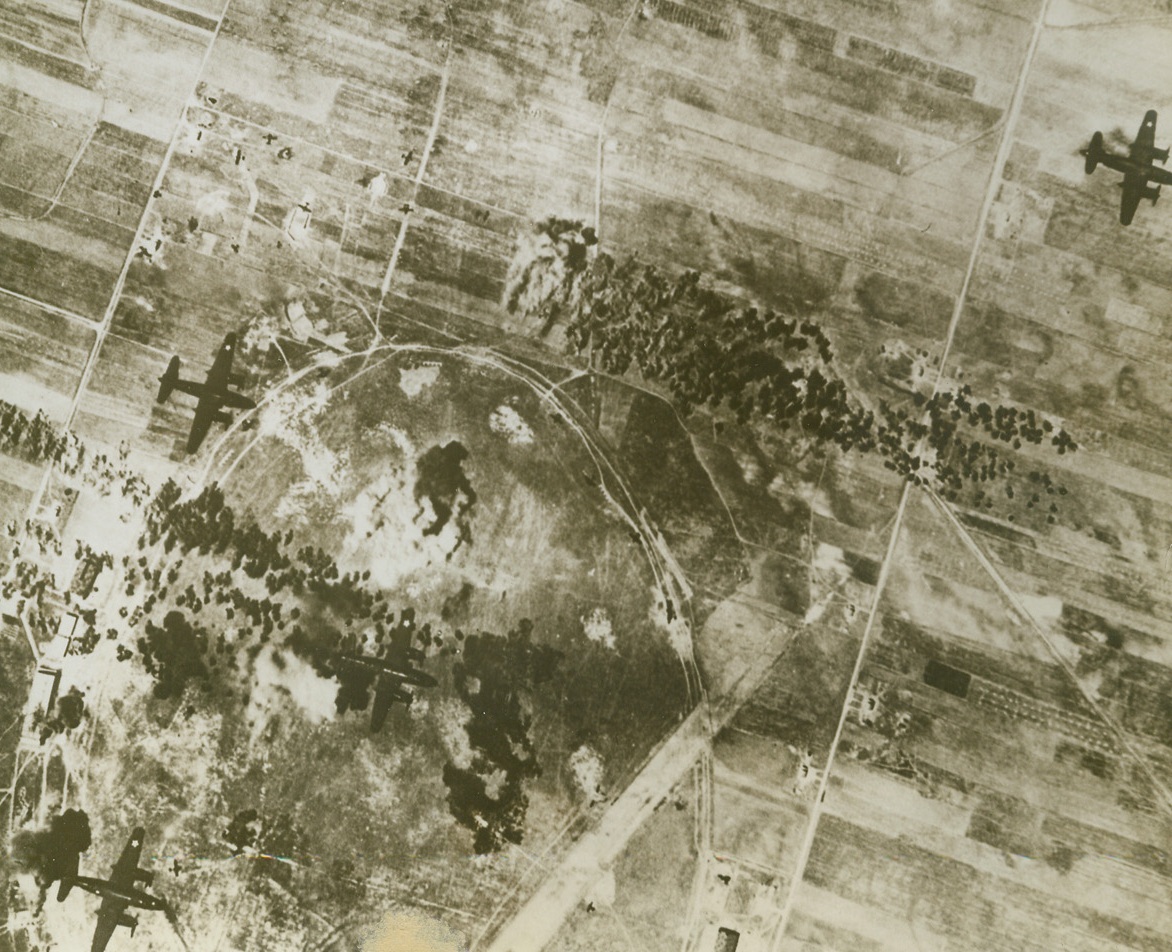
Characteristic View of Italian Airfield, 6/15/1943. American B-26 Marauders catch Italian planes flat-footed on the ground as they drop their sticks of bombs in the death-like pattern that has been ripping up Italian airfields. The plane in the upper right hand corner has just completed its job. Credit Line (U.S. Army Air Corps Photo from Acme);
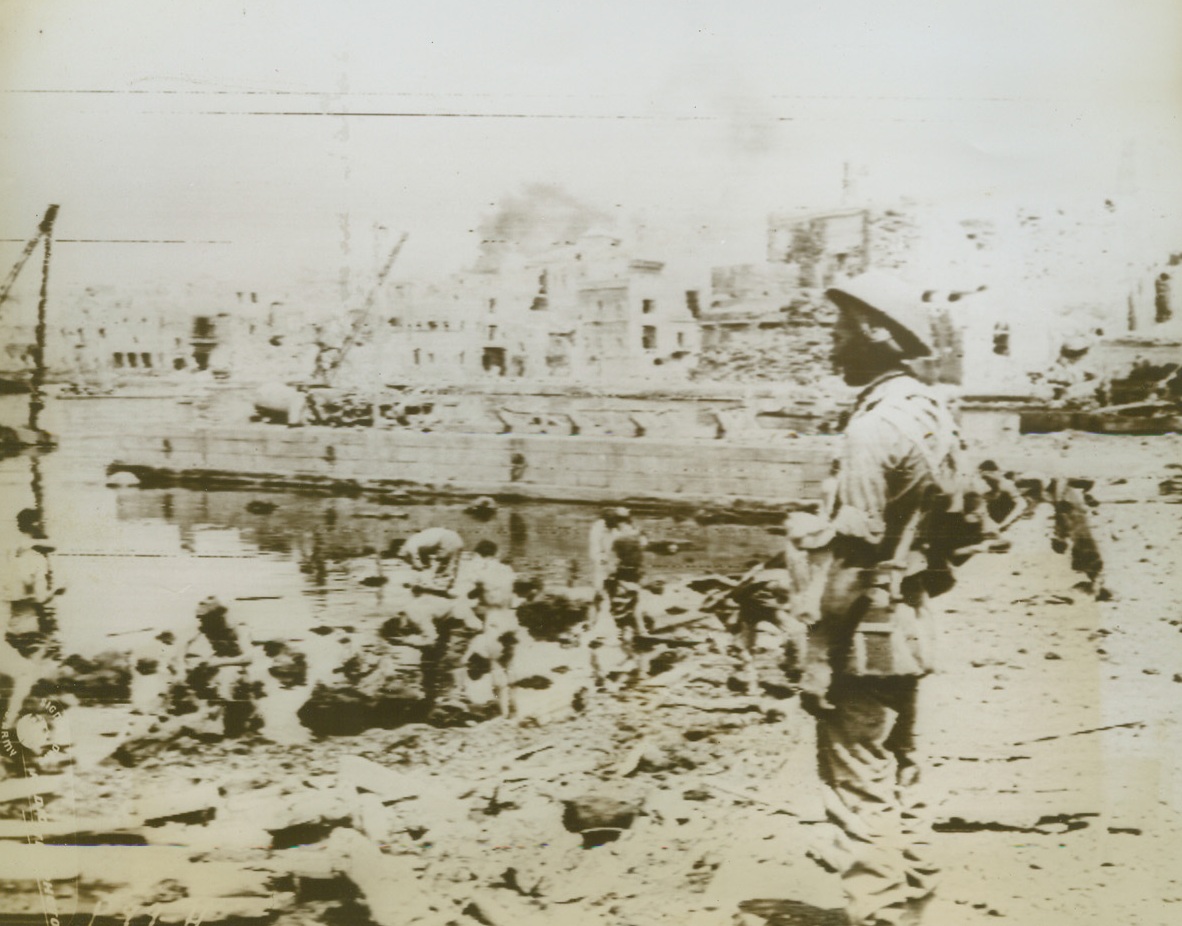
Italian Prisoners Bathe After Capture, 6/14/1943. PANTELLERIA – The above photo, flashed here by US Army Radiotelephoto, shows Italian prisoners who were captured on Pantelleria washing in the harbor supervised by a guard in the foreground. In the background may be seen the ruins of the island with some areas still smoking. Credit (British Official Photo from Acme via Radiotelephoto);
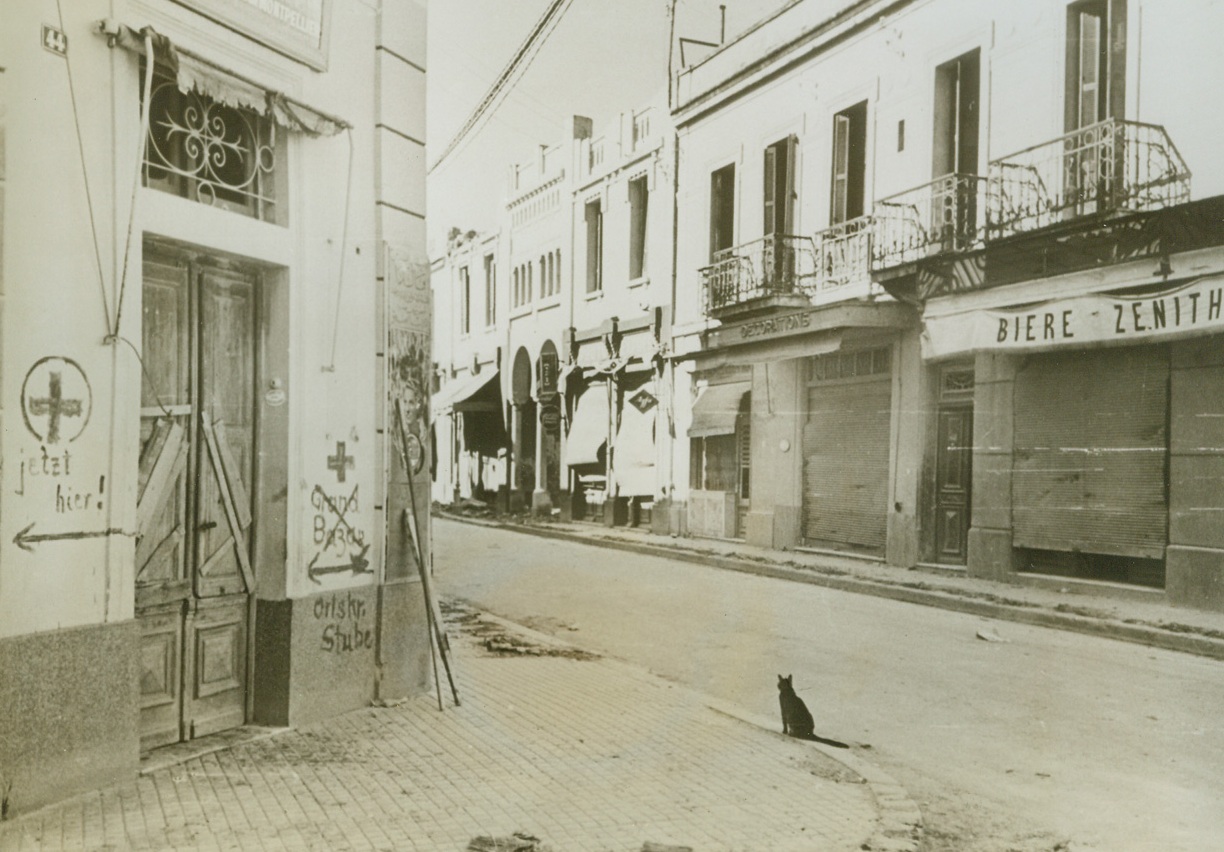
Only a Cat, 6/5/1943. BIZERTE – A lonely black cat surveys the deserted streets of Bizerte in a commercial part of the city. Note the lettering on the wall at left. The French title, “Grand Bazar,” had been given a German name and the location of the establishment had been changed. Credit Line – WP – (Acme);
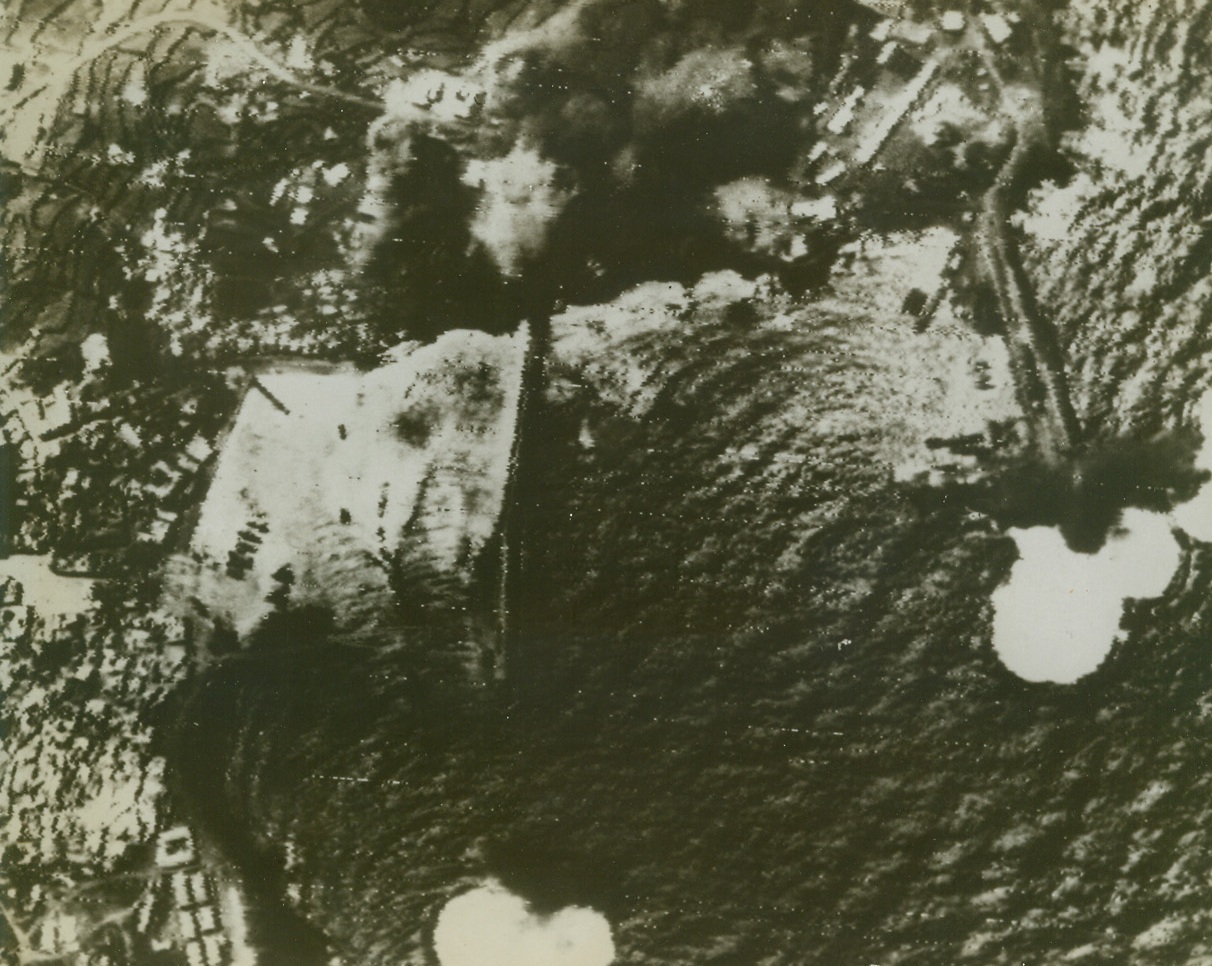
TAKING ITS DAILY BEATING, 6/7/1943. PANTELLERIA—The island stepping stone from Runisia to Sicily gets a terrific pounding from Allied sea and air forces daily in the pre-invasion softening up process. Smoke rising at top of photo is from burning oil dump in the harbor. Oil storage tanks and barracks were damaged in the latest attack. Credit: Acme radiophoto;
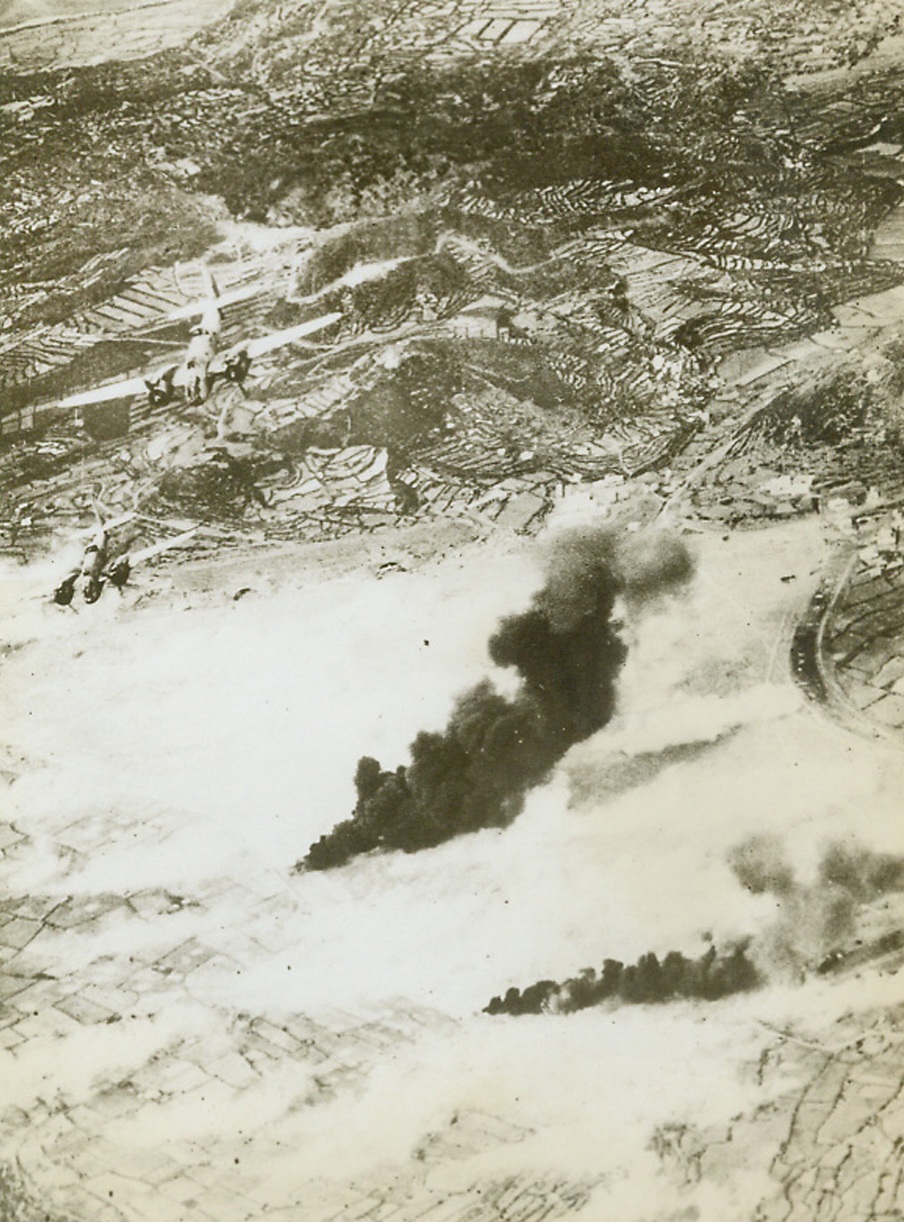
ALLIED BOMBERS SOFTEN UP PANTELLARIA, 6/3/1943. With the fighting in North Africa over, the Allies turn their air force on the Axis ports, airfields and strongholds on the Italian side of the Mediterranean, softening up these strong points in lieu of a possible Allied invasion in that direction. In this photo Baltimore bombers of the South African Air Force drop bombs on the airfield of Pantellaria, Mussolini’s island stronghold between Malta and the African coast, with columns of smoke rising from two oil fires. The landing ground is almost obscured by the smoke of bursting bombs. At the far end of the airfield can be seen the entrances to underground hangars and workshops on the side of the hill. Credit: Acme;
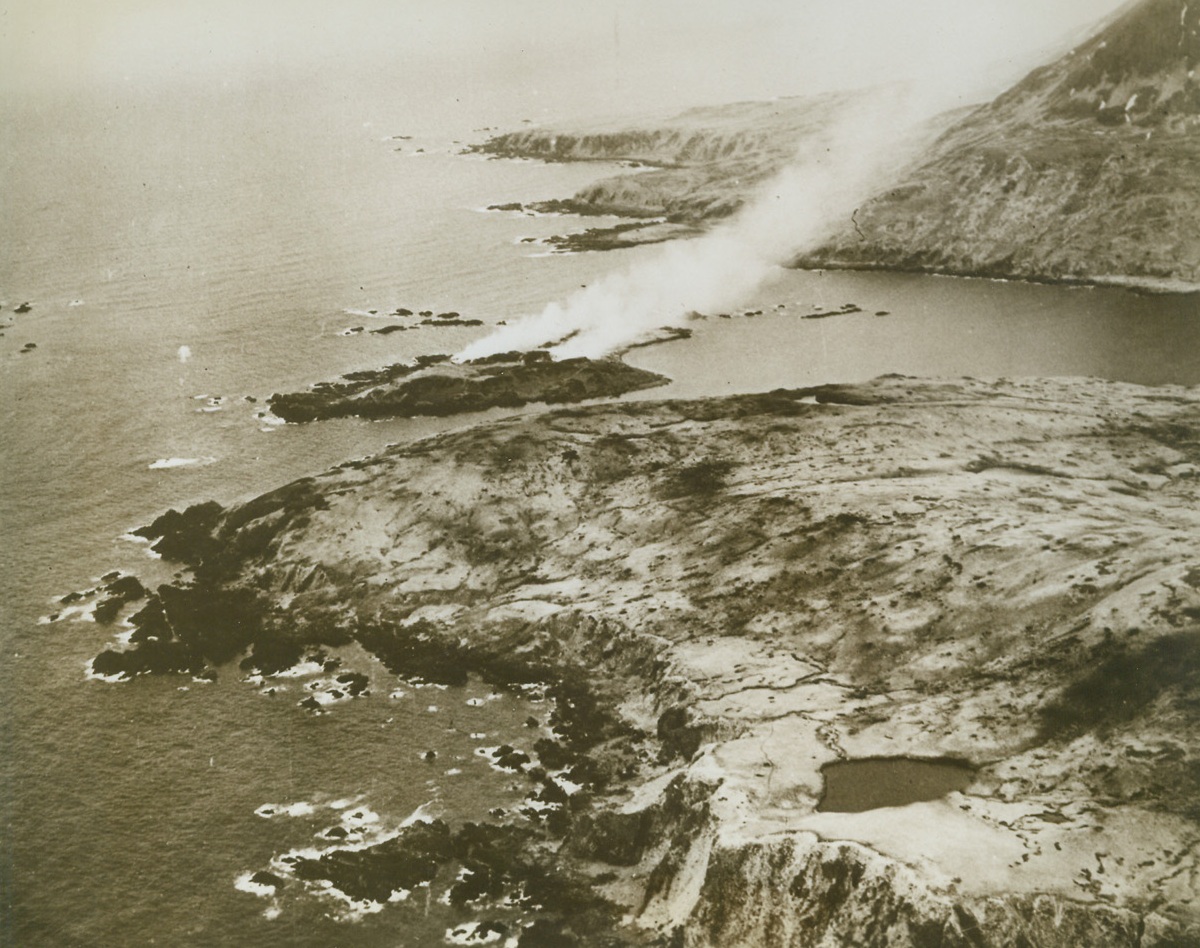
JAPS’ LAST STAND, 6/16/1943. Smoke rises from fires started by American air and ground forces on the small island of Kinnaw, off Chicagof Harbor, Attu, where the Japanese made their last stand. A U.S. Navy plane few over the shell and bomb pocked hills to make this photo on May 31st. Credit: Official U.S. Navy photo from Acme;
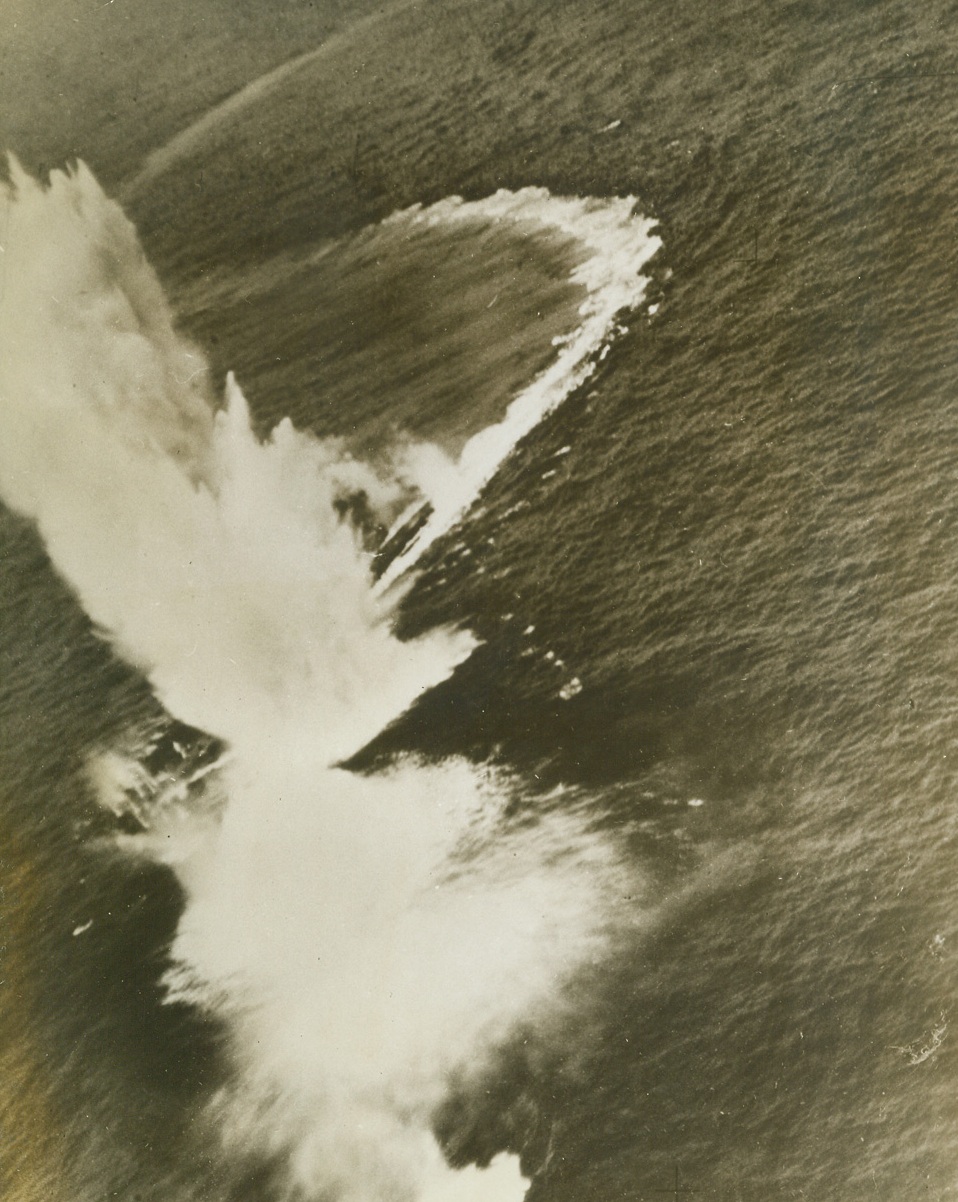
DANGEROUS CURVES AHEAD!, 6/10/1943. BAY OF BISCAY—This enemy submarine, damaged and unable to crash dive, went into a wild series of “S” curves to avoid bombing attack by two Sunderland flying boats of an Australian Squadron, only to run smack into a group of bombs from one of the planes. The Sunderlands were on patrol over the approaches to the Bay of Biscay when they spotted the U-boat. They attacked immediately, damaging the sub on the first run. Then they came in for the kill. A few moments after the above photo was taken, stern of the sub protruded from the water at a steep angle then disappeared from sight in a mass of bubbles. Several sailors were seen in the water as the U-boat went to its grave. Credit: Acme;
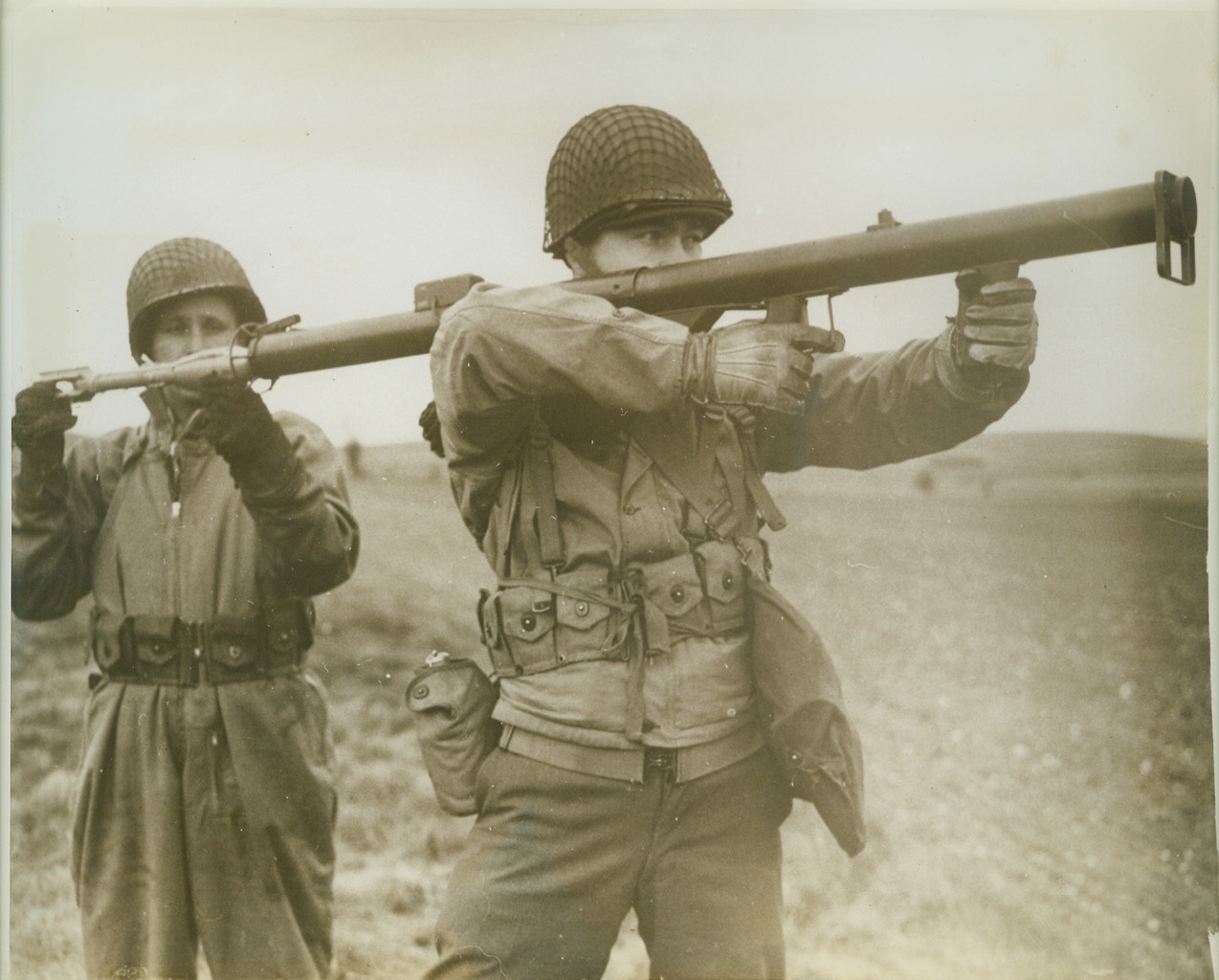
"Bazooka" Boys, 6/5/1943. SOMEWHERE IN ENGLAND -- Tho' it looks like something an imaginative youngster rigged up to play "war", this is America's latest weapon -- the "Bazooka" gun. Lt. Carl Peterson, of Dearborn, Mich., fires the gun, which sends a destructive rocket whistling toward doomed tanks and pillboxes, as Corp. Albert Salo, of Ironwood, Mich., loads the weapon. Credit: (ACME);
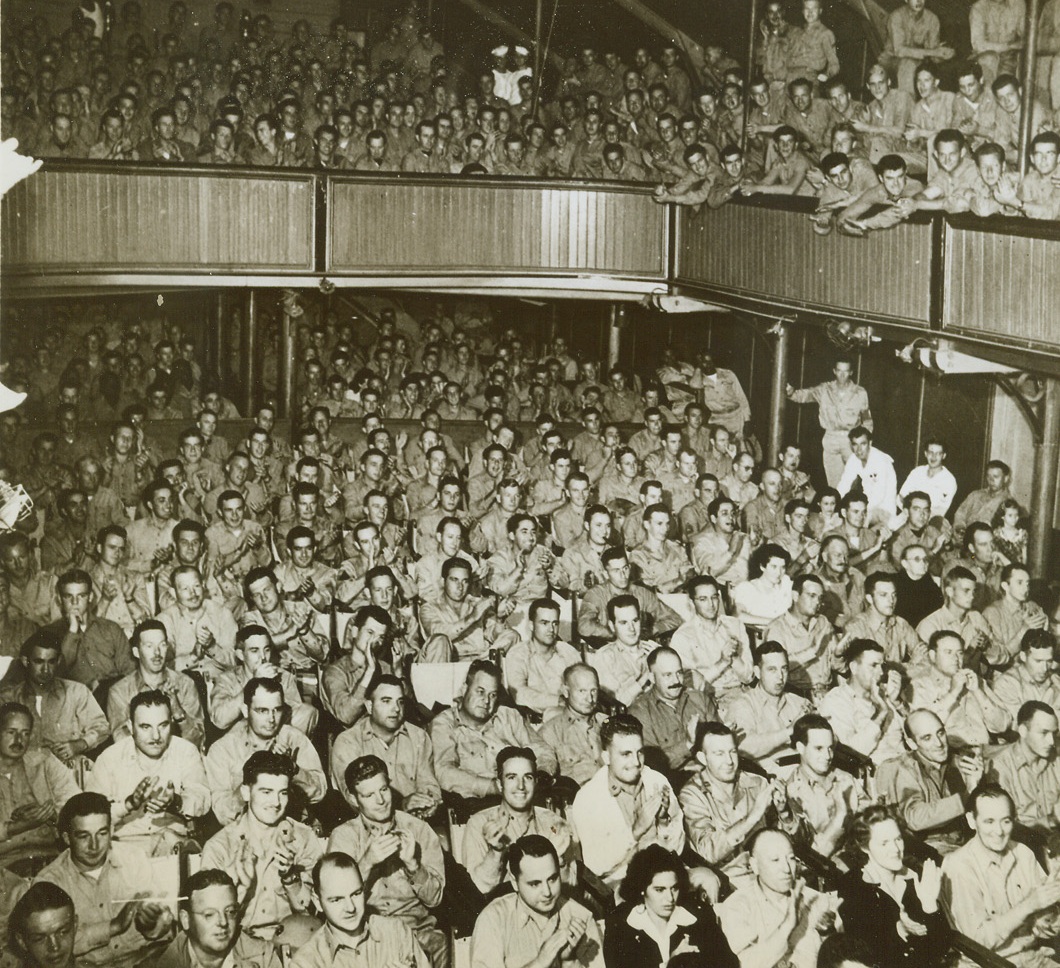
Scandal in the South Seas #3, 6/27/1943. South Sea Island Base – There’s not a sober face in the lot, as service men and guests cheer a number in the “South Sea Island Scandals.” Five lovely fighting French civilian girls were added attractions in the peppy review put on at a South Sea Island Base.Credit: ACME;
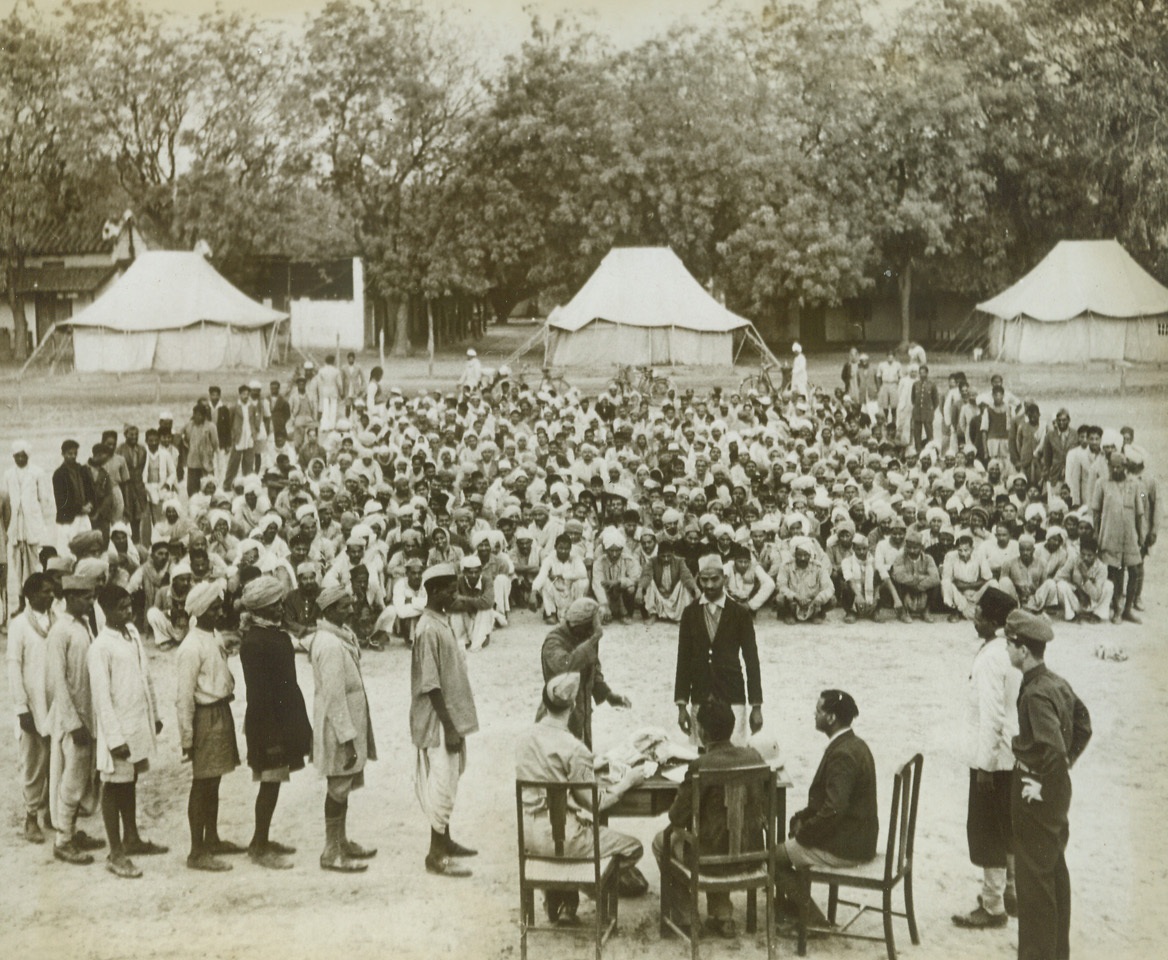
It’s Pay Day, 6/7/1943. India – Here is the monthly pay day and prize presentation on the parade ground at a U.S. Air Depot that is now being built with the help of native workers in India, the two best teams of the month get prizes and pay raises. Most popular prizes are cotton gloves which enable the men to do the work better. It has been found that this system of payment is a great improvement over the contract labor method where the contractor takes a cut out of each pay check.Credit Line - -WP- -(ACME);
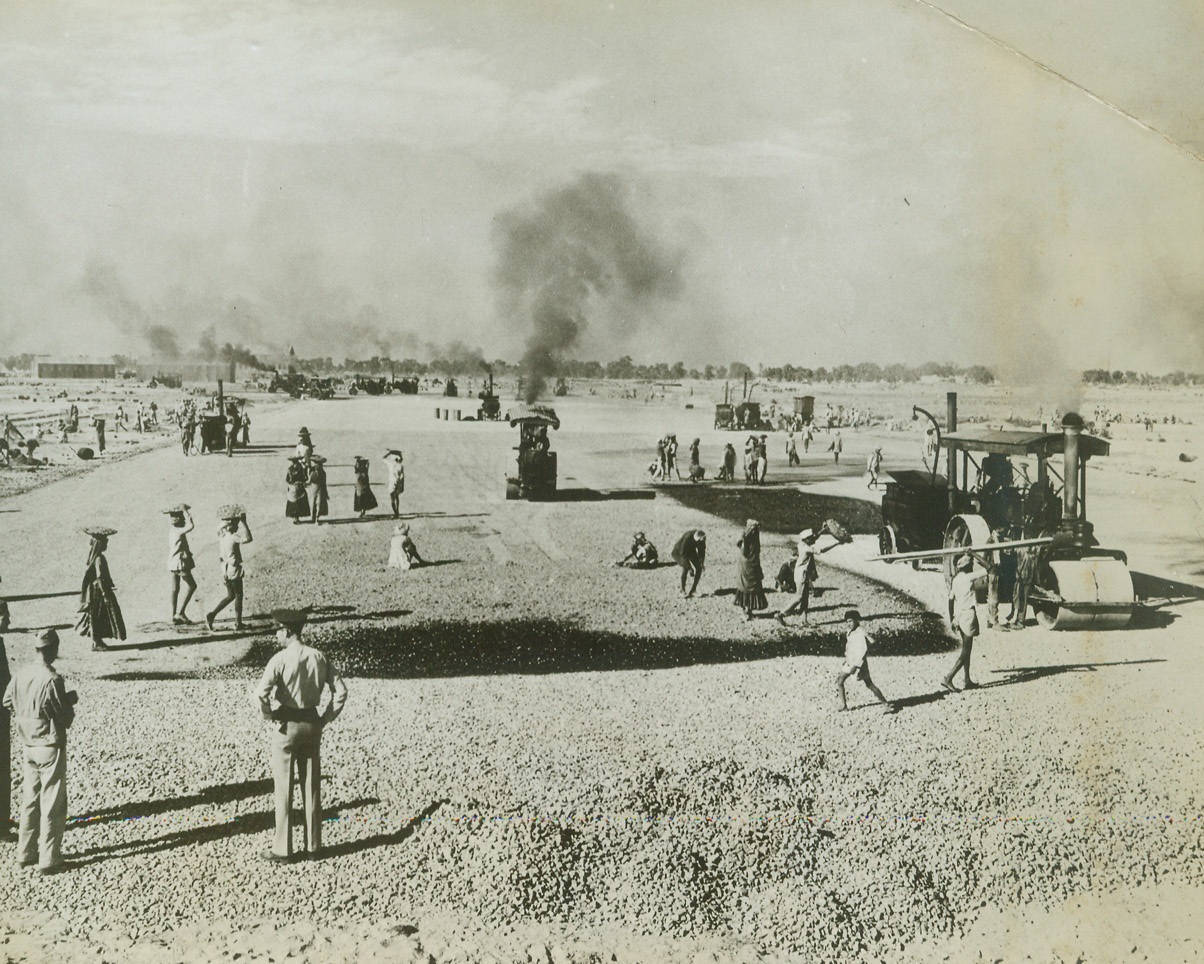
An Airfield Springs Up in India, 6/7/1943. India – Work procedes apace on a U.S. Air Depot somewhere in India. In surfacing of taxi ramp down past the hangars, a coat of tar is being laid down onto the heavy metalling of rock that lies on top of a heavier foundation of rocks. The tar is then covered with fine-crushed stone carried on the heads of coolie laborers and cast out over the wet tar. U.S. officers in the foreground are checking the plans and inspecting the work. Runway construction and grading of the airfield is done by the Indian Army Garrison Lease Agreement. Steel hangars in background were brought from the U.S. on the convoy that carried the Task Unit.Credit Line – WP –(ACME);
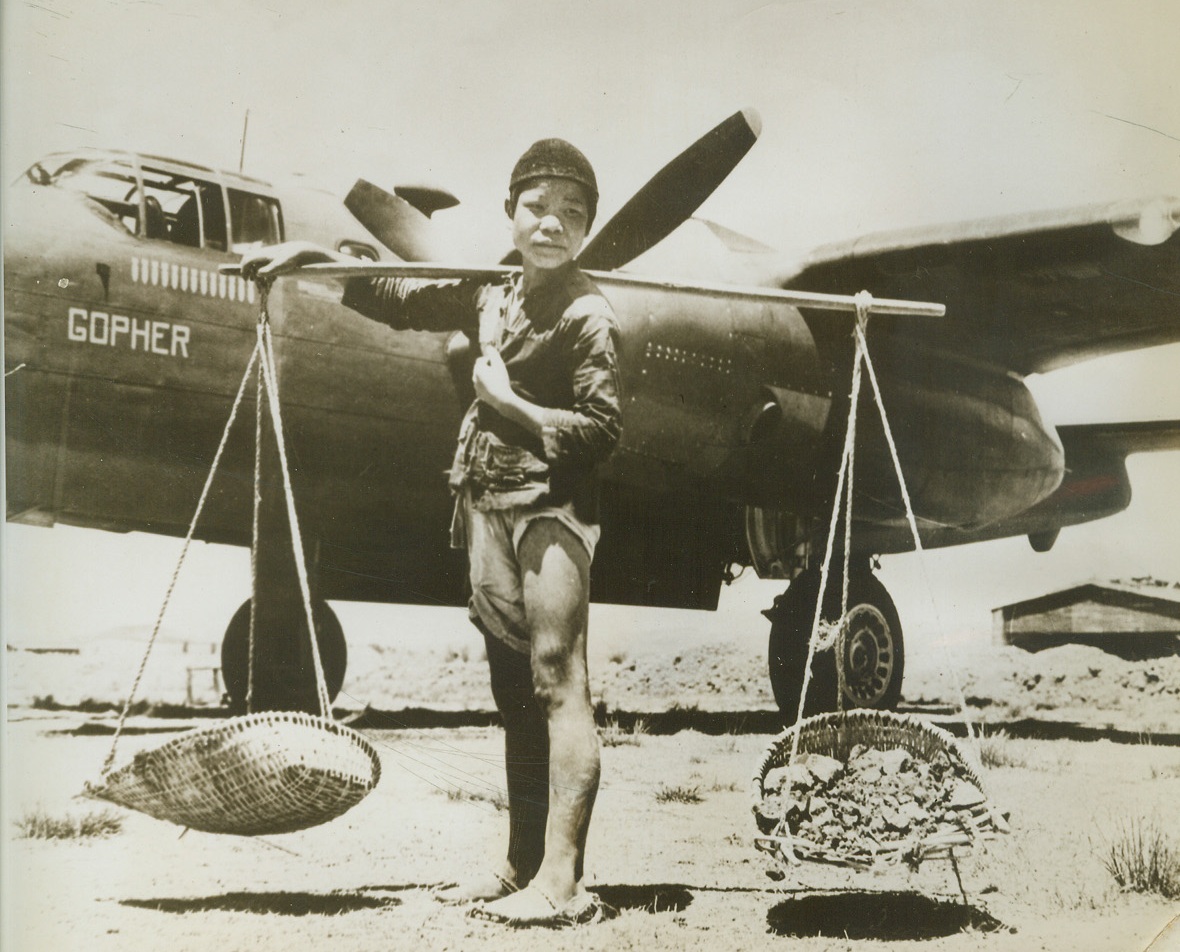
CHINESE BOY HELPS BUILD AIRFIELD, 6/26/1943. SOMEWHERE IN CHINA—This young Chinese lad pauses in front of an American B-25 as he carts hand-crushed stones to be put into place on an airfield that is being built by Chinese men, women and children. Several underlayers of the crushed stone go into the building of the field and it is surprising how quickly the job can be done by using these simple methods.Credit: OWI PHOTO FROM ACME.;
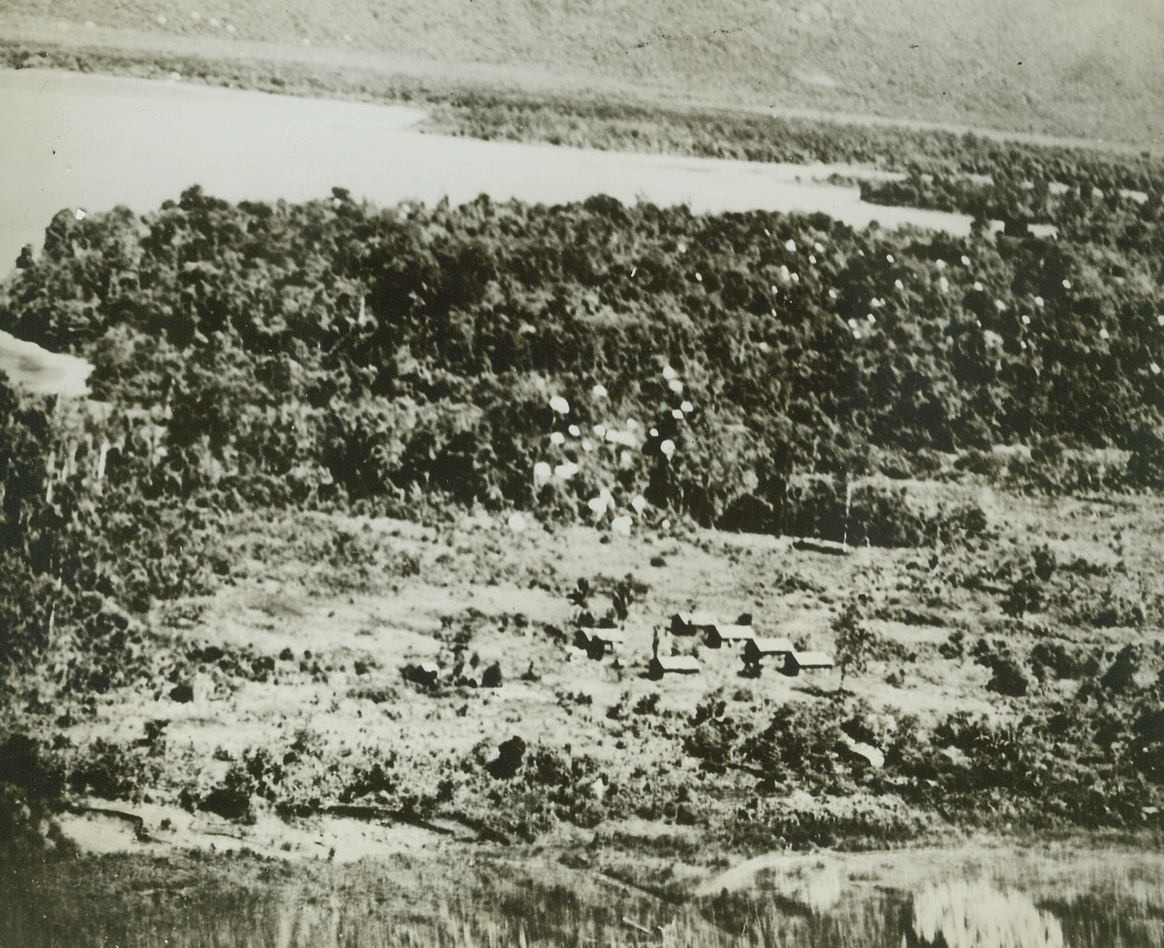
DESTRUCTION VIA PARACHUTE, 6/18/1943. NEW GUINEA—Dozens of heavy bombs float lazily of Japanese installations at Lae, New Guinea, where they were dropped via parachute by U.S. bombers. White spots in the middle right of the picture, and in upper left, show still more bombs which will explode a few feet above the ground, or upon contact, with terrific and devastating effect. This new method of sending bombs via parachute is one of the latest developments in air fighting. Its anti-personnel results are telling, since the downward force of the blast penetrates huts and foxholes and seeks out hidden enemy installations. Credit: U.S. ARMY AIR FORCE PHOTO FROM ACME.;
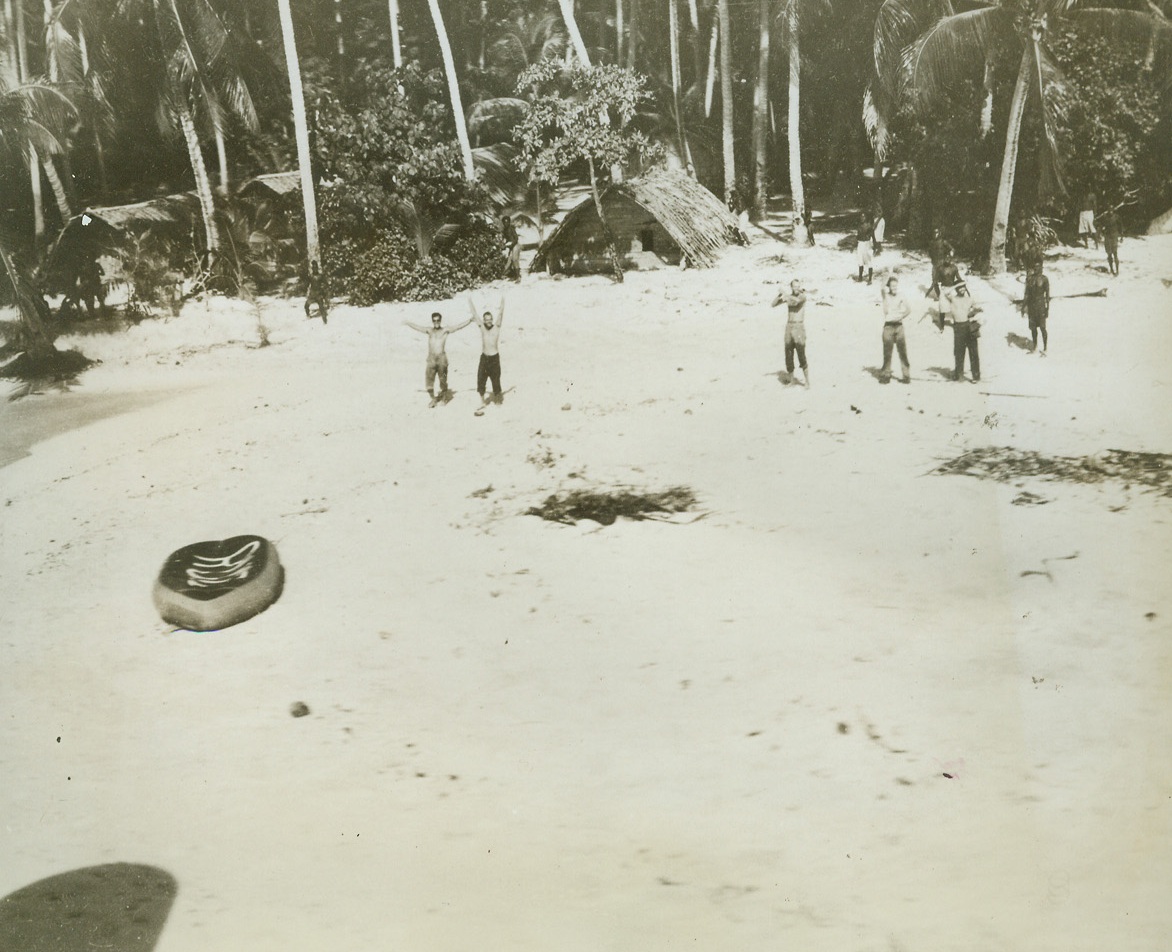
JOYOUS MOMENT, 6/19/1943. SOMEWHERE IN THE SOUTH PACIFIC—After being marooned on this island for 66 days, members of a B-17 crew leap and wave for joy as their long-awaited rescue plane flies overhead. A moment before photo was made, the beach was deserted as the men and natives hid while deciding whether the plane was friend or foe. Natives still hug the fringe of a palms as the men rush out. Left to right: M/Sgt. Donald O. Martin of Decatur, Ill.; T/Sgt. William H. Nichols of Keiser, Ark.; T/Sgt. Robert J. Turnbell of San Antonio, Texas; First Lt. Ernest C. Ruiz of Santa Barbara, Calif. Note the fliers’ raft on beach. Shadow in lower left corner was made by rescue plane’s wing. Credit: OFFICIAL ARMY AIR FORCES PHOTO-ACME.;
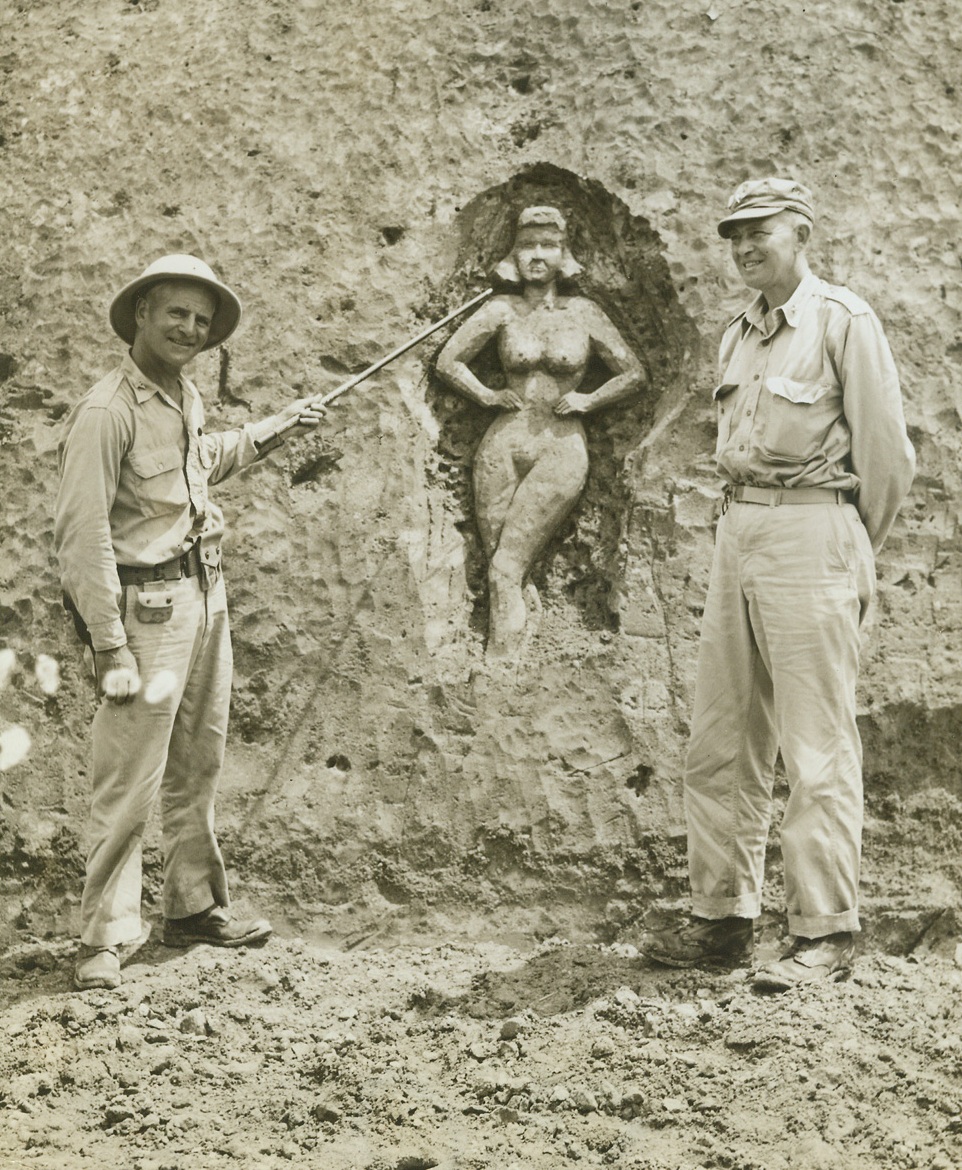
Lady In A Claybank, 6/11/1943. Somewhere in New Guinea – Tho’ building a highway across New Guinea and forced to cope with some of the world’s most difficult terrain as they found their road over jungles, mountains and swamps, American Army engineers never lost their sense of humor. Taking time out from his work, one of the Yanks carved this bit of “inspiration” for the workers out of a soft claybank. Inspecting the work of art are Colonel H.G. Lauterbach, Commander of a U.S. engineer’s unit; and Brig. Gen. Jens A. Doe (right), who commands an American unit “somewhere in New Guinea”. Credit line –WP- (ACME);

South Pacific Beauty, 6/14/1943. Southwest Pacific – Pfc Stanley Seaman, New Britain, Conn. (left) and Corp. Dean Thirkill, Los Angeles, Calif., are doing a repair job on the ignition system on one of the bombers that is flown daily over Jap bases in the Southwest Pacific area. But the boys pause in their work to admire the provocative picture painted on the side of the plane. Note sign, “fire extinguisher,” on side under the decoration. Credit line –WP- (ACME;
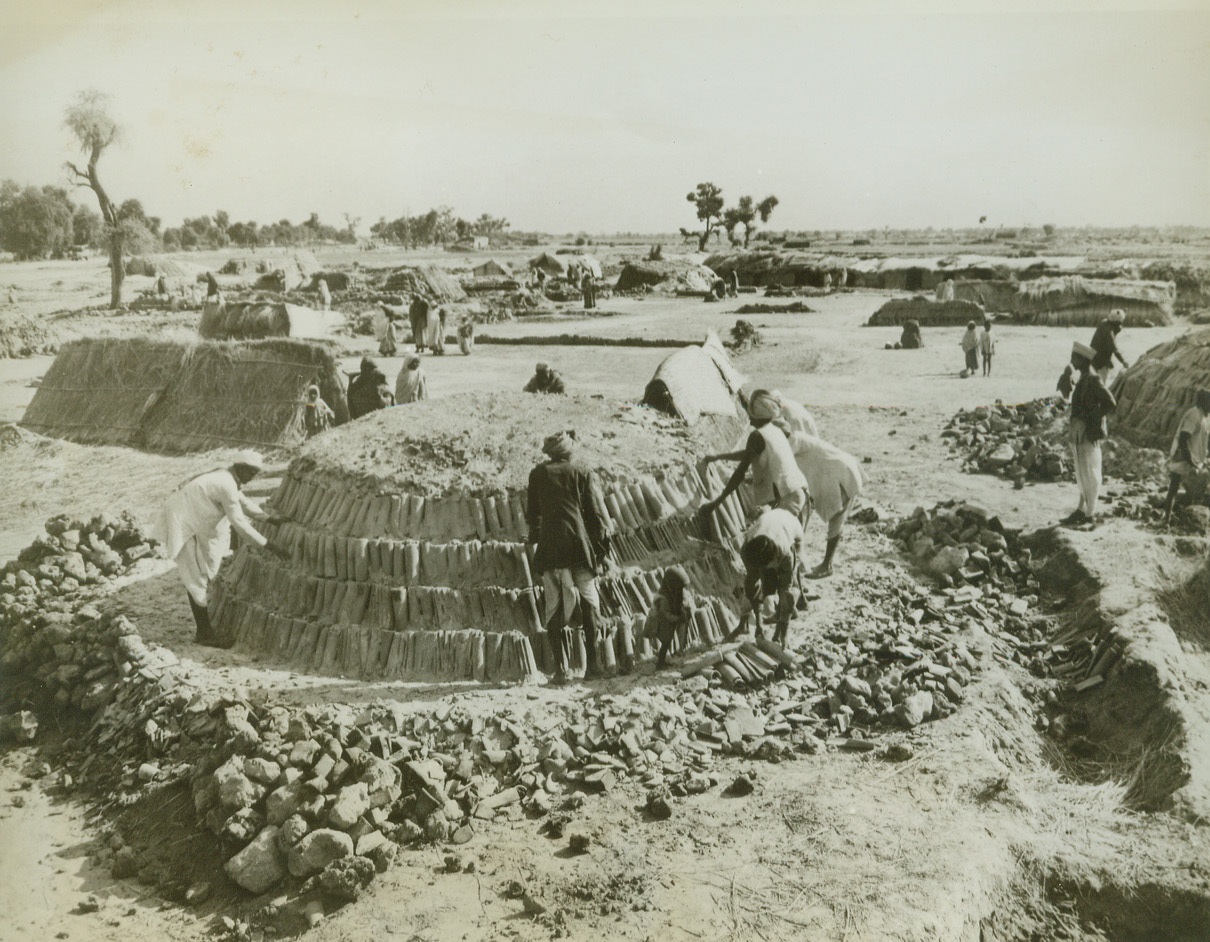
They Help Build a U.S. Airfield, 6/7/1943. India – Here is one of the villages that has been settled near a U.S. air depot for the duration of its construction by Indian workers. They are tile makers who squatted down in a corner near the end of a taxi ramp. They did their own clay, draw their own water and with dried grass and cow dung cakes mold and fire the roof tiles for all the barracks and outbuildings that are being constructed under a reverse lend-lease arrangement. The tiles are fired in the round piles. The flat floor in the village center is where the tiles are formed out of raw clay and dried in the sun. Workers and their families live in the grass huts on the edge of the village. Credit line – WP – (ACME);
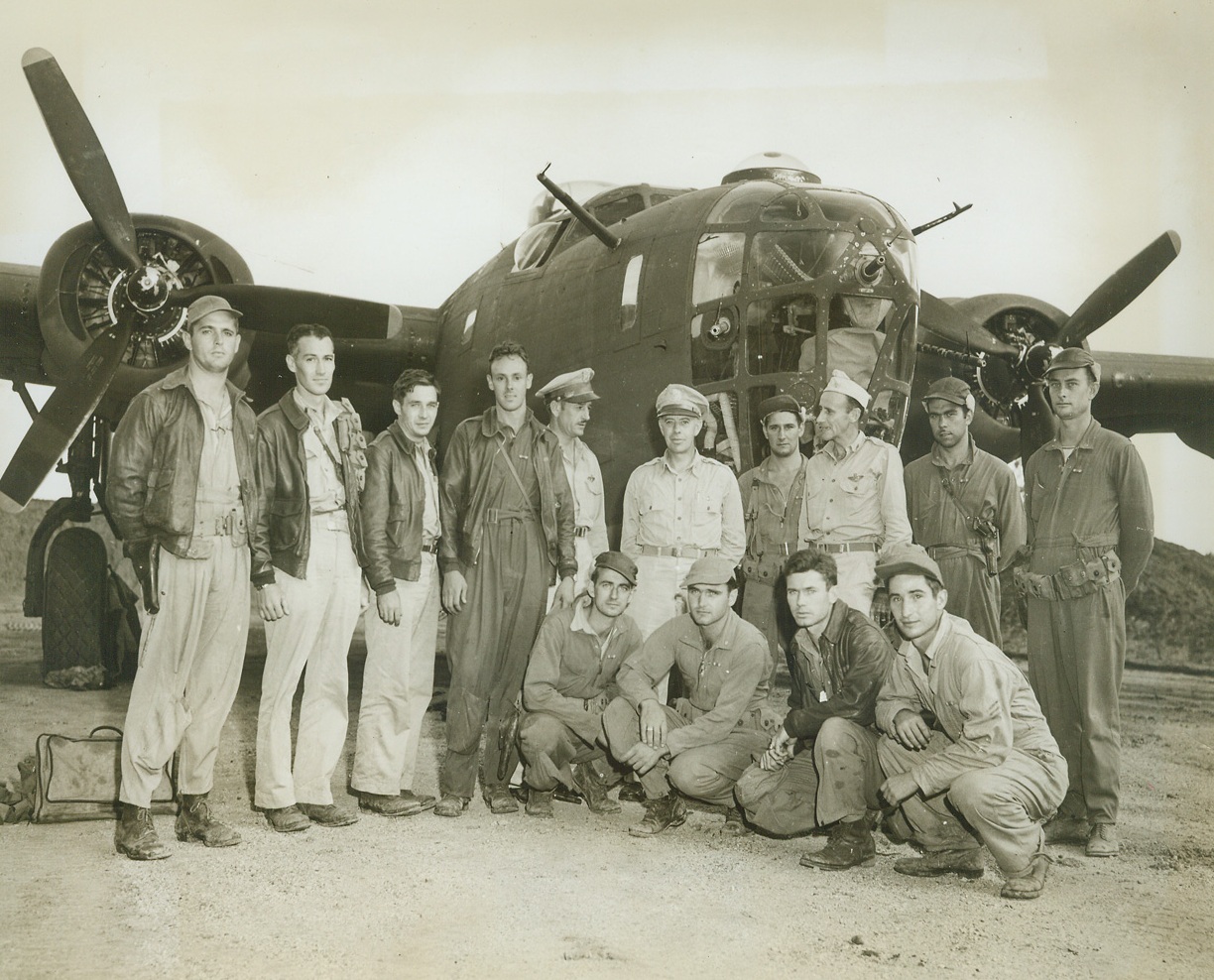
Speedy Awards, 6/6/1943. New Guinea – As U.S. fliers stepped out of their bomber on their return from blasting an 8,000-ton enemy transport, they were met by General George C. Kenney, Commander of allied Air Forces in the Southwest Pacific, who decorated them with air medals immediately. Right after the awards were made, in New Guinea, General Kenney posed with the heroic crew of the B-24 bomber. (left to right, standing): 2nd Lt. John H. Sturgeon, pilot, Lexington, Ky.; 2nd Lt. Thomas C. Hanzel, copilot, Mankato, Minn.; 2nd Lt. Bernard W. Rapasky, navigator, Elizabeth, N.J.; 2nd Lt. William A. Woods, bombardier, Louisa, Ky.; Col. Roger M. Ramey (not crew member), Commander of the 5th Airforce; Lt. Gen. George C. Kenney; Staff Sgt. Edward A. Coppins, gunner, Detroit, Mich.; Colonel Ralph L. Koon, (not crew member), Commander of the 90th bomb group; Staff Sgt. Thomas C. Clonch, gunner, Dixie, W. Va.; Staff Sgt. Earl S. Sasser, gunner, Mount Olive, N.C.; (left to right, kneeling) Sgt. E.W. Palmer, weather observer, Elmira, N.Y.; Tech Sgt. E.J. Thompson, radio operator, Coeur D. Alene, Idaho; Tech Sgt. Samuel E. Swift, engineer, Chicago, Ill., and Sgt. J.A. Botteau, photographer, Southbridge, Mass. Credit line –WP- (ACME);
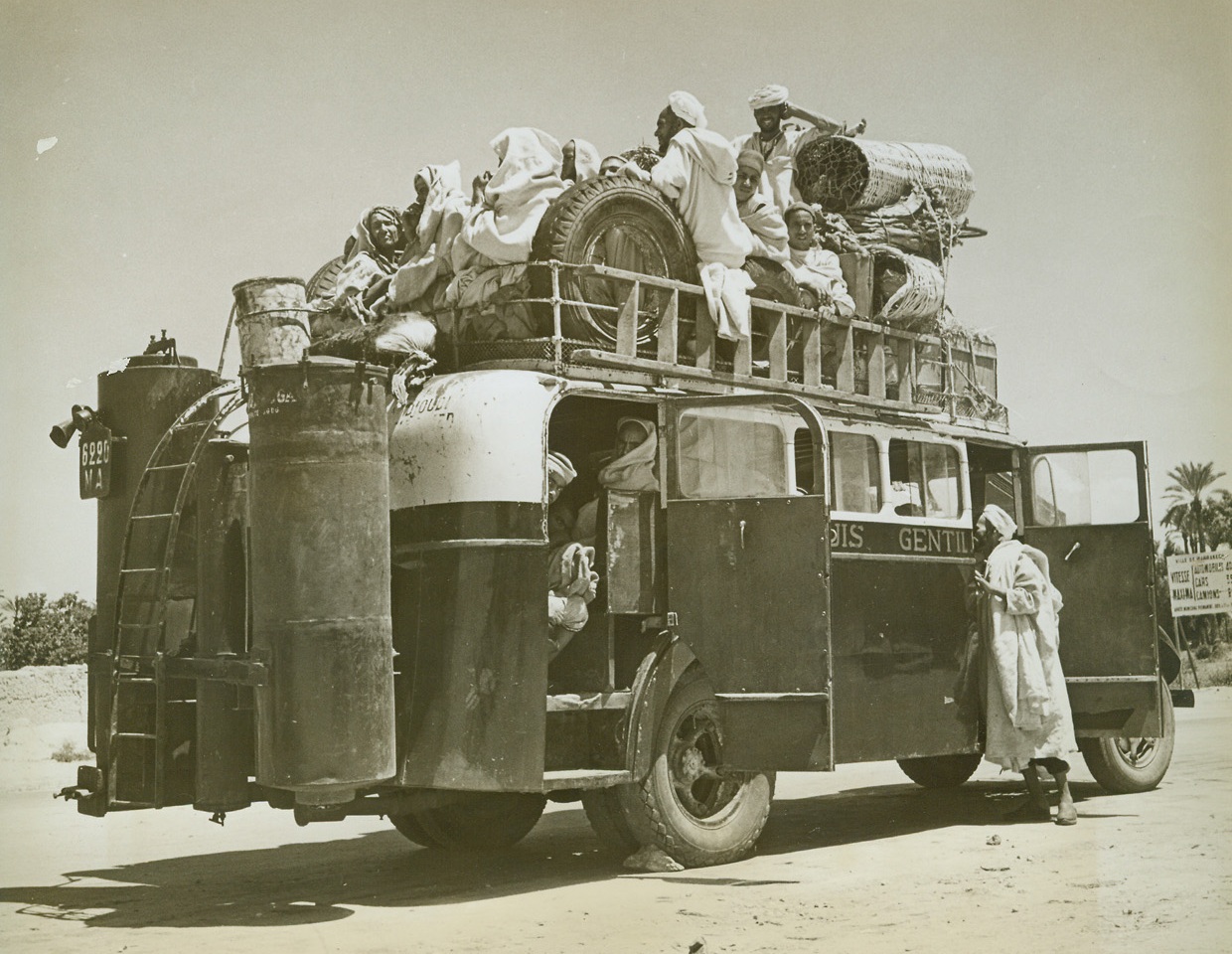
Up and Over, 6/4/1943. French Morocco - - Topside and below deck, natives of Marrakech crowd the bus that travels the main highway. Their belongings, too, take up a large share of the space on the strange vehicle that furnishes transportation on the outskirts of the French Moroccan town.Credit line – WP – (ACME;
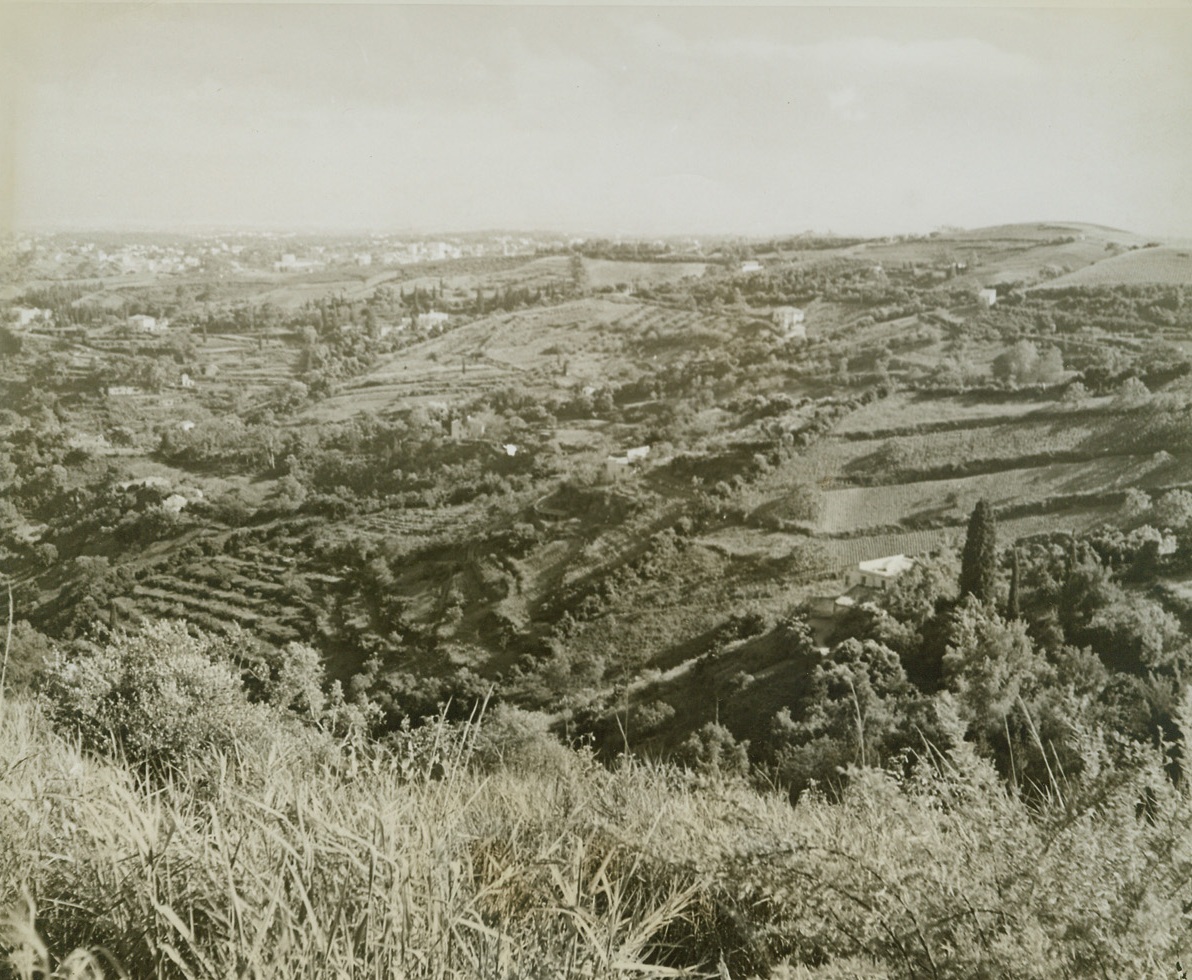
Algerian Farmland, 6/2/1943. Algeria – These Algerian farms, scattered slipshoddily over the countryside, are typical of the lands on which the Arabs grow their foodstuffs. The hilly terrain on the outskirts of Algiers affords practically no space for flat farmland. In the distance at upper left the white buildings of Algiers can be seen.Credit line – WP – (ACME);
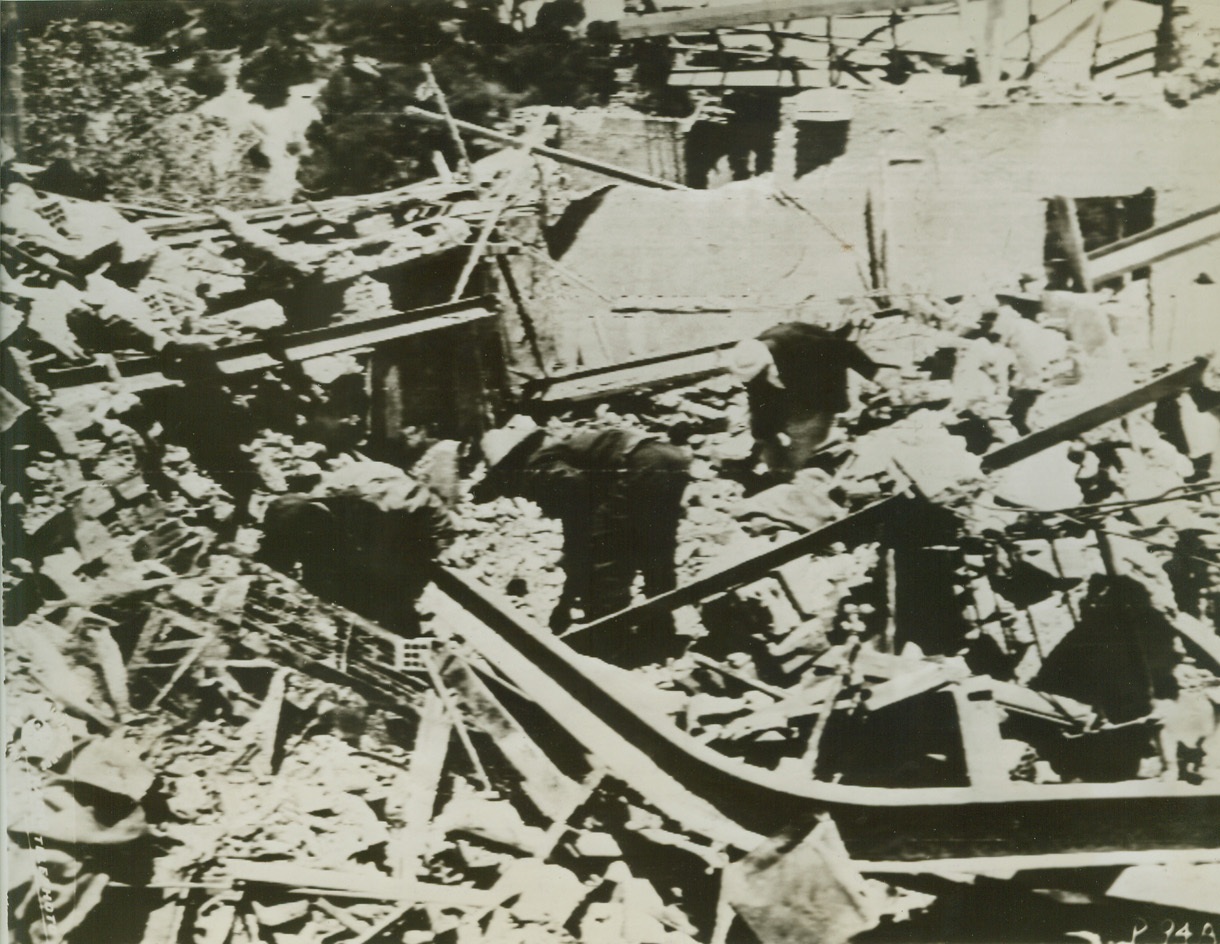
Axis Bomb Damage in Algiers, 6/7/1943. Algiers – Residents dig in the ruins of their homes, trying to salvage some few belongings after axis raiders blasted the residential area of the city, recently.Credit line (ACME photo via U.S. Signal Corps);
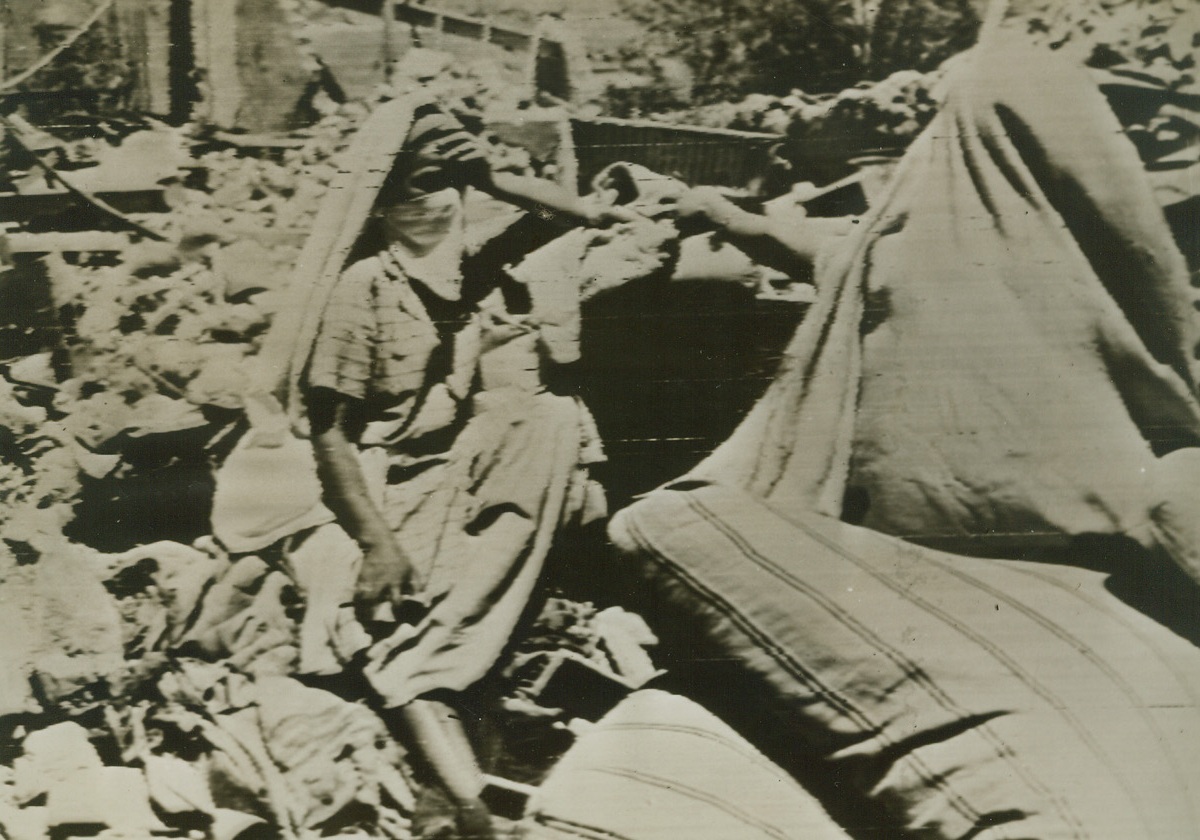
Left Homeless By Axis Bombs, 6/7/1943. Algiers – In deep sorrow, this Algerian woman sits amidst the ruins of her home, after axis raiders had blasted the residential section of the city recently.Credit line (ACME photo via U.S. Signal Corps);

White Man’s Ju-Ju, 6/1/1943. North Africa – A modern witch doctor in North Africa replaces his traditional mask with a model US airplane, the B-40, which he built complete with antenna and U.S. Star Bushmen call the plane the “steam chicken.” For hundreds of years the medicine men held to tribal masks passed down from generation to generation. Now, supplanting the traditional mask with the stronger Ju-Ju of the white man the medicine men descend on tribes in flying echelon as the evil sprits of the Nazis are driven out of Black Men’s territory.Credit line (Official photo from ACME);
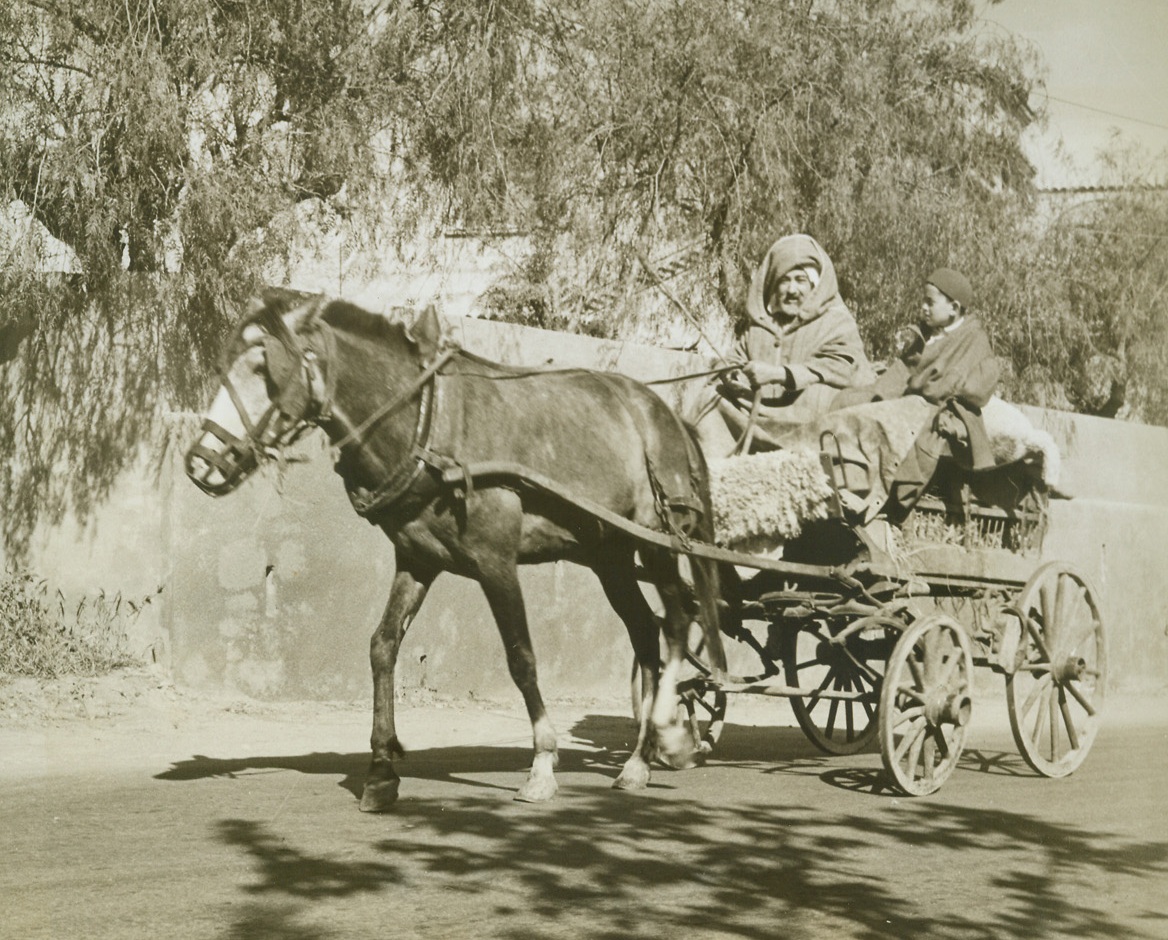
No Transportation Troubles Here, 6/2/1943. Algeria - - Untroubled by wartime gas rationing, this Arab uses his customary means of transportation to get to the hills of Algiers. This tiny, mule-drawn cart is a common sight in the streets and country roads of the North African city.Credit line – WP – (ACME);
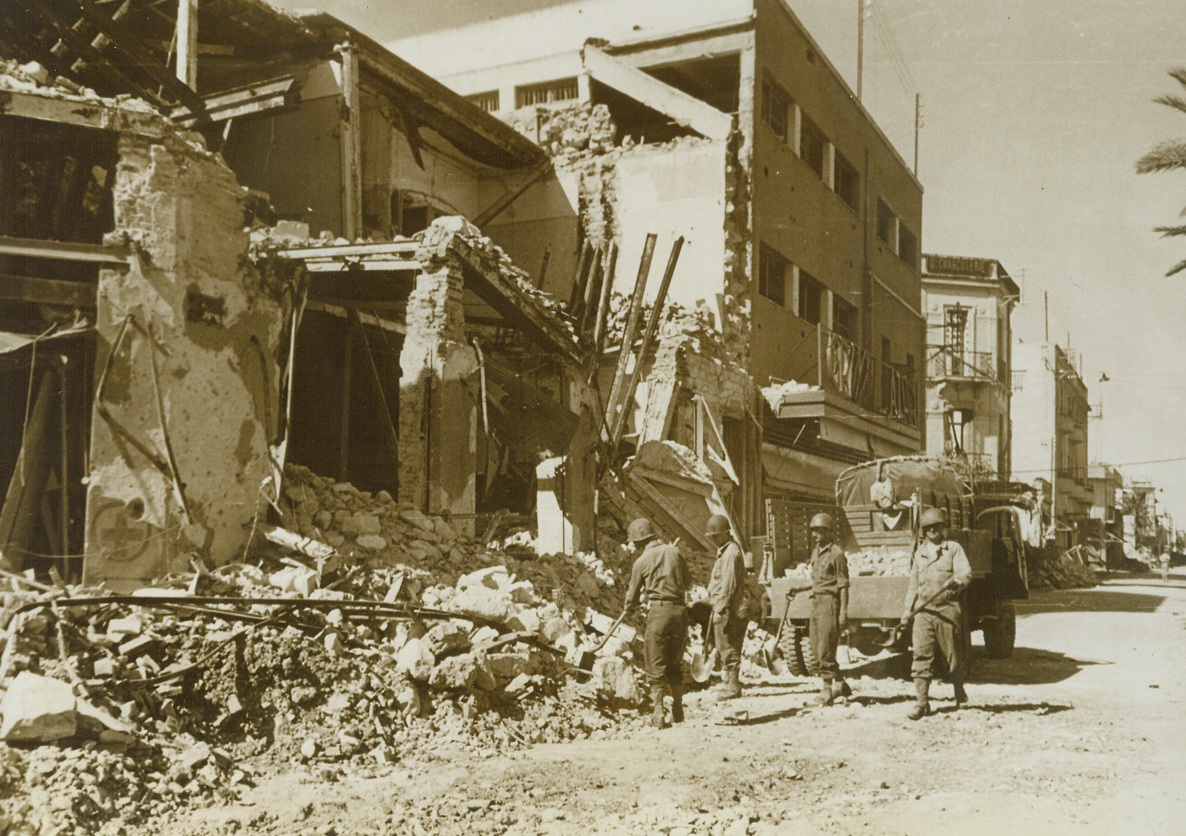
Clearing Up Bizerte, 6/5/1943. Tunisia – Armed with shovels, American engineers go about the important task of clearing rubble from the streets of Bizerte in the aftermath of allied victory. Buildings were ruined in the bombings that helped force the axis retreat and final defeat in Tunisia. Credit line – WP – (ACME);
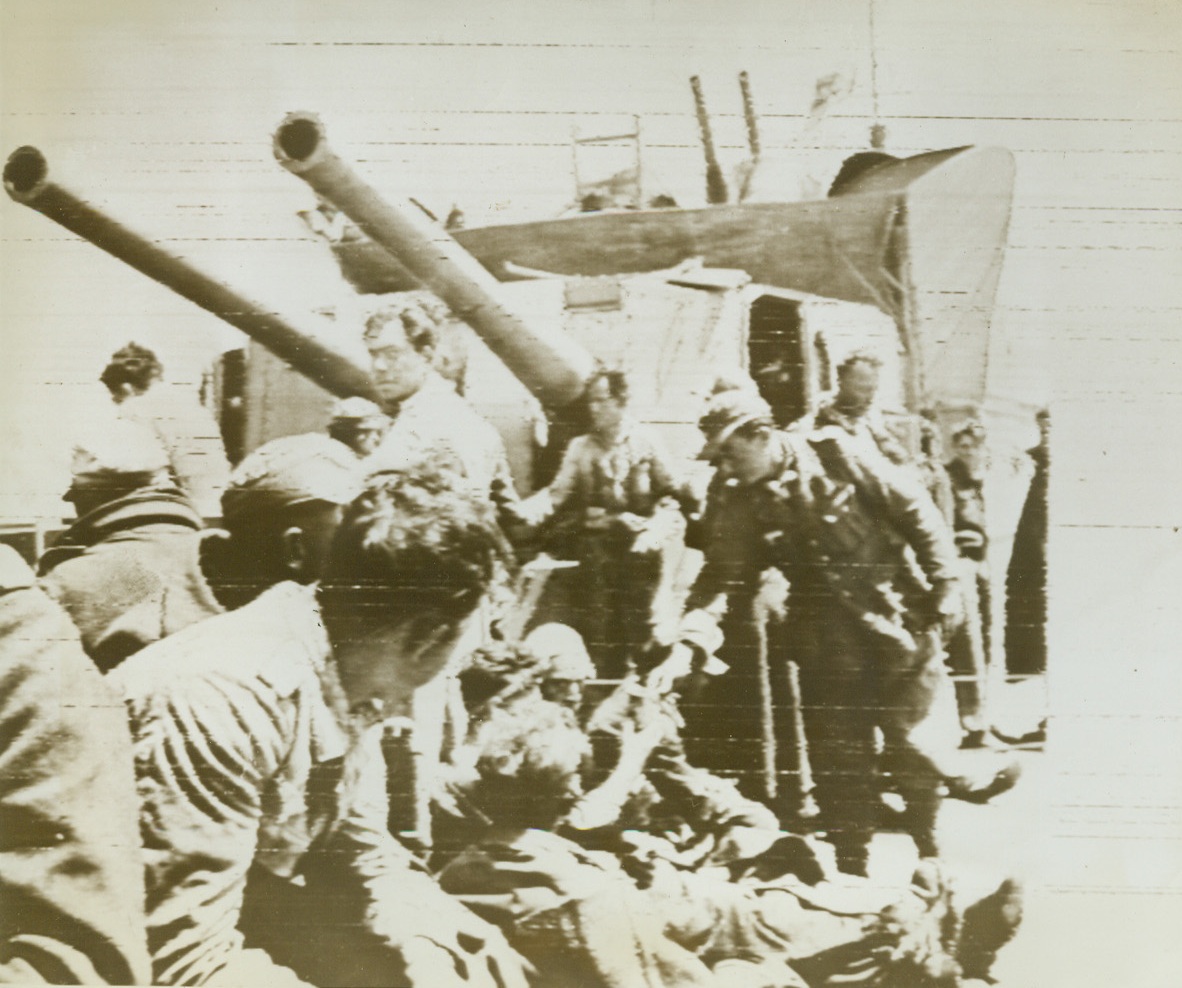
Nazis Fed Under Warning Guns, 6/1/1943. A group of Nazis who attempted to flee Tunisia via water are fed under the guns of the allied naval vessel responsible for their capture. Hundreds of Germans attempted to flee the scene of their defeat in North Africa, constructing makeshift rafts; patching up small boats in vain. After rounding up and feeding them, allied naval forces transferred them to barges to be taken back to Tunisia as prisoners of war. Credit (U.S. Army Signal Corps radio telephoto);
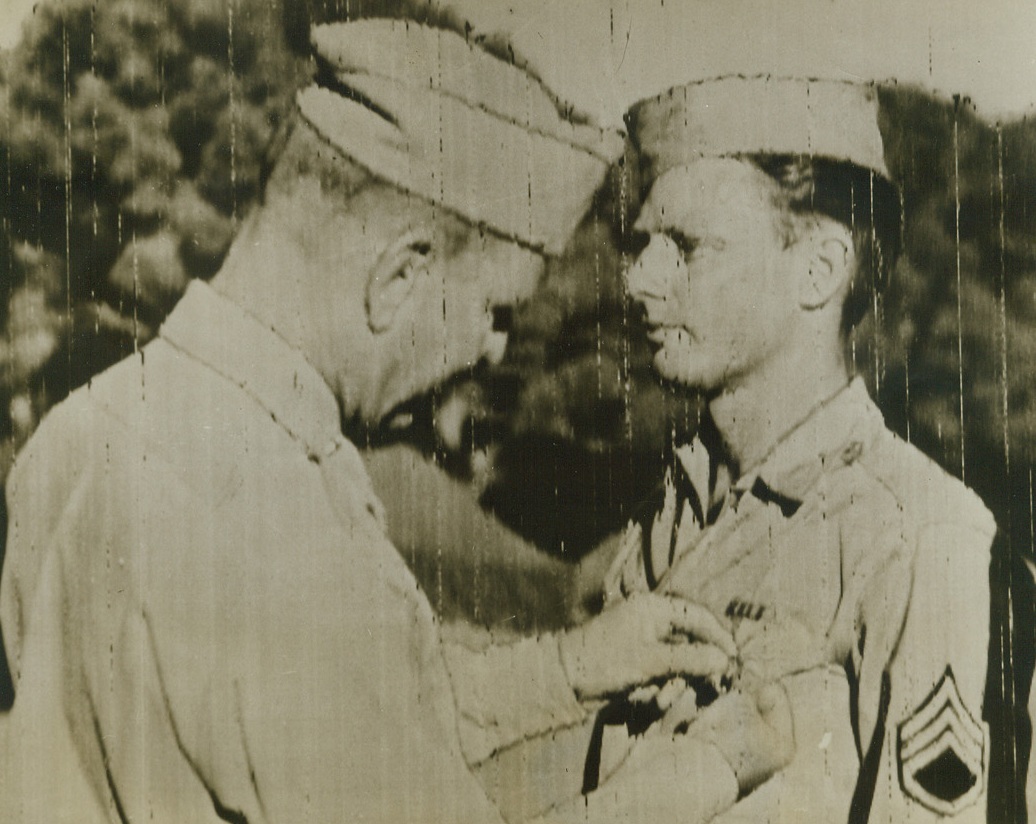
Army Photographer’s Heroism Recognized, 6/30/1943. North Africa: - The first U.S. Army Signal Corps enlisted man to be awarded the Silver Star in North Africa was Staff Sergt. Lorenzo Alcock, of Los Angeles, Calif. (right), who receives the decoration from Brig. Gen. J.V. Matejka, Chief Signal Officer. Sergeant Alcock, an Army pictorial service cameraman, received the award for bravery under fire with utter disregard for his own personal safety while photographing the action during the landing operations in the African invasion. Credit (U.S.Army Signal corps radio telephoto from ACME);

English Hotel Hit in Nazi Nuisance Raid, 6/3/1943. ENGLAND -- Soldiers and civilian defense workers search the wreckage of a hotel in a south coast English town, hit in a recent nuisance raid by Nazi planes. Stores, hotels and a cinema were hit in the raid. In this hotel, (above), there were several casualties. Credit: (ACME);
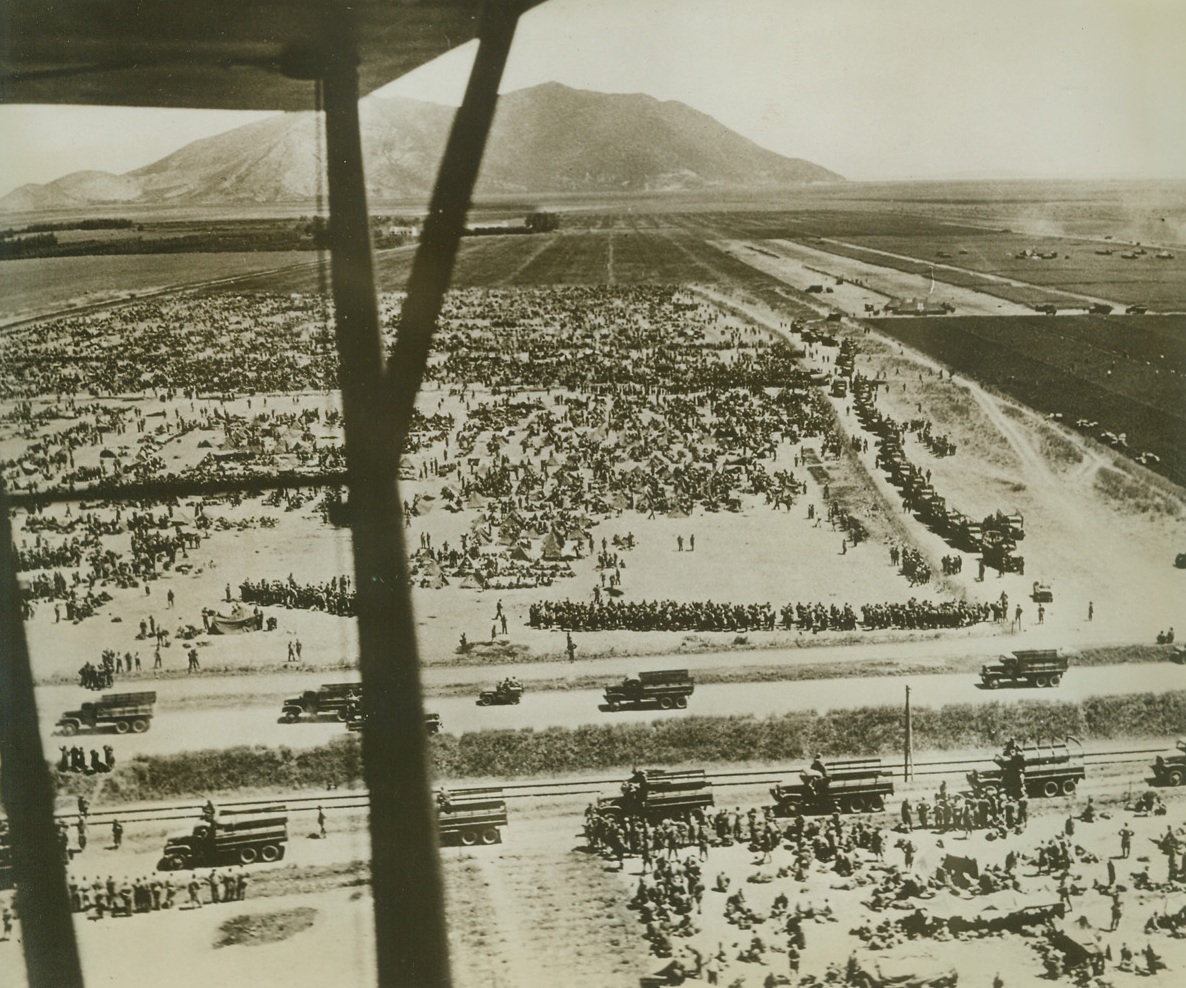
The Song is Ended, 6/10/1943. Tunisia—Their song of Axis supremacy ended, these German and Italian prisoners, captured in Northern Tunisia, are herded together on hill 609, where some of the bitterest fighting of the Tunisian campaign occurred. Tho’ the melody lingers faintly on other fronts, these “supermen” are aware that Hitler’s war song is nearing its end. Credit: Official U.S. Army photo from ACME.;
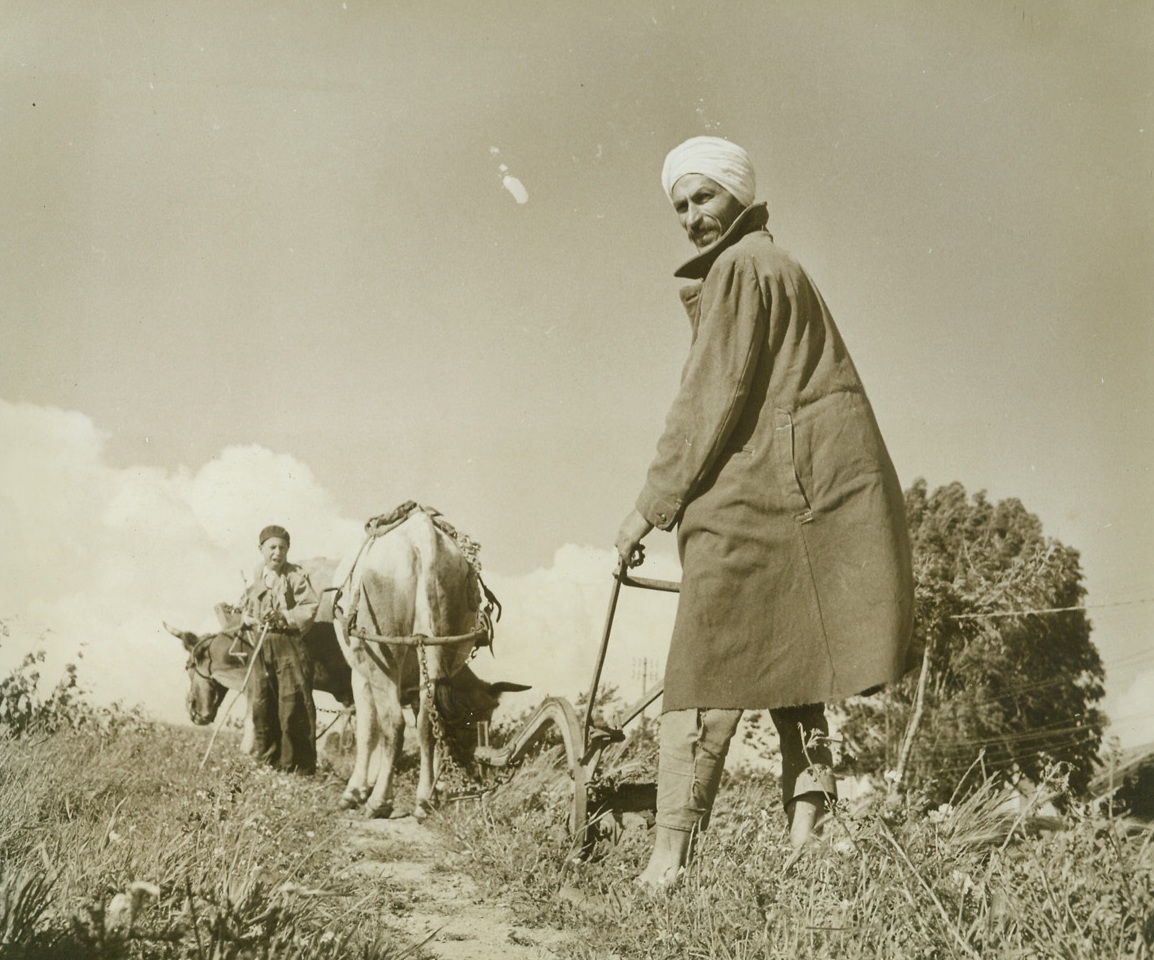
Ploughing Algerian Fields, 6/2/1943. Algeria—His head wrapped for protection from the hot sun, this Algerian farmer stands behind his old fashioned plough, drawn by a team of oxen, on a hilltop on the outskirts of Algiers. Ahead of him, a small boy drives the team across the high, sandy slope. Passed by Army censors. Credit: ACME;
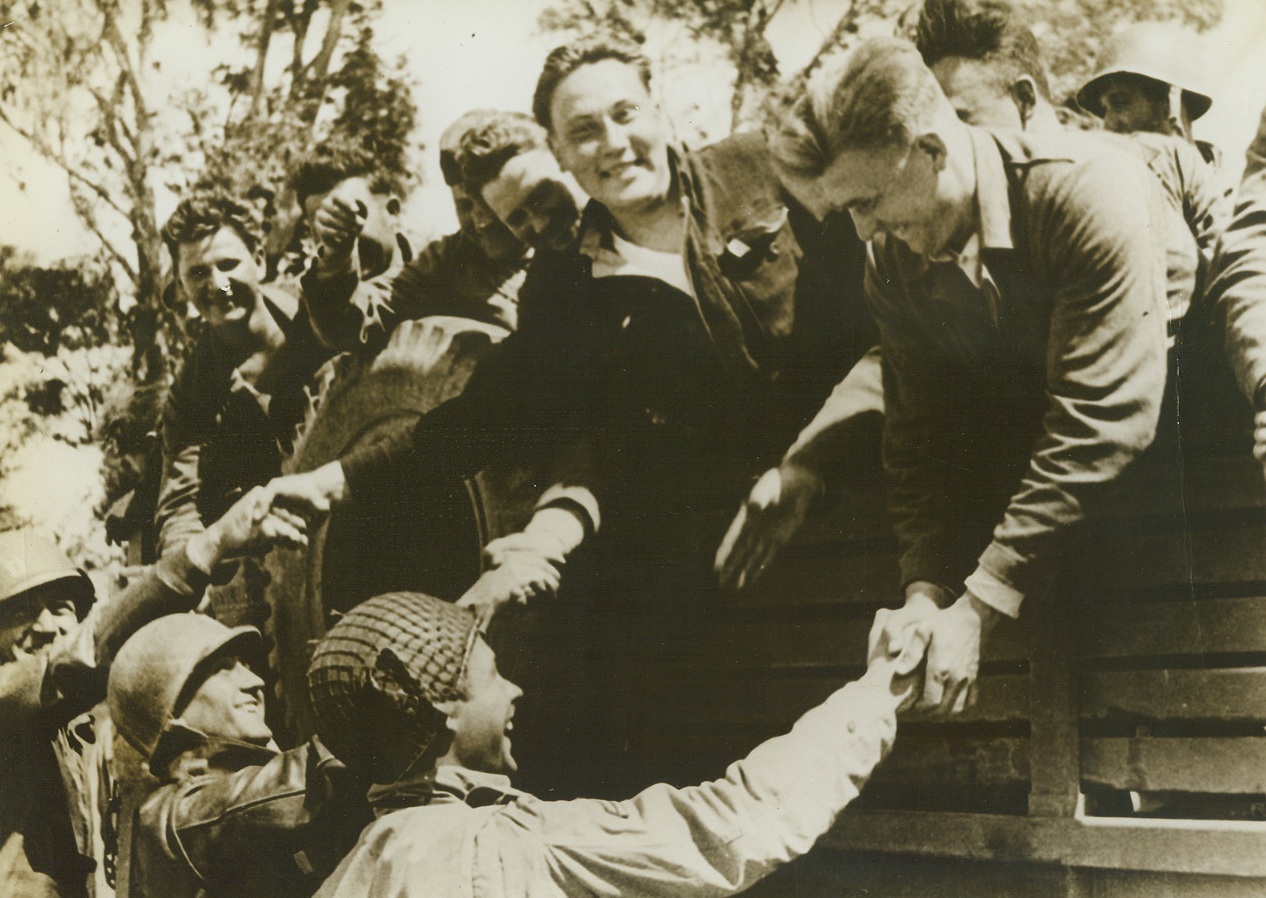
Back in the Fight, 6/16/1943. Joyously bidding their American buddies farewell, these Soviet soldiers are heading back to their homeland to fight the Nazis once again under the Red Star of Russia. Captured on the Soviet front, they were sent to Axis prison camps in North Africa, from which they were freed when the Allies took over their territory. Credit: Official OWI photo from ACME.;
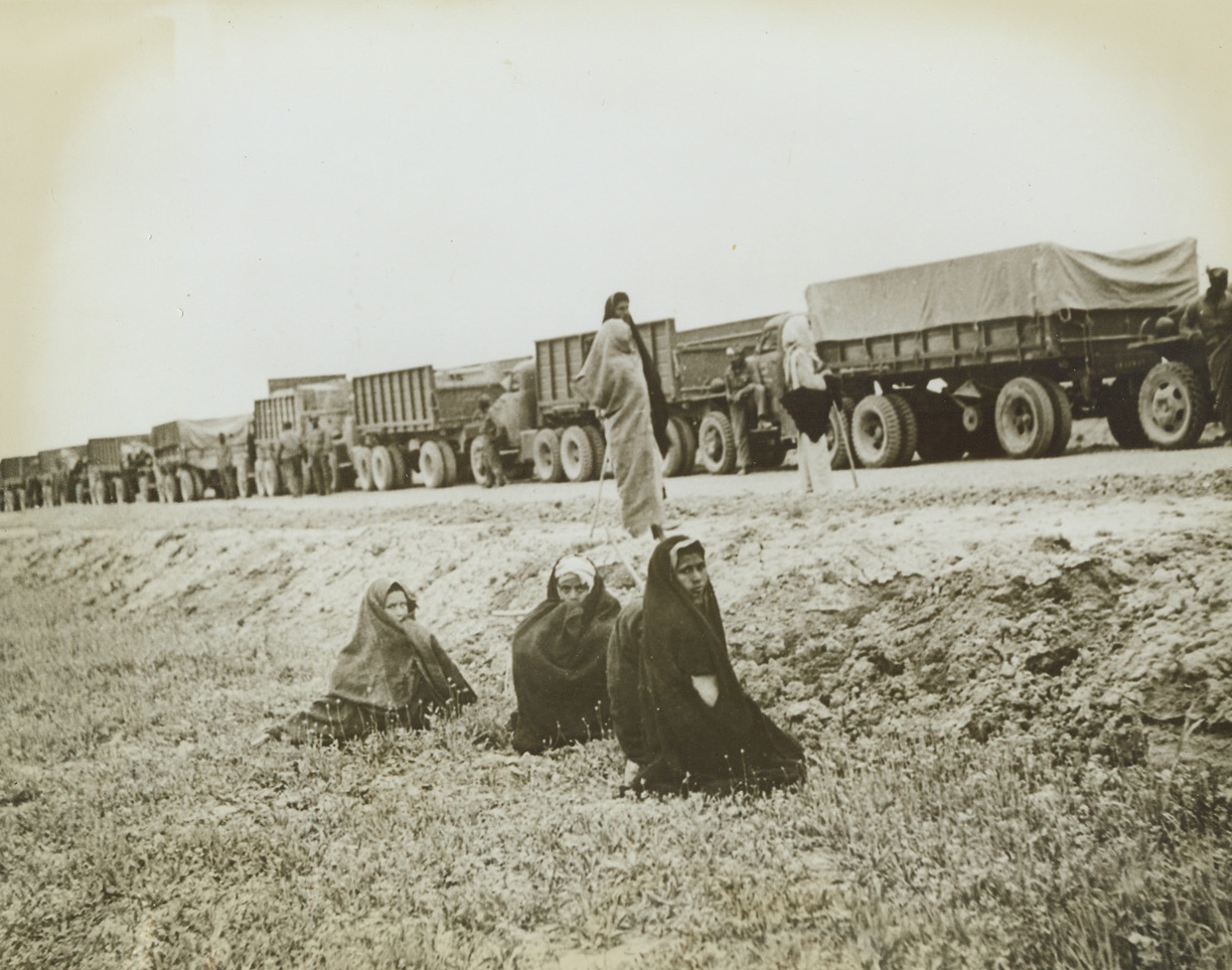
Heading for Russia, 6/4/1943. Native Iranian boys turn away from a long convoy of supplies enroute to Russia just long enough to have their pictures snapped. The United States truck train is making a rest stop somewhere in the Persian Corridor, and the sight thrills the natives. Credit: ACME.;
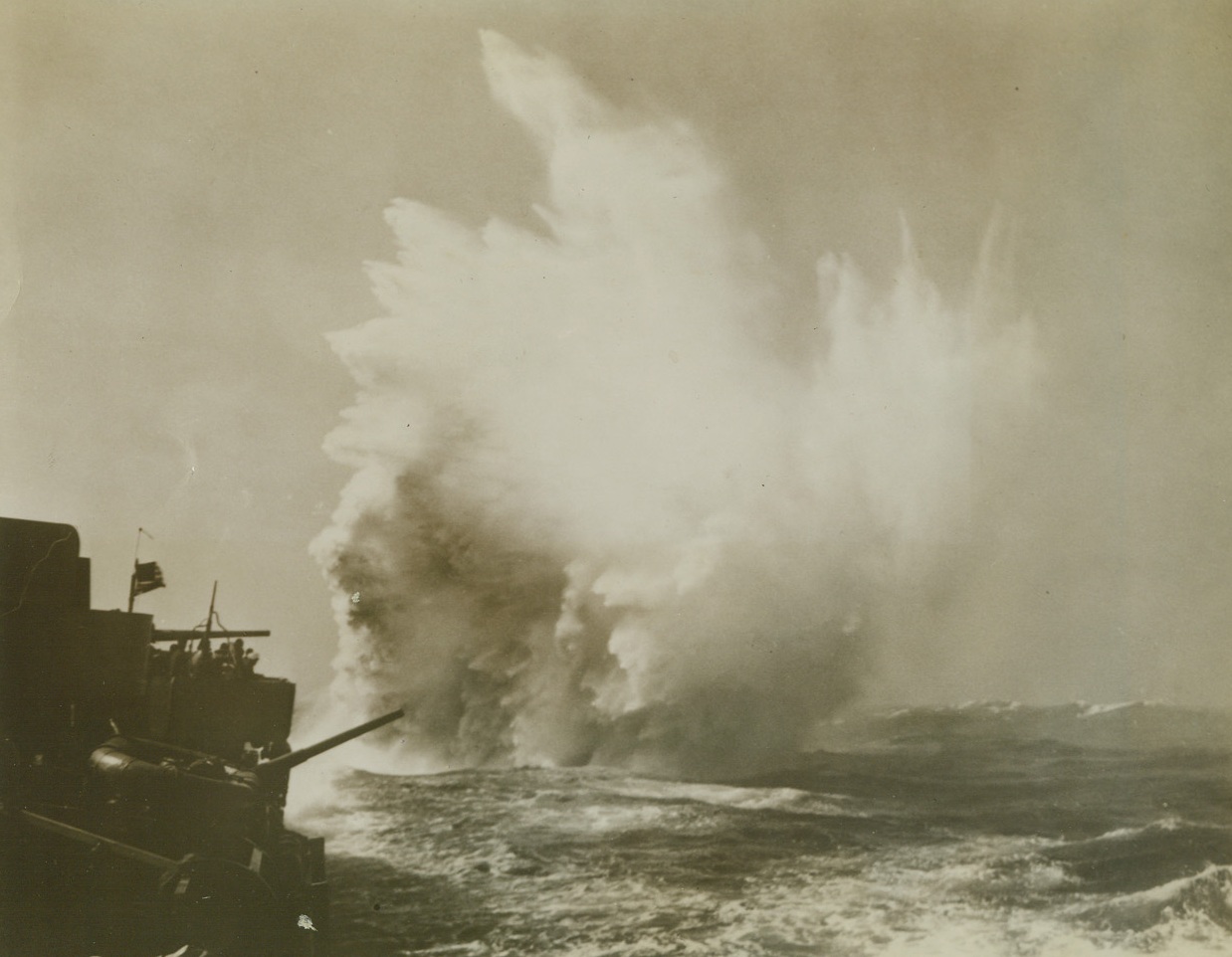
Depth Charge Chases Sub, 6/10/1943. Somewhere in the North Atlantic—A foaming geyser shoots skyward alongside an unidentified American destroyer (left) as a depth charge is sent down to chase an Axis sub away from an Africa-bound convoy. Escorting millions of tons of supplies for fighting men, battling destroyers kept losses under 2%, according to an official Navy report. Credit: Official U.S. Navy photo from ACME.;
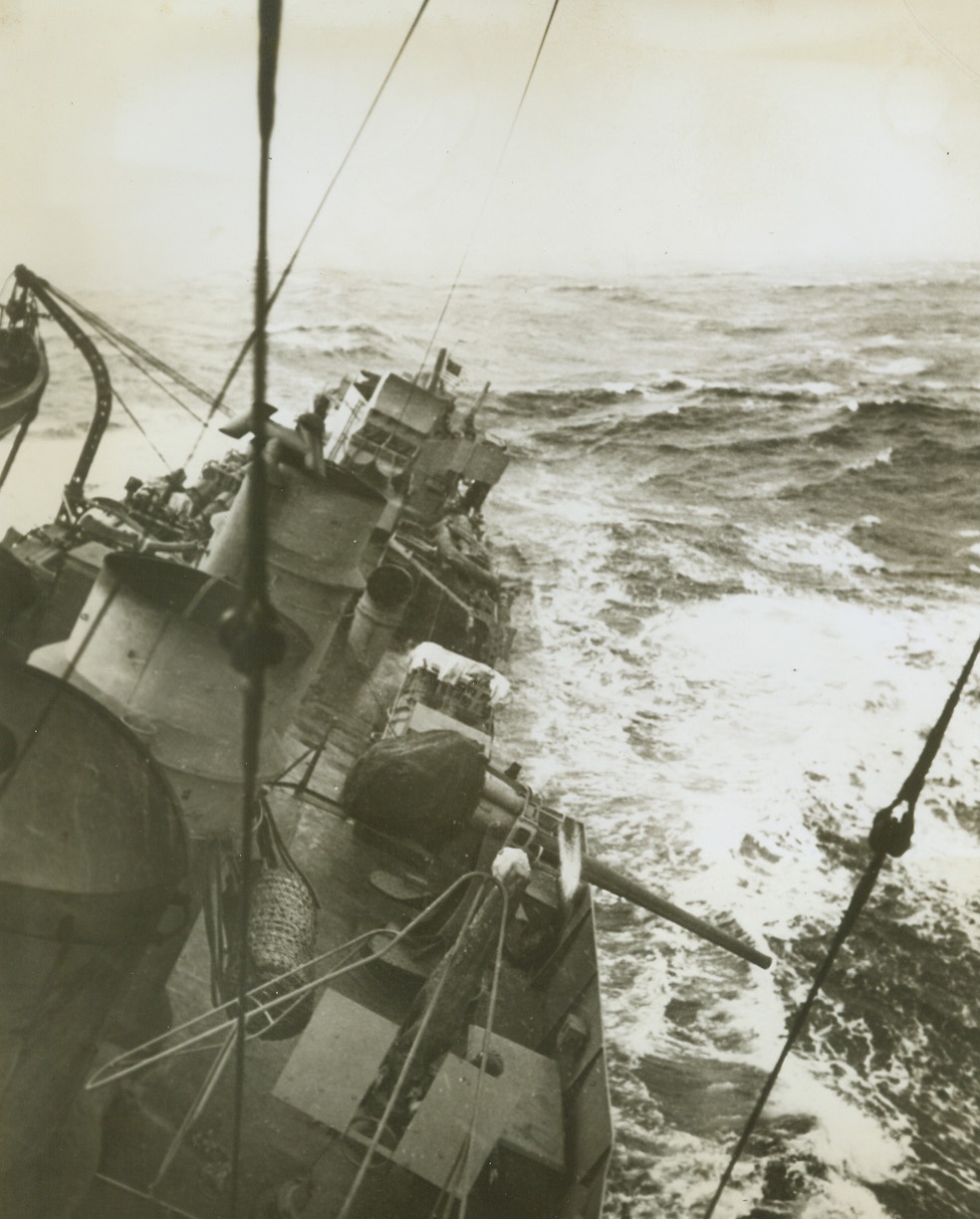
Decks Awash, 6/10/1943. Somewhere in the North Atlantic—No need to swab the decks today—for a rough sea is doing an efficient washing job on this U.S. destroyer as it makes its way across the North Atlantic in heavy weather. The naval vessel escorted a United Nations convoy through rough, sub-infested seas. Credit: Official U.S. Navy photo from ACME.;
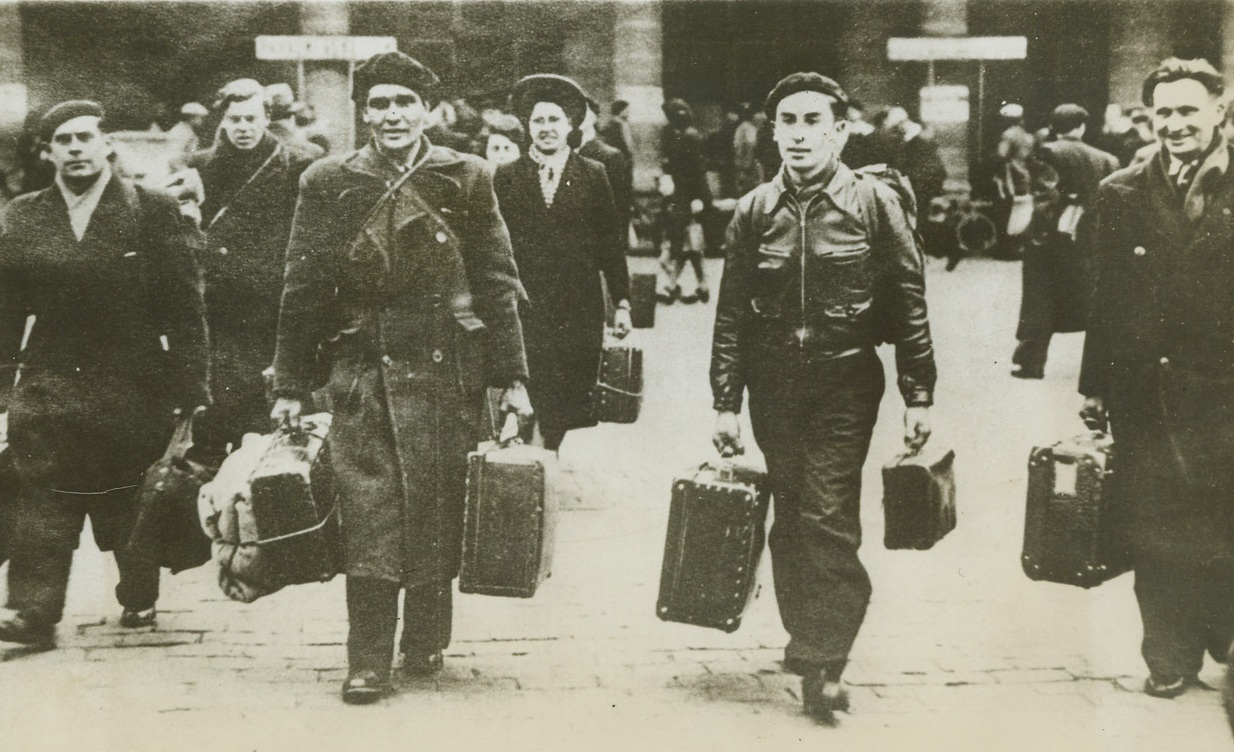
Temporary Freedom, 6/14/1943. Paris—Their bondage temporarily lifted, a group of French workers arrive in Paris on a “short leave” from their compulsory war jobs in Germany. The vacations were ordered as an inducement to other Frenchmen to work for the Nazi war effort in Germany. Laval has been unable to obtain enough slaves for Hitler, and every means is being used—unsuccessfully—to obtain volunteers. Credit: ACME.;
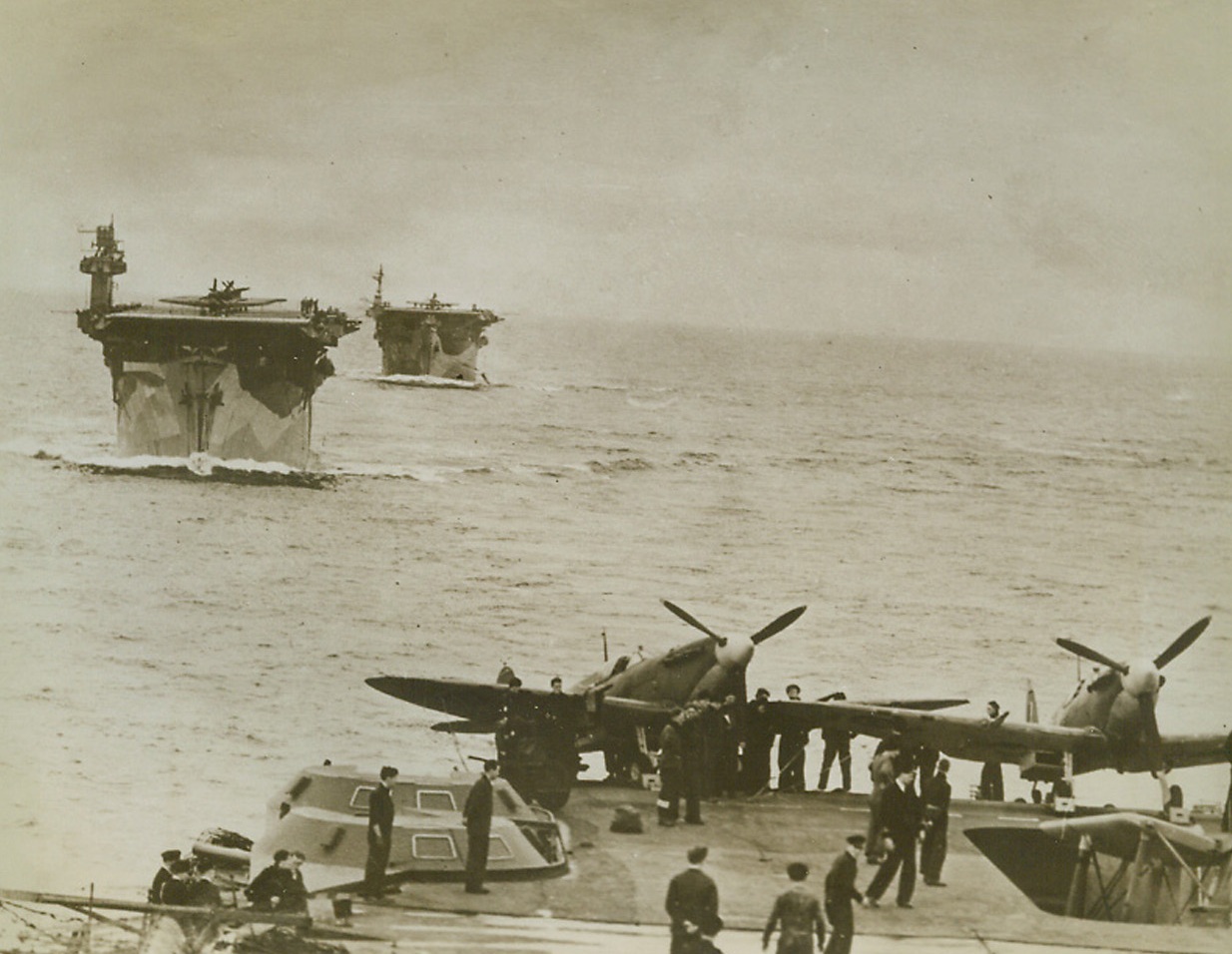
An Answer to the U-Boat Menace, 6/10/1943. Here’s one of the United Nations’ answers to Axis U-Boats that menace Allied shipping. These new type escort vessels carry planes to battle both underseas and aircraft when they attack on the high seas. Made from the deck of the (illegible word) Victorious, photo shows the (illegible word) Biter and Avenger. All three carriers offer protection that has reduced loss of convoy cargo considerably. Credit: ACME.;
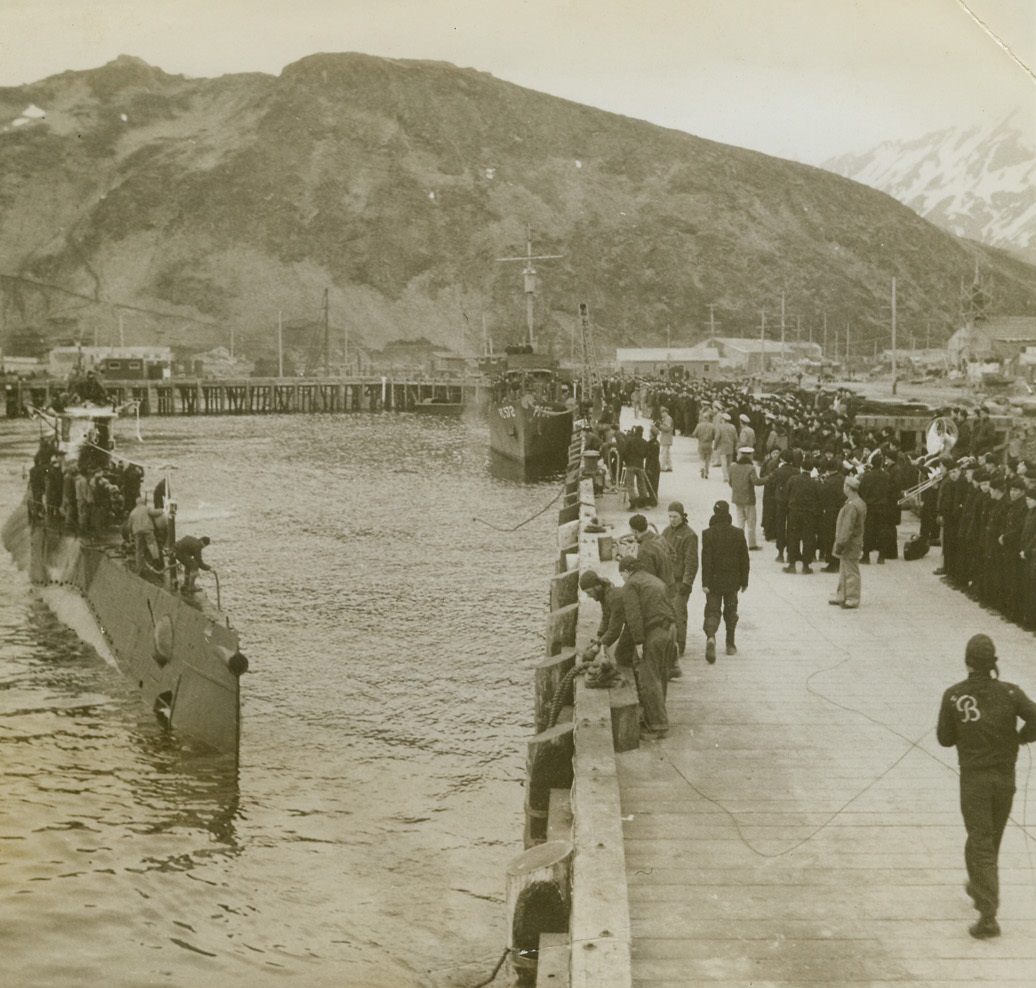
Strike Up the Band, 6/16/1943. Dutch Harbor, Alaska -- The Navy Band was right on hand to strike up a merry tune and give this American submarine a rousing welcome as she made her way into port. There was good reason for the festivities, for the overseas fighter has sent five Jap ships--two merchantmen and three men-of-war, to the bottom of the Pacific. Credit: Official U.S. Navy photo from ACME;

Modern Version of Mail Suit, 6/21/1943. England -- T/Sgt. J. W. Fawcett, of East Orange, New Jersey, and Sgt. L. Fredrick, (right), of Norwalk, Connecticut, wear armored vests--the modern version of the suit of mail of ancient knights--which are used by American airmen in the battle for control of Europe’s skies. It has been announced that the vests, made of small, overlapping squares of manganese steel built into heavy canvas covers shaped something like a baseball catcher’s chest protector, have already saved the lives of several fliers. The vest is pulled on over the head and is laced up the sides. It protects both the front and the back of the torso. The vest was developed by Col. Malcolm C. Grow, Surgeon of the 8th Air Force. Passed by censor. Credit: ACME;

Lost at Sea, 6/18/1943. The U.S. Coast Guard Cutter Escanaba, an ice-breaker on the Great Lakes in peacetime, has been reported lost in the North Atlantic where she was doing convoy duty. One of six cutters of her class, the 165-foot vessel was built in 1932 and steel-strengthened for ice breaking. All hands except two enlisted men are reported lost with the Escanaba. Credit: ACME;
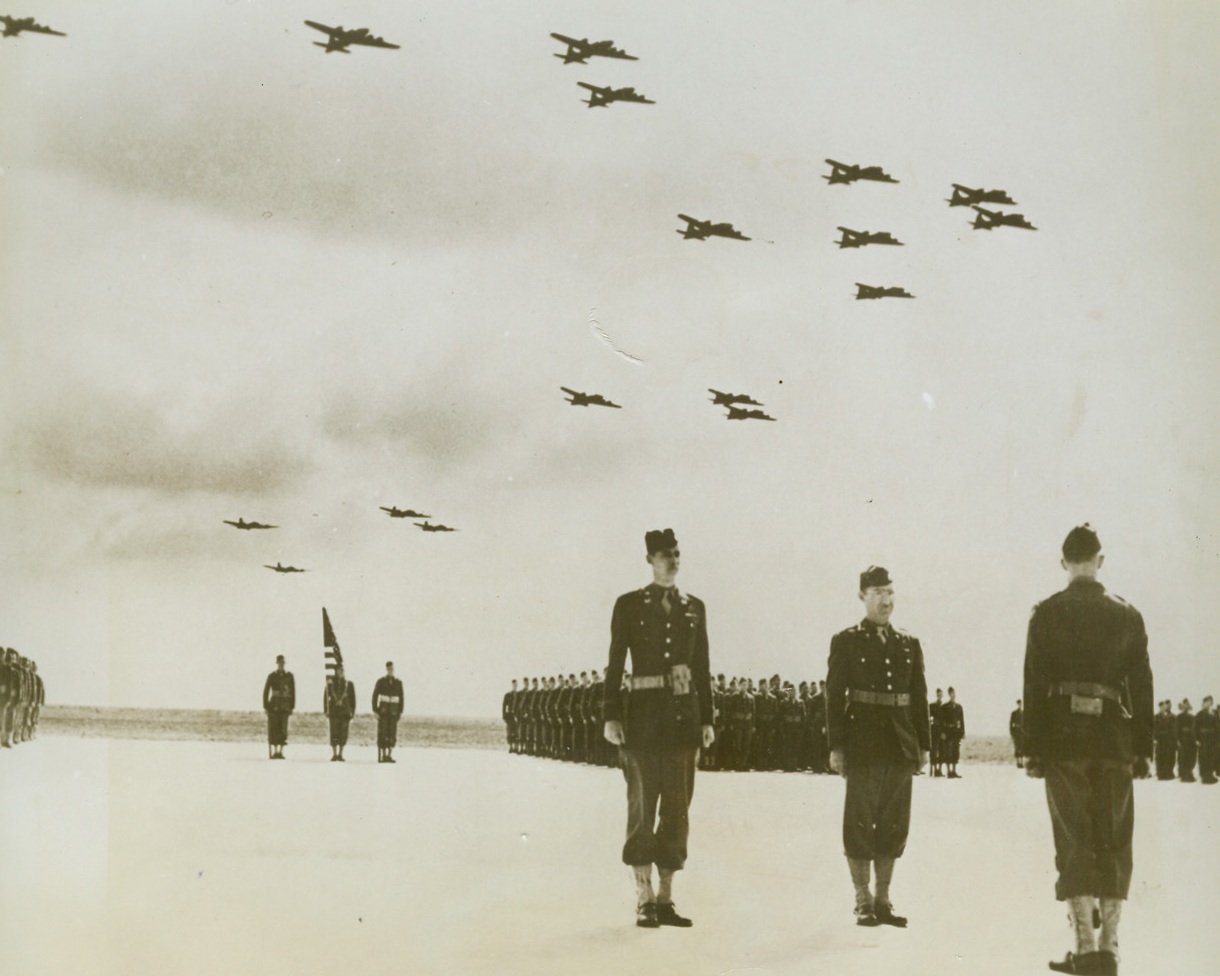
TWO YANK FIELDS IN ONE MONTH, 6/29/1943. SOMEWHERE IN ENGLAND—At ceremonies dedicating the second American-built and manned airfield completed in England during the last month, a detachment of U.S. Army Engineers stands at attention as Flying Fortresses of the U.S.A. 8th Air Force roar overhead. Brig. Gen. C.R. Woode, Harrisonburg, Va., Chief Engineer of the European Theater of Operations, turned the field over to Brig. Gen. Newton Longfellow, Minneapolis, Minn., commander of the Eighth Bomber Command, on June 17. Credit Line (ACME);
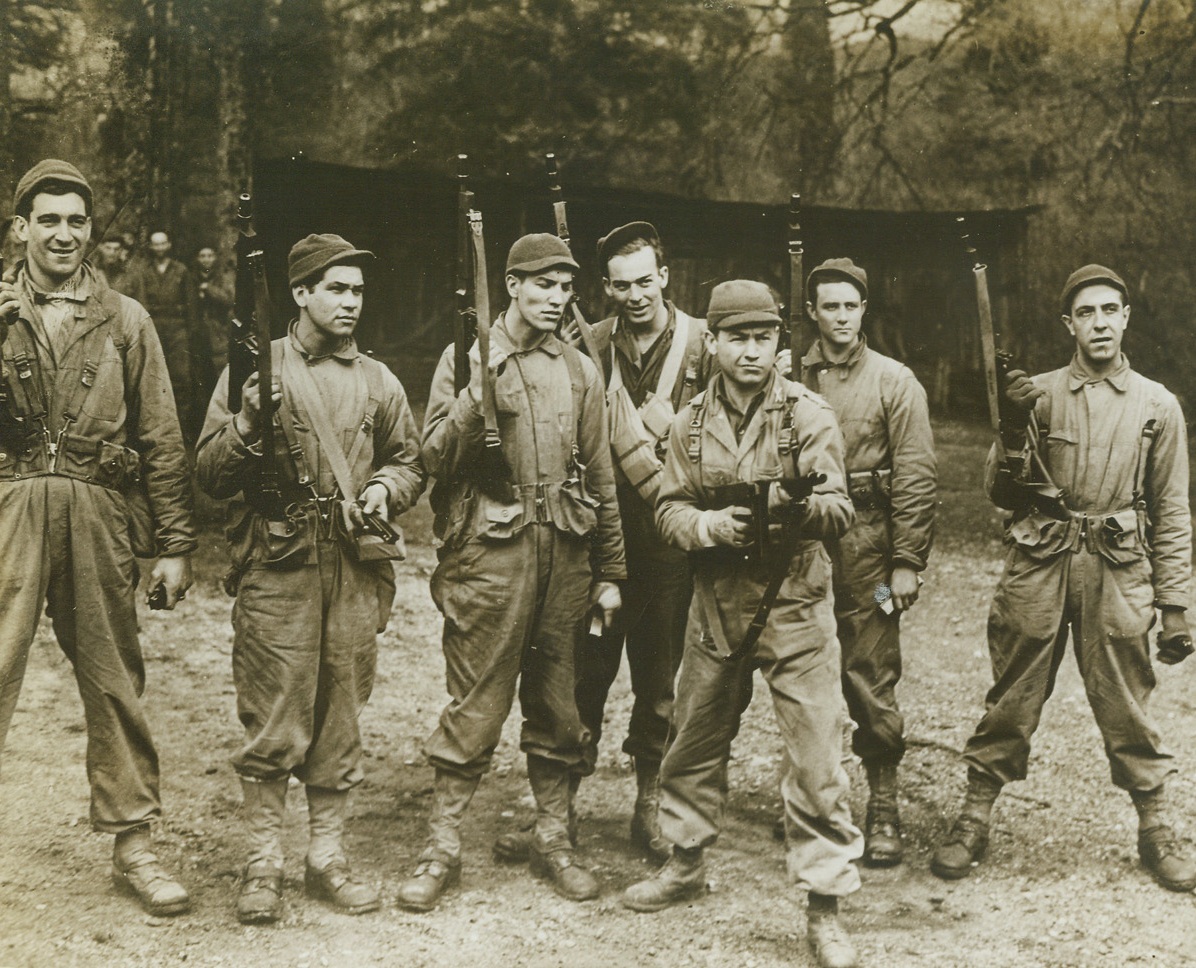
Ready For Invasion Day, 6/16/1943. Somewhere in England – Looking mighty tough, these U.S. Rangers perfect their skill with the “Tommy Gun” against the day when they’ll carry the deadly weapons into Europe and use them to mow Nazis down. Left to right: Pfc. John Toda of Sharon, PA; Pvt. John Dorzi of Barrington, R.I.; Pfc. Jack Homer of Dundalk, MD; Pfc. Robert Reese of McKeesport, PA; Lt. Eugene Dance of Beckley, W.VA; Cpl. Dale Ford, of Thurmont, MD; and Pfc. Manuel Viera of Cambridge, Mass. Credit: Official OWI Photo from ACME;
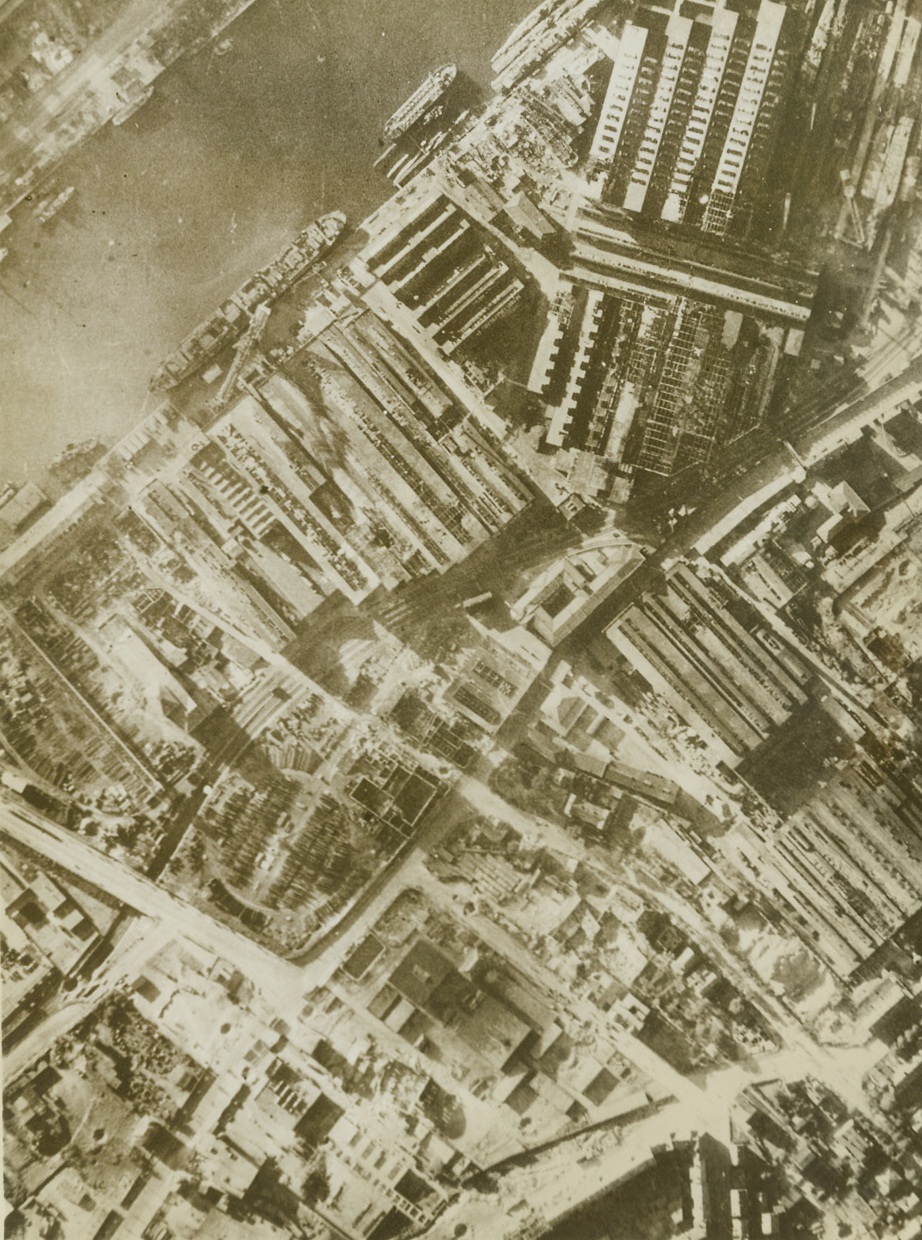
Allies Smack Kiel Shipyard, 6/1/1943.RAF Reconnaissance photographers took this picture of Kiel after a heavy daylight attack by the U.S.A.A.F.’s Flying Fortresses and Liberators on May 14, when tons of explosives were dropped. Almost all buildings in the Germania Yards have sustained varying degrees of damage and several buildings of the Deutsche Worke, A.G. and Naval Arsenal also suffered. Considerable damage to public buildings and railway sidings in the vicinity of the target were also hit. At top center can be seen two submarines which were capsized. Credit: ACME;
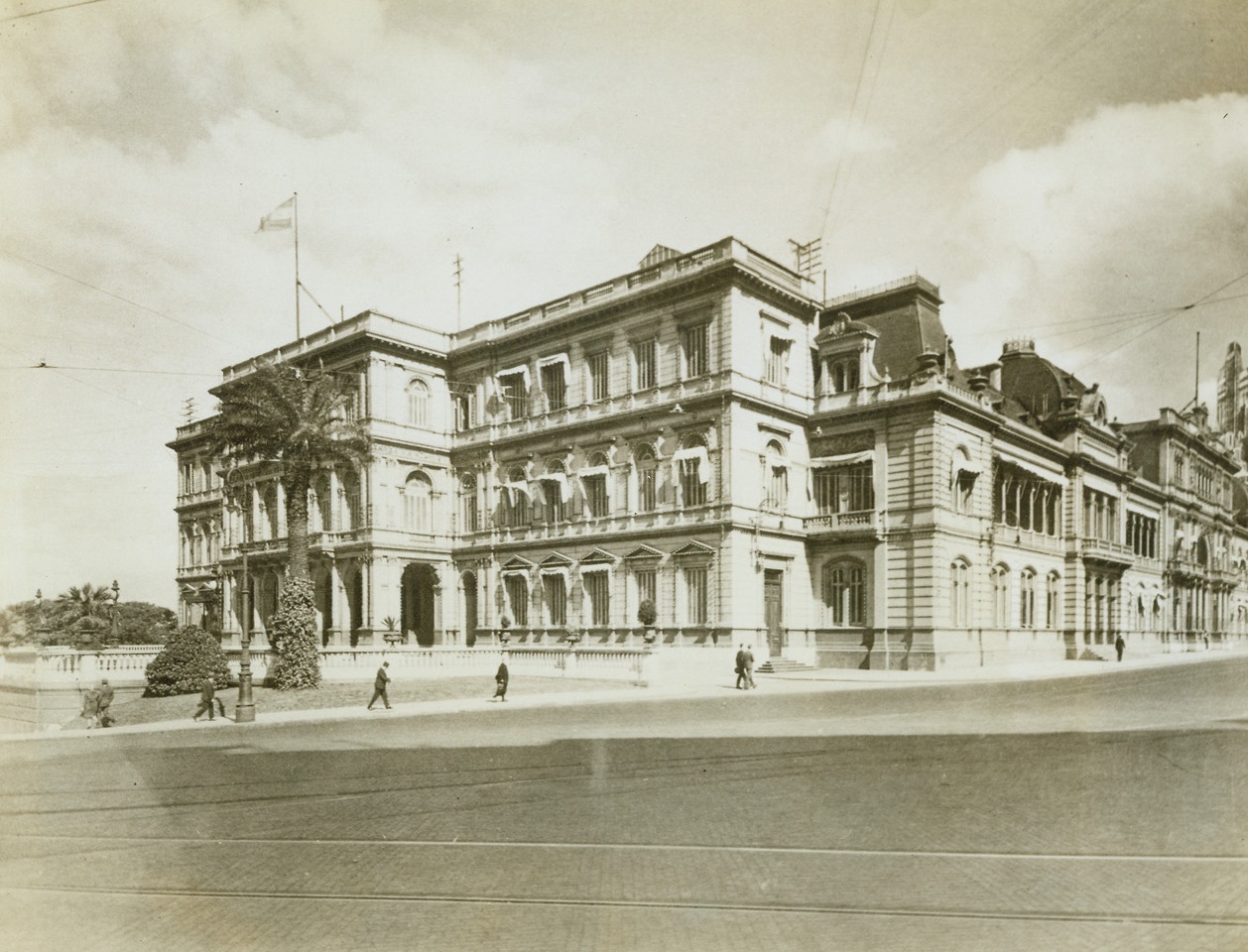
Barred to Castillo, 6/4/1943. Buenos Aires – The Casa Rosado, government house in Buenos Aires, now houses Gen. Antonio Rawson, partners with Gen. Pedro Ramirez in Argentina’s revolt against Castillo, Argentine president who has fled the headquarters. With his plea for assistance from his first field artillery turned down, President Castillo left the Casa Rosado. He returned to be handed an ultimatum demanding his resignation. Although the Chief of Police was ordered to defend the Government House against anti-Castillo demonstrators. Resistance was weak and the leaders of the pro-Allied movement moved in. Credit: ACME;
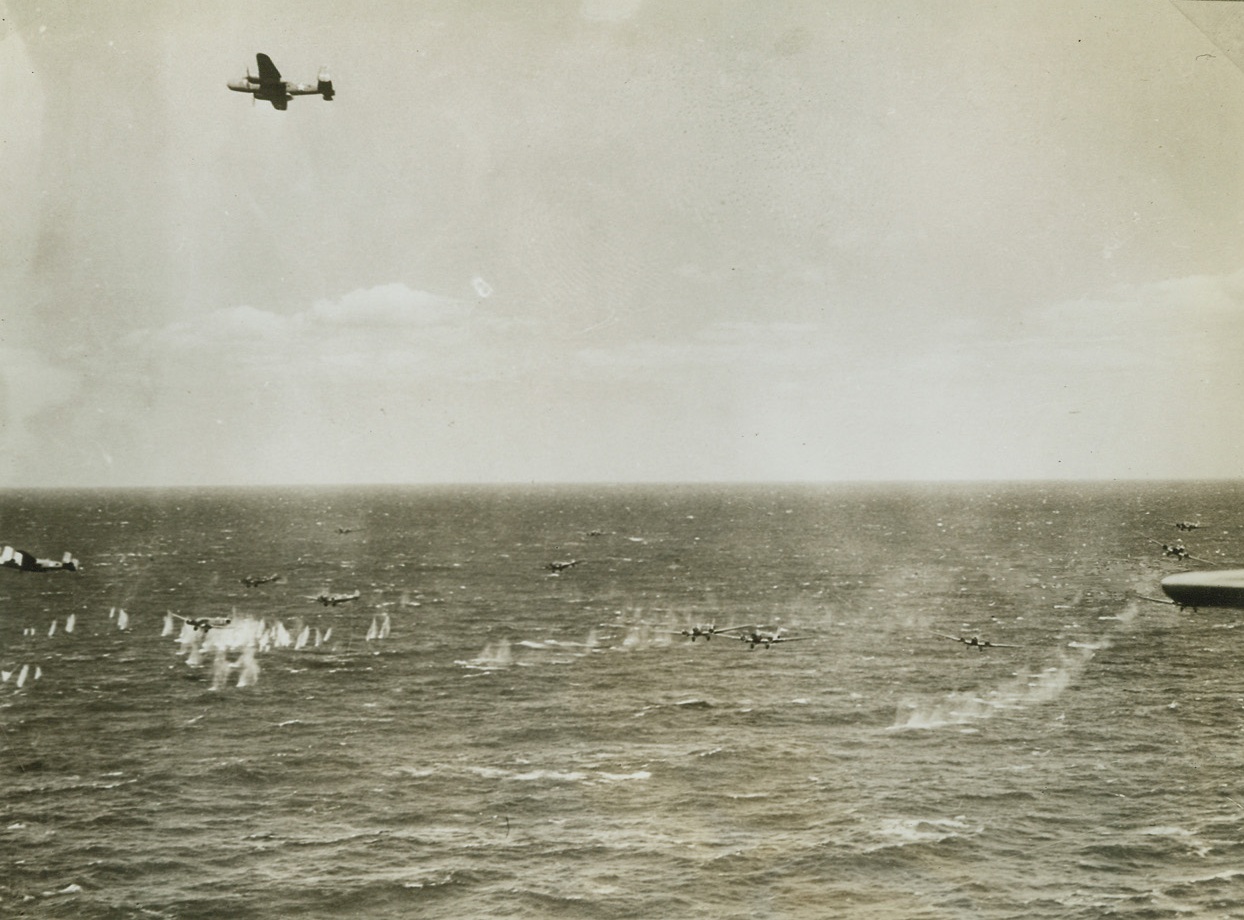
U.S. Fighters Shoot Down 25 Axis Planes, 6/4/1943. Axis planes are riddled by machine gun fire during the recent attack when a formation of U.S. Army Air Forces B-25 Mitchell Bombers and an escort of P-38 Lightnings engaged an Axis air convoy of 35 planes over the Sicilian Straits. Twenty-five of the enemy planes were shot down. Two American planes are shown in this photo. The one at the extreme left, flying low, has just completed attack action while another B-25 is shown overhead. Twelve Axis air transports, almost at water level, are under attack in this view. Credit: U.S. Army Air Force photo from ACME;
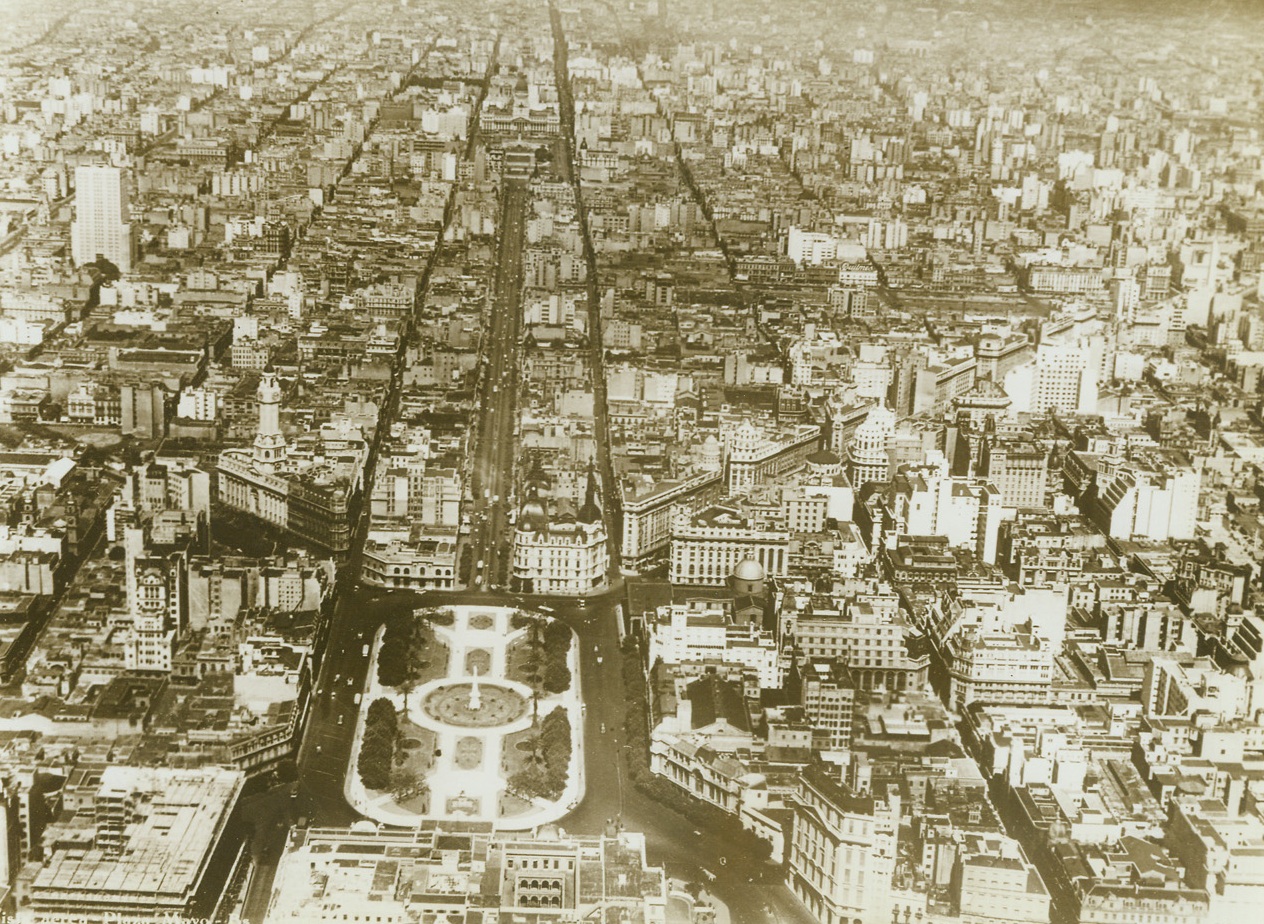
Revolutionaries Seize Buenos Aires, 6/4/1943. Buenos Aires, Argentina – An Army revolt was reported in progress in Argentina today (June 4) following an ultimatum to President Ramon Castillo demanding free elections and a change in the government’s international policy. At midmorning, reports indicated that revolutionaries had seized control of the outskirts of Buenos Aires. Here is an aerial view of the capital city showing Plaza Mayo (May Square) in left foreground and Houses of Congress in center background. Tall skyscraper in upper left is Public Works Ministry. The Finance Ministry and the Government House face the Square at bottom of photo. Credit: ACME;
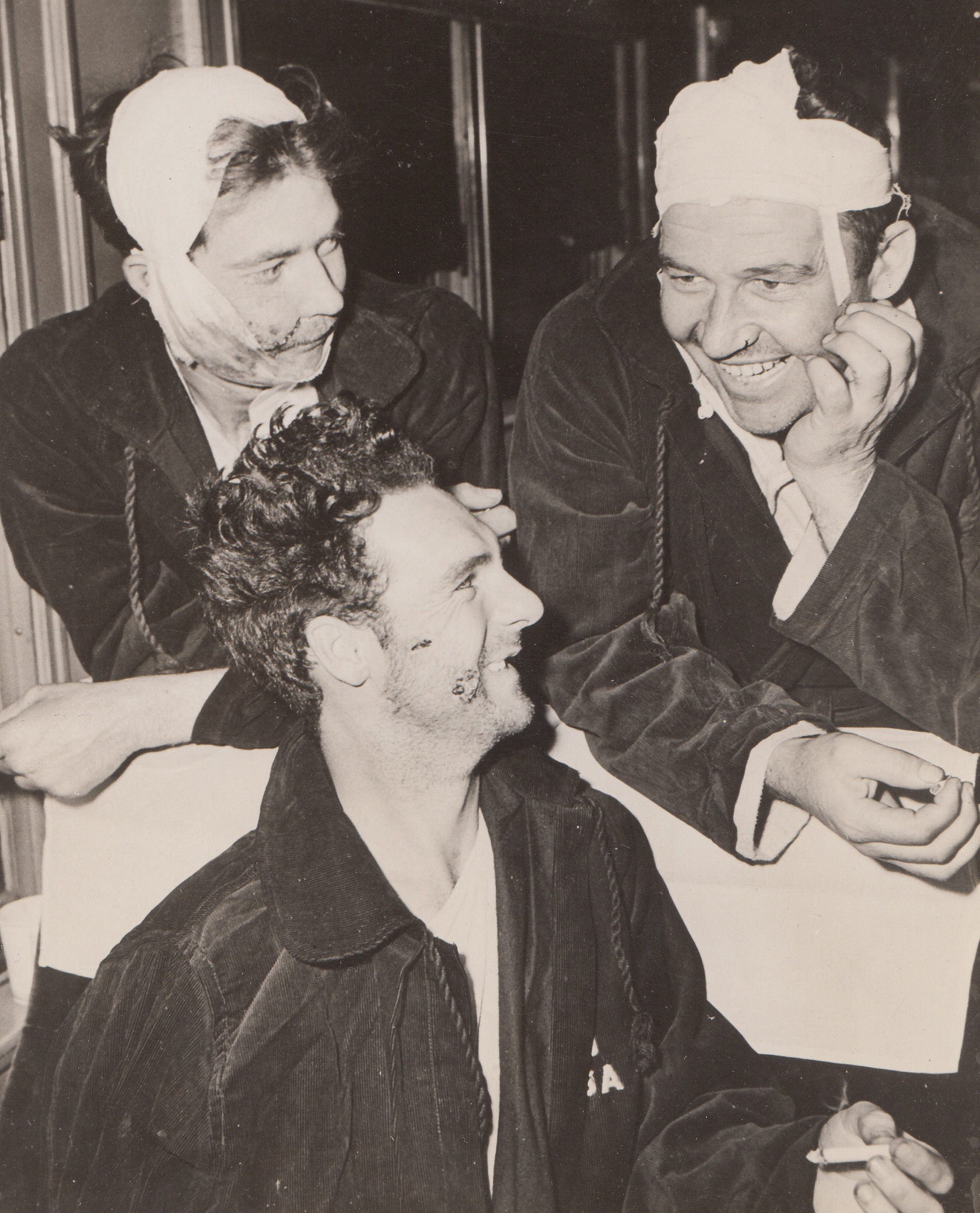
Three Attu Musketeers, 6/6/1943. Seattle, Wash. – Aboard an Army hospital train, these three soldiers who are recovering from head wounds caused by bursting mortar shells, jokingly recall their experiences with the gorilla-like Jap troops on Attu Island, as they are being taken to a Pacific Northwest Army hospital to recover. They are Sgt. J.R. Allison (left rear), Merced, Calif.; Sgt. Lawrence Bradley, Alta Vista, Kan.; and Sgt. Enest Pearce (front) of Murray, Utah. 6/6/43;
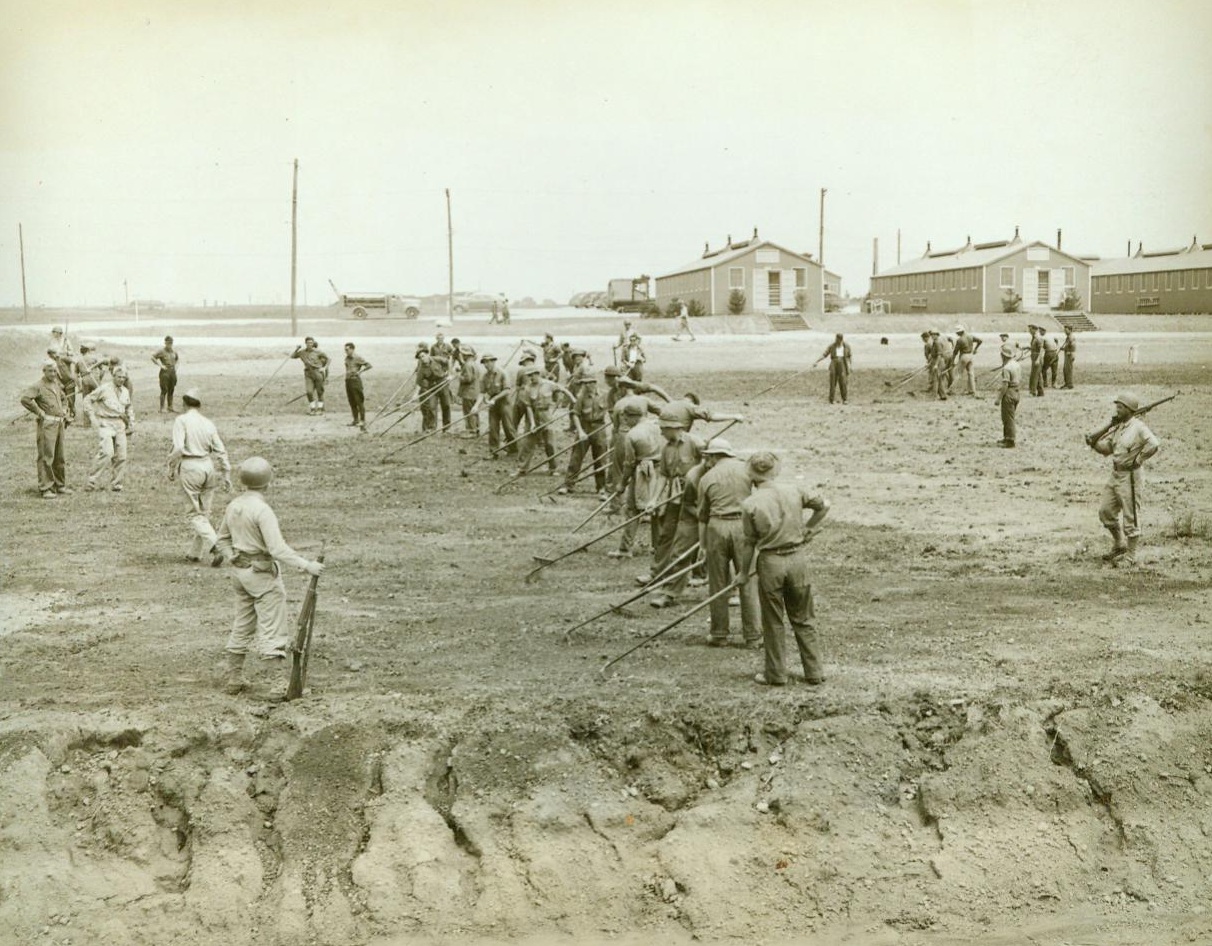
Gardening For Victory, 6/12/1943. Camp Atterbury, Ind. -- Victory gardens are no longer news, for Americans all over the country are cultivating fruits and vegetables to add to the nation's food supply -- But these victory gardeners are news! All Italian prisoners of war, they're helping wartime America on to victory by gardening in a plot outside Camp Atterbury, their internment camp. These men are some of the 14,516 Italians captured by American doughboys and brought to the U.S. for the duration 6/12/43 (ACME);
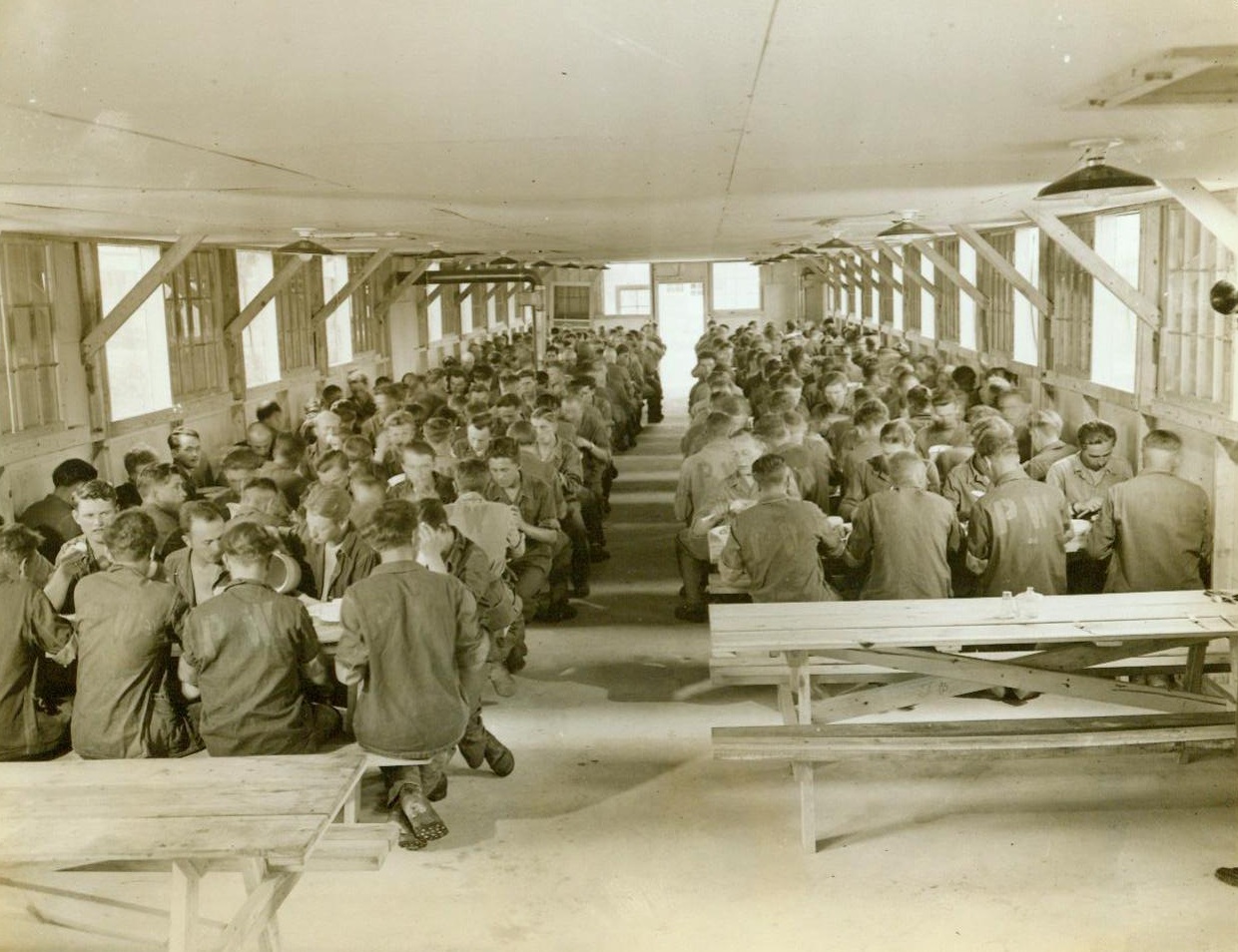
Chow Time At Prison Camp, 6/12/1943. Camp Breckinbridge, KY. - German prisoners of war are shown in the mess hall in the internment area at Camp Breckinbridge, KY., One of the country's many prison camps now being filled with German and Italian captives who are being interned separately. The average camp houses 2,000 prisoners and requires about 500 officers and enlisted men of the Army for proper guarding. The standard stockade at each of the prison camps is an enclosure within a double barbed wire fence, with guard towers covering the narrow alley between the fences. 6/12/43 (ACME);
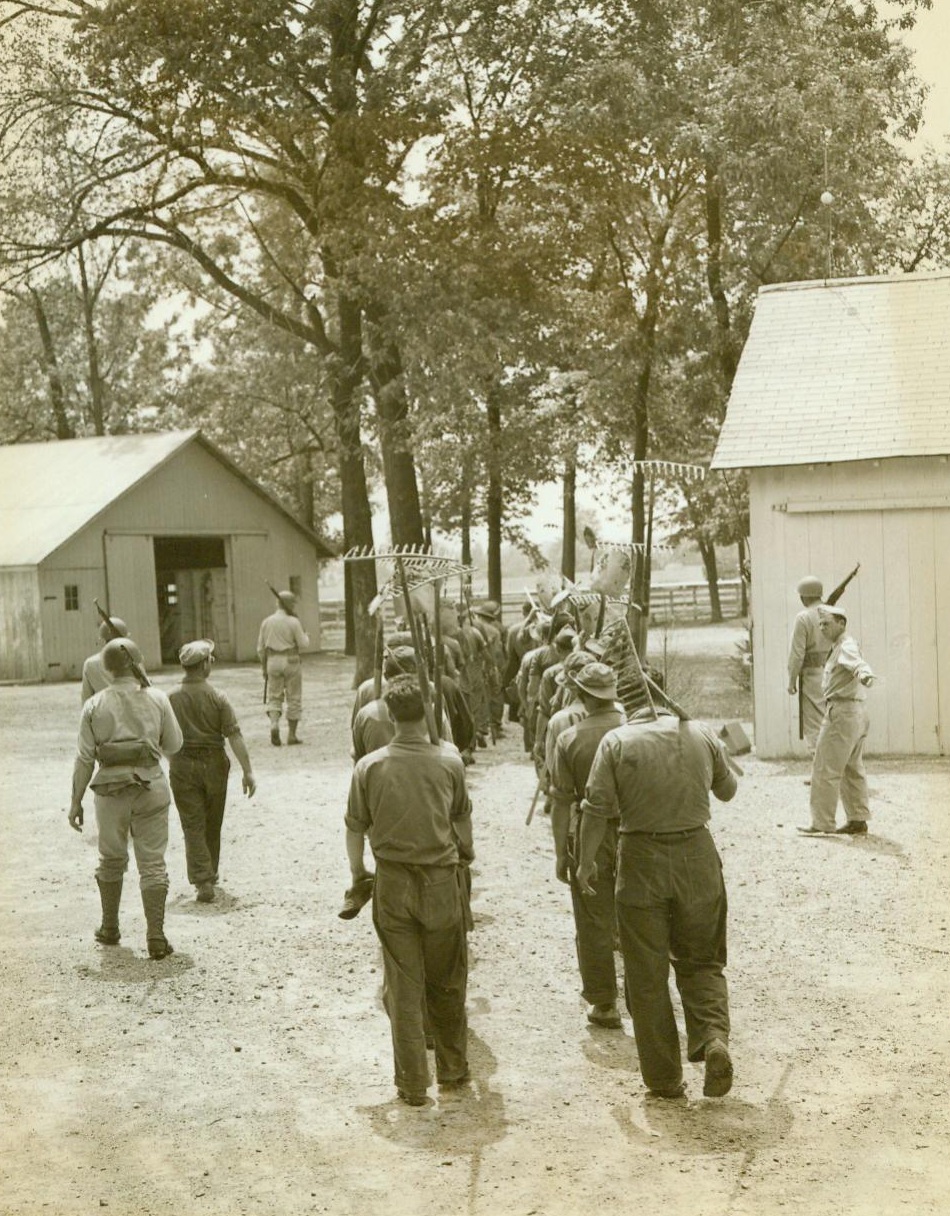
They Labor For America, 6/12/1943. Camp Atterbury, IND. -- Rakes and hoes slung over their shoulders, these Italian prisoners of war march in double file to Camp Atterbury's victory garden -- To help their enemy nation solve her wartime food problems. The men who are some of the 14,516 captured Italians who have been brought to the U.S. for the duration. Since many of them are former farmers, they earn their keep by digging and planting for victory (ACME);
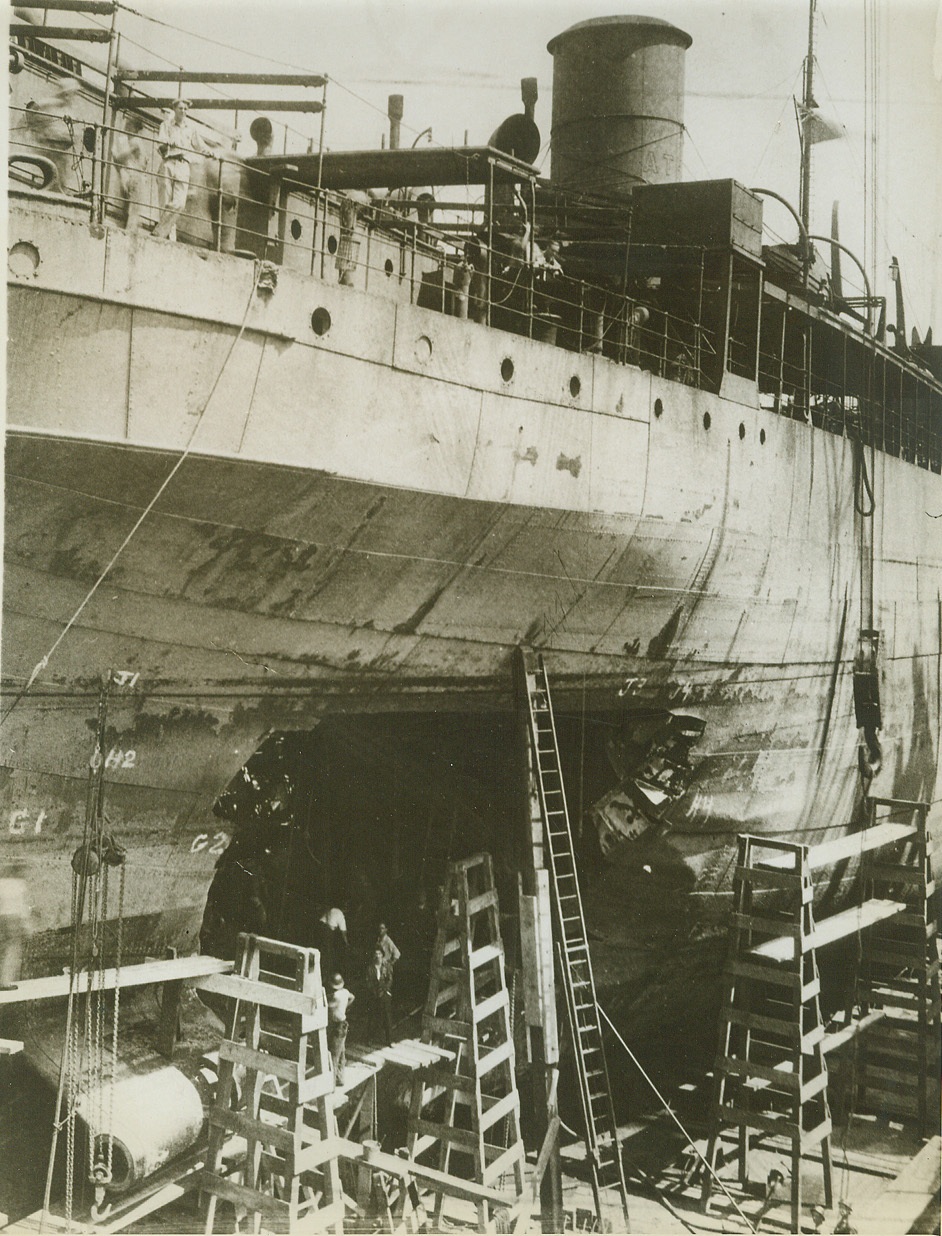
Goes to War Again, 6/16/1943. NEW YORK – Here’s a United Nations ship that was struck by a torpedo. It is shown here just after arrival at a yard of the Todd Shipyards Corp. Officials point out that when a torpedoed ship is drydocked, the gaping jagged hole is clearly visible. Experts must survey and repair the internal damage, which is usually much more serious. The vessel was repaired in record time and is again doing “sea duty.” Credit: (ACME);
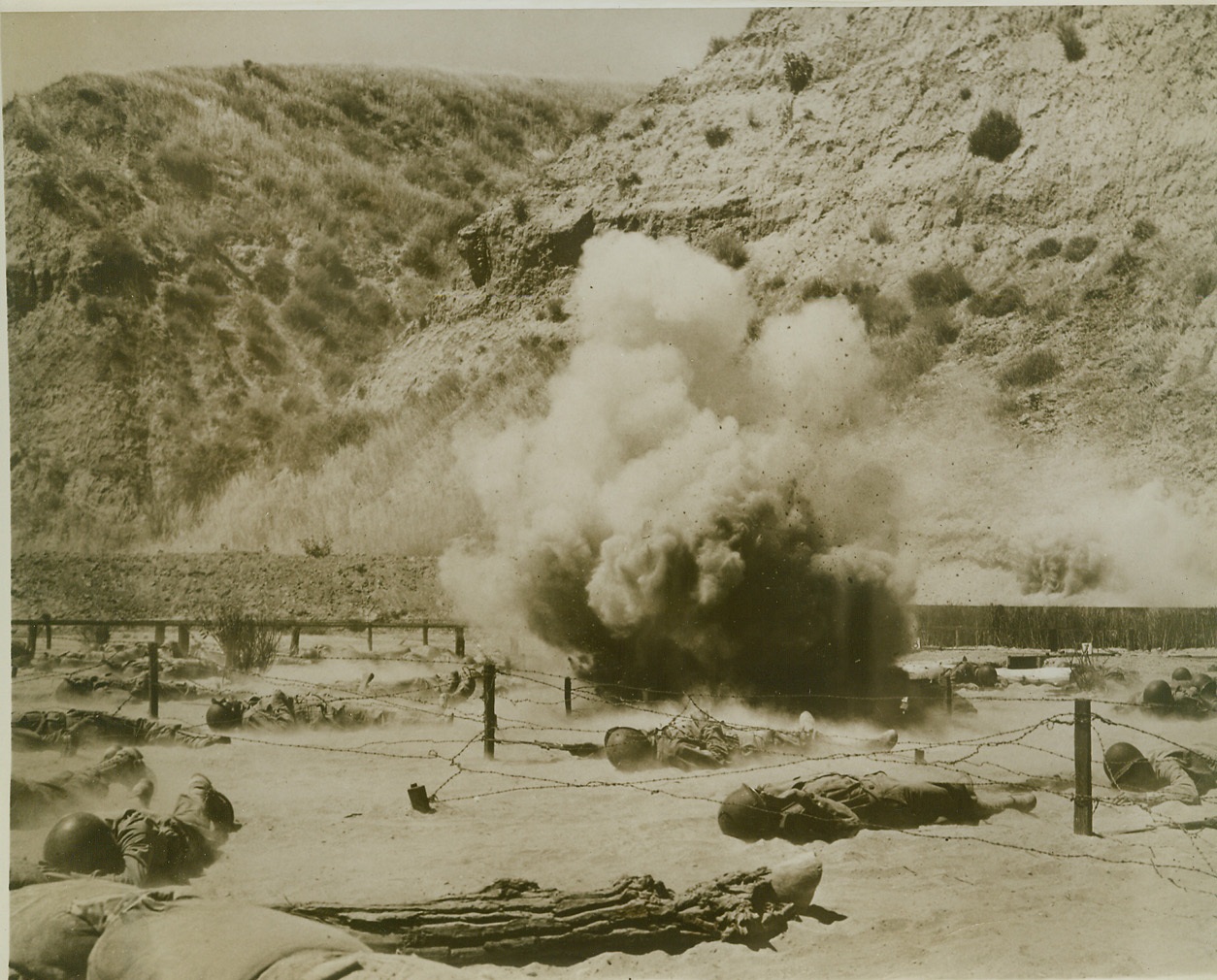
This is War – Almost, 6/24/1943. CAMP ROBERTS, CALIF. – Actual battle will hold few surprises and no fears for trainees schooled at Camp Roberts, for they “fight” under realistic battle conditions on the Camp’s new infiltration course. These infantry trainees flatten themselves on the ground as live machine gun bullets cut the air a few inches above their heads and a land mine explodes right in their midst. Credit (U.S. Signal Corps Photo from ACME);

U.S. Soldiers Run Painful Race to Health, 6/26/1943. Getting over these foot high hurdles is no easy task for Pvt. Ralph Johnson, of Pittsburg, Pa., who needs one strong arm of Sgt. D.D. Gilbert of Philadelphia, Pa., to finish out his first race with health. Hospitalized somewhere overseas these wounded American soldiers must take special therapeutic exercises in the hospital gymnasium to rehabilitate the injured limbs and muscles. Credit: (Signal Corps Photo from OWI – ACME);

Submarine R-12 Lost, 6/26/1943. Lost as the result of an accident which occurred during training exercises, the U.S. submarine R-12 took several men and officers down with her when she sank off the East Coast recently. The depth of the water makes it impossible to salvage the vessel and all hope for recovery of the bodies of the missing personnel has been abandoned. Although no figures on casualties were released, the R-12 carried a normal complement of 28 officers and men, some of whom survived. Credit: (Official U.S. Navy Photo from ACME);
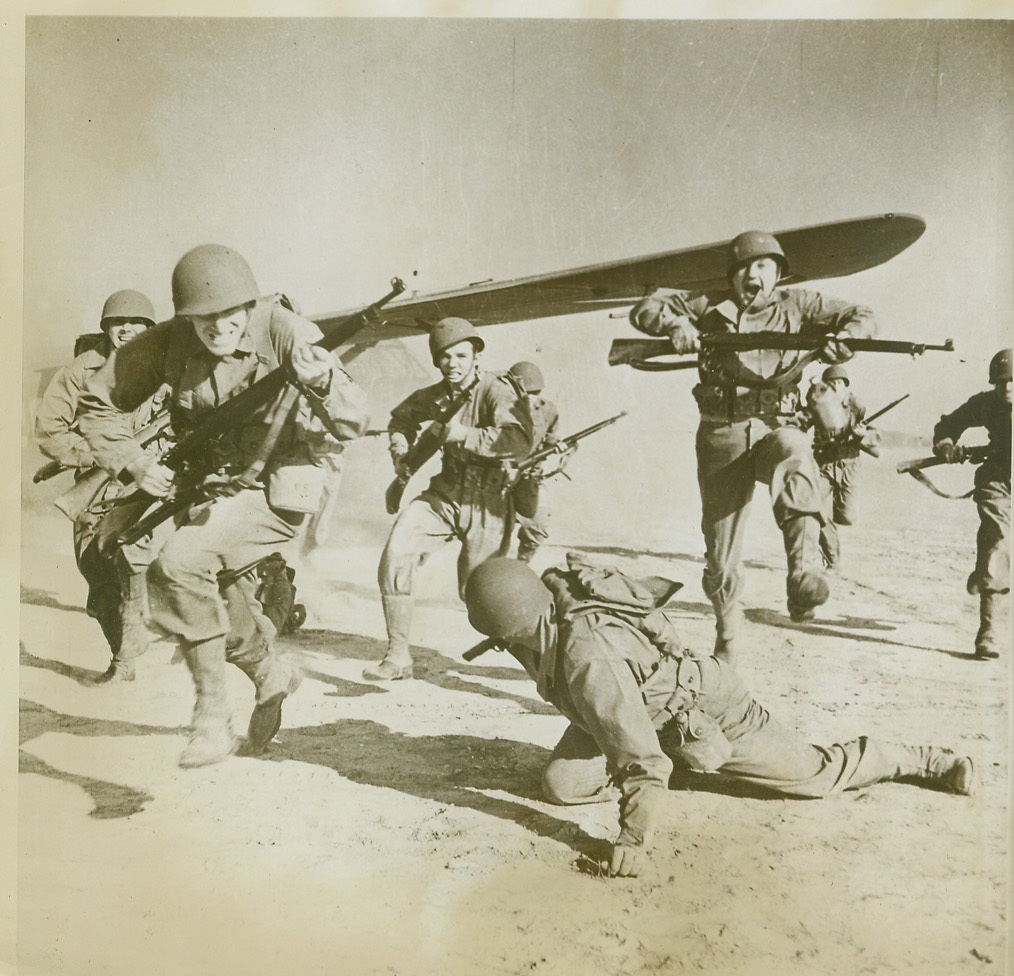
Glider Troops Prepare for Invasion, 6/28/1943. A U.S. GLIDER SCHOOL—Glider troops, in training at a glider activity base in the United States, practice charging the “enemy” after landing in their bomber-towed glider. These huge gliders, “freight cars” of the air, can carry 15 fully-equipped troops, a Jeep, or field artillery. They are being built in ever-increasing quantities in preparation for the coming invasion of Nazi-dominated Europe. Credit: (U.S. Army Air Corps Photo from ACME);
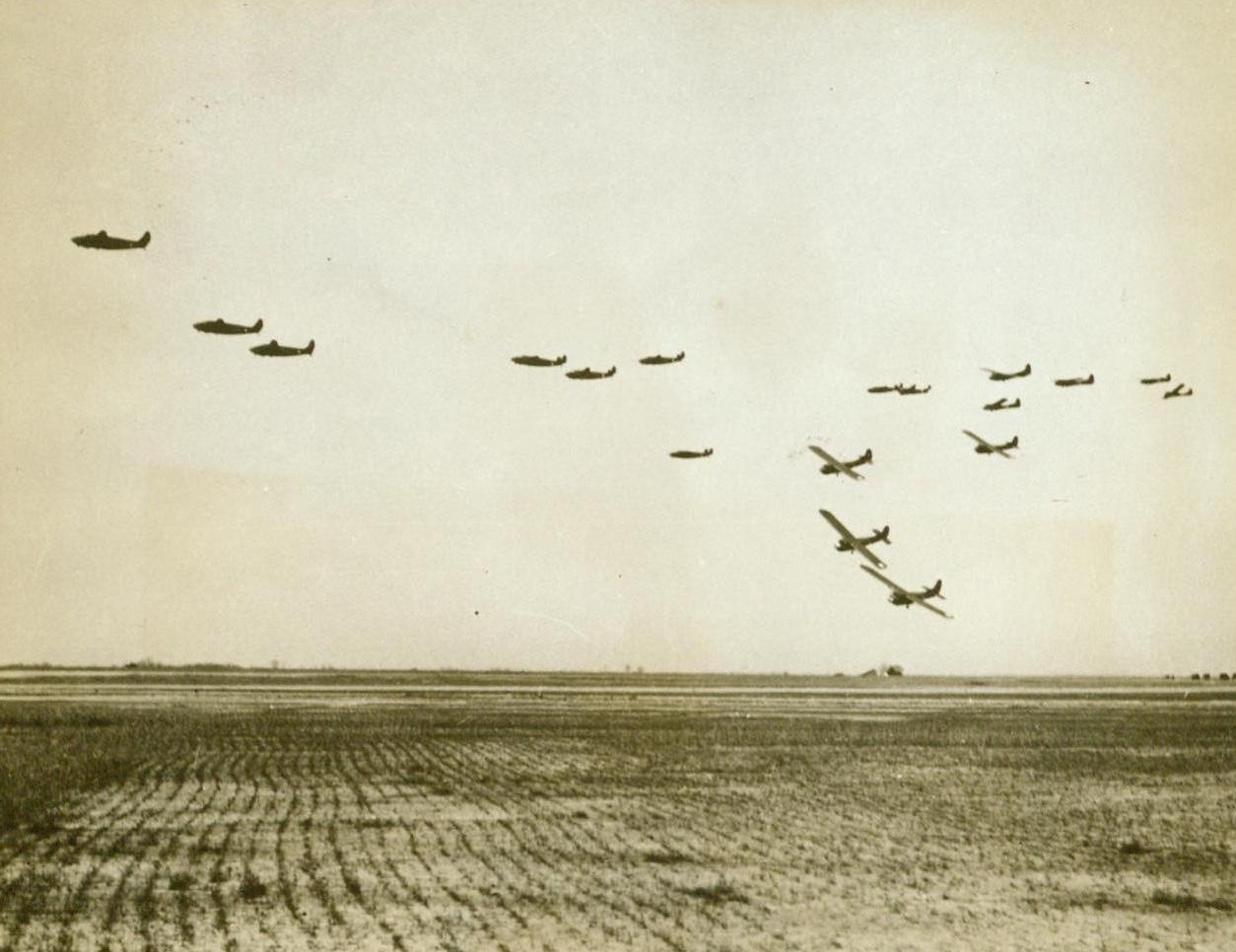
Glider Troops Prepare For Invasion, 6/28/1943. A U.S. Glider School – Gliders, flying “freight cars” which can carry a jeep, field artillery, or a compliment of 15 men equipped as shock troops, peel off from formation to land, after releasing tow ropes attached to the bombers that towed them. These gliders are being used at a Glider Activity School in the United States, where glider troops are training for the coming invasion of Nazi-occupied Europe. 6/28/43 (ACME);
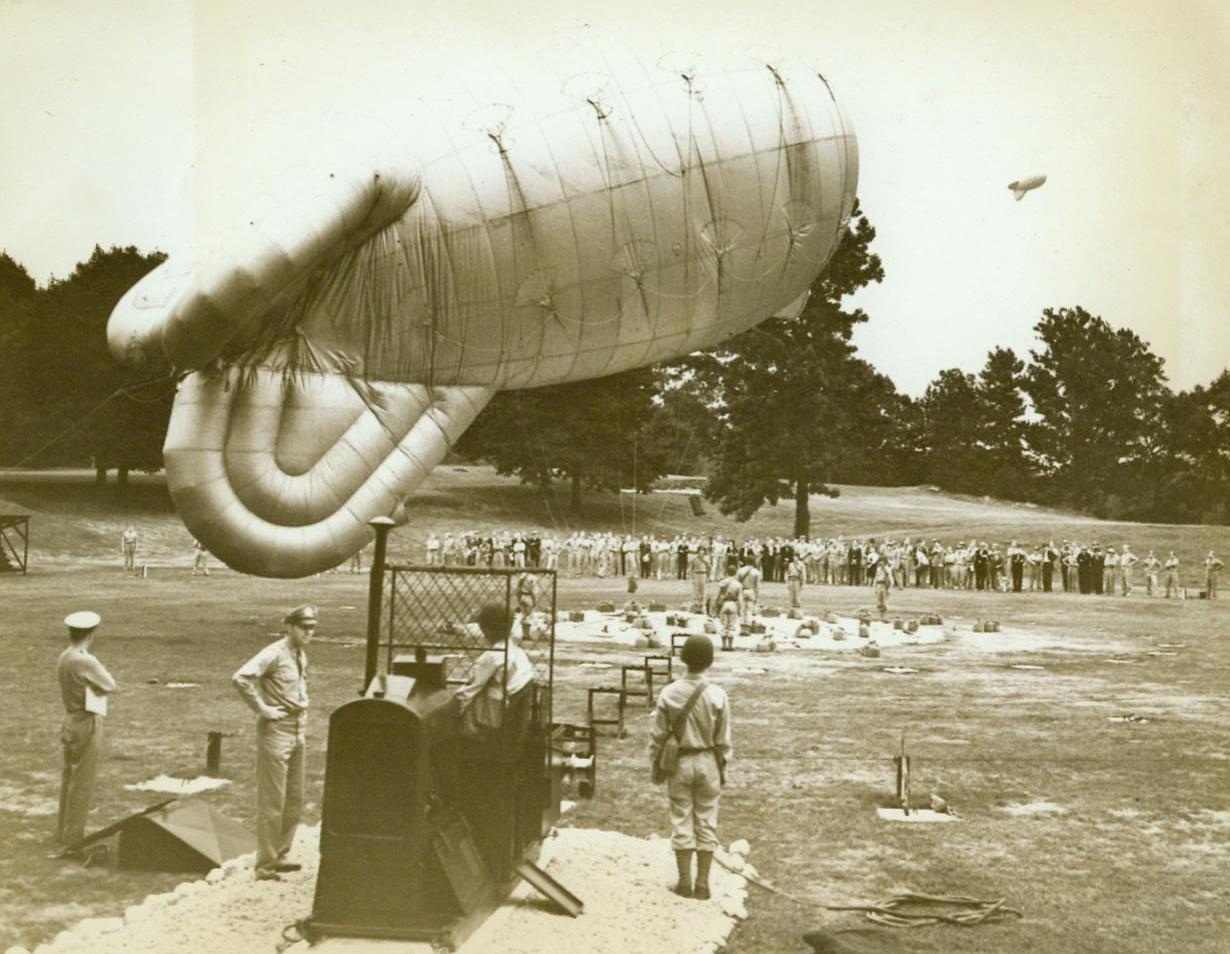
Barrage Balloons Ready In N.Y. Area, 6/29/1943. The busy and populous New York Metropolitan Area is now well protected from low-level enemy air attack, by barrage balloons, which have recently been placed in their battle positions. Under the direction of Maj. Gen. Sanderford Jarman’s antiaircraft artillery command, the balloons offer a menace to any enemy air raiders that try to attack New York City. Completely equipped with a repair shop and gas-generating unit, these “kite” balloons are ready for instant use. When they have been raised, they stretch steel cables that would knife through the wing of any low flying plane like a hot knife through butter. A ring of these “rubber cows” force enemy bombers to fly at high altitudes, lowering bombing efficiency. Furthermore, they are extremely effective against dive-bombing and “hedgehopping” aircraft. In this series of photos, are some of the balloons that now defend New York City. Here, at a balloon station “somewhere on Long Island,” members of the 13-man crew stand by to release a “rubber cow.: in left foreground is the power winch which raises or lowers the balloon by means of its steel cable. Balloon can be raised several thousand feet in a matter of seconds. 6/29/43 (ACME);
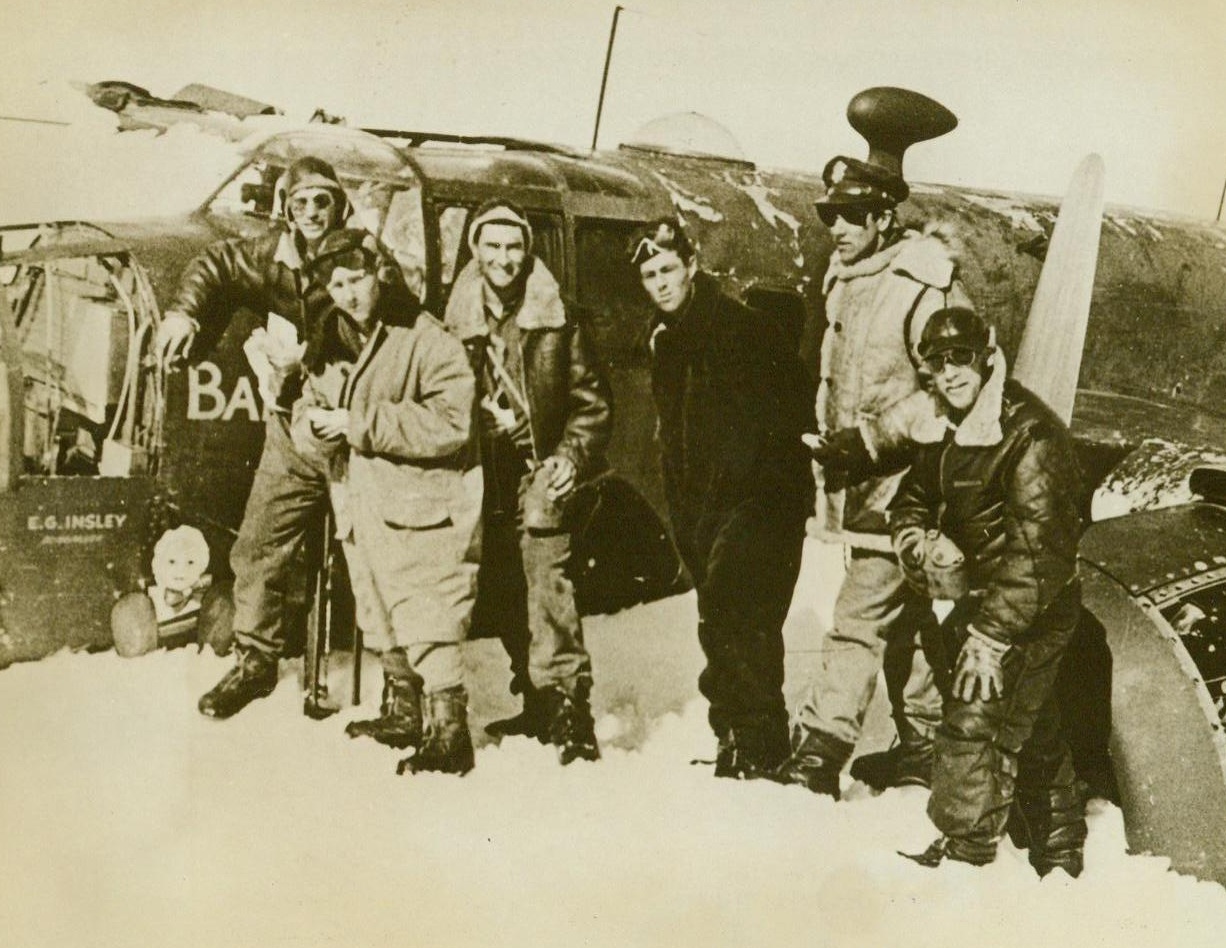
Fliers Rescued After Crash, 6/28/1943. Greenland – Crewmembers and their Mitchell B-25 Patrol Bomber are shown after their ship crashed on the coast of Greenland, when it ran out of fuel on a patrol flight through bad weather. They lived for four days on emergency rations and water melted from snow. Their weak radio signals brought a plane, and then a Coast Guard vessel, which rescued them. Left to right, are: Sgt. J. Whitehead, Engineer; Sgt. J.R. Brewster, Radio Operator; Sgt. C.C. Cook, Operator; Lt. J.I. Moor, Co-Pilot; Lt. J.J. Blais, Pilot; and Sgt. J.C. Whitman, Bombadier. 6/28/43 (ACME);
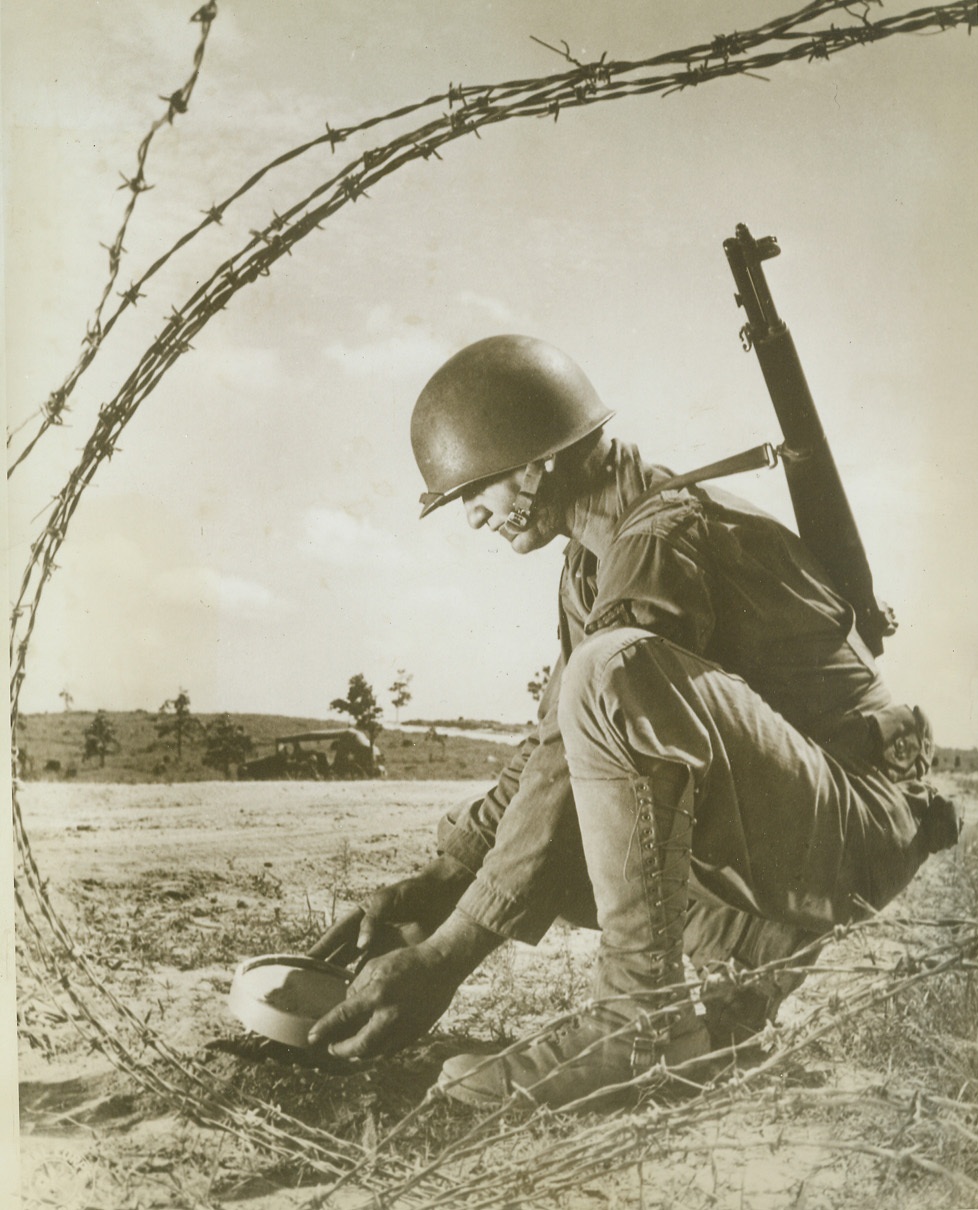
Touchy Business, 6/10/1943. Louisiana—The task of laying mines is almost as delicate as finding them on an enemy field. Here PFC Leonard A. Keller, of Mission, Tex., is learning how to handle the deadly “cakes” as he trains for his job on the fighting front during Third Army maneuvers in Lousiana. Credit: ACME;
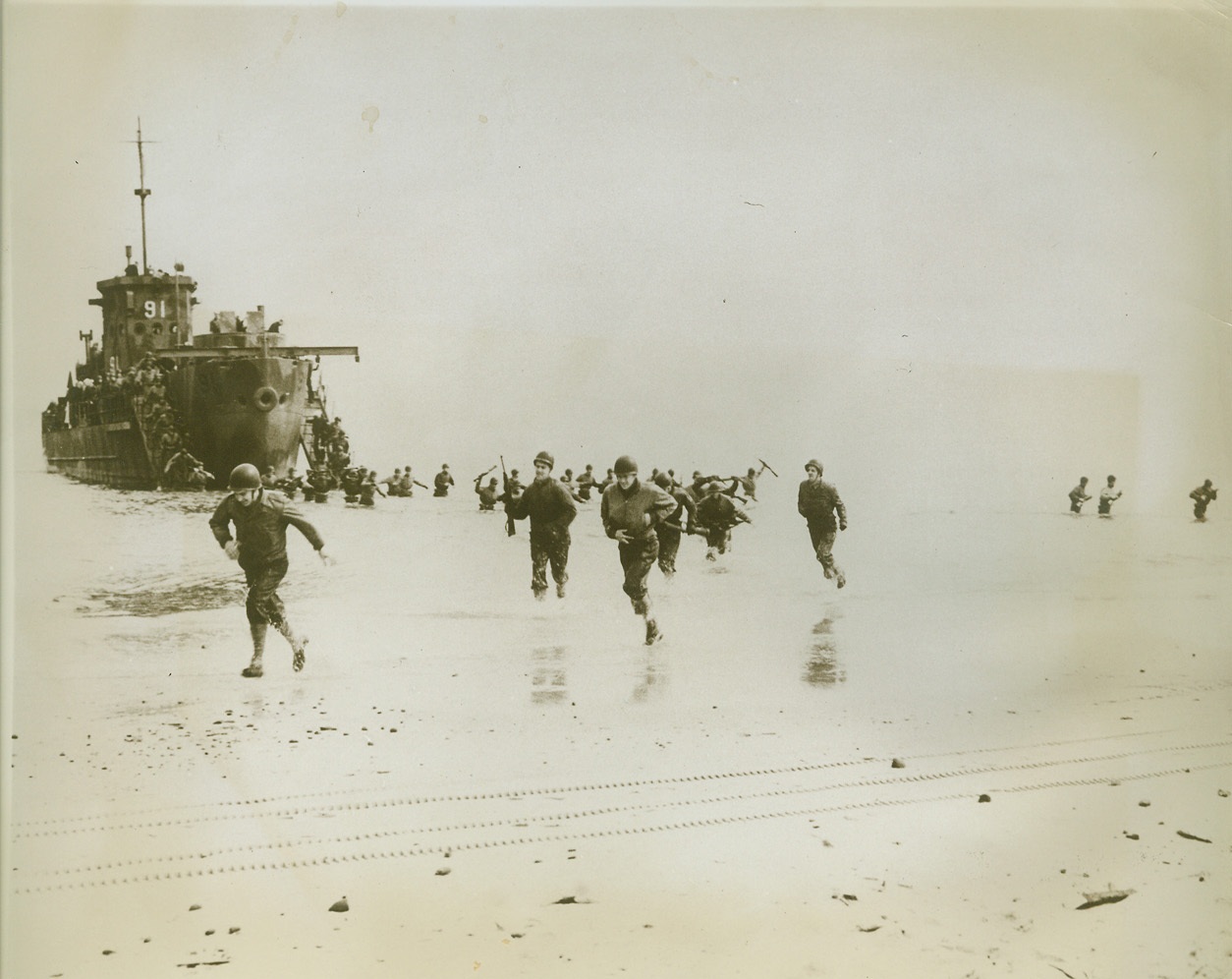
Training For Invasion By Sea, 6/17/1943. SOMEWHERE ALONG THE ATLANTIC COAST - Streaming into waist-deep waters from an L.C.I. (Landing Craft: Infantry), U.S. Army troops "hit the beach" during practice invasion maneuvers along the Atlantic Coast. Training to strike as a strong, well-drilled invasion spearhead, these men will form part of a unified Army-Navy amphibious force to storm enemy strongholds from the sea.;
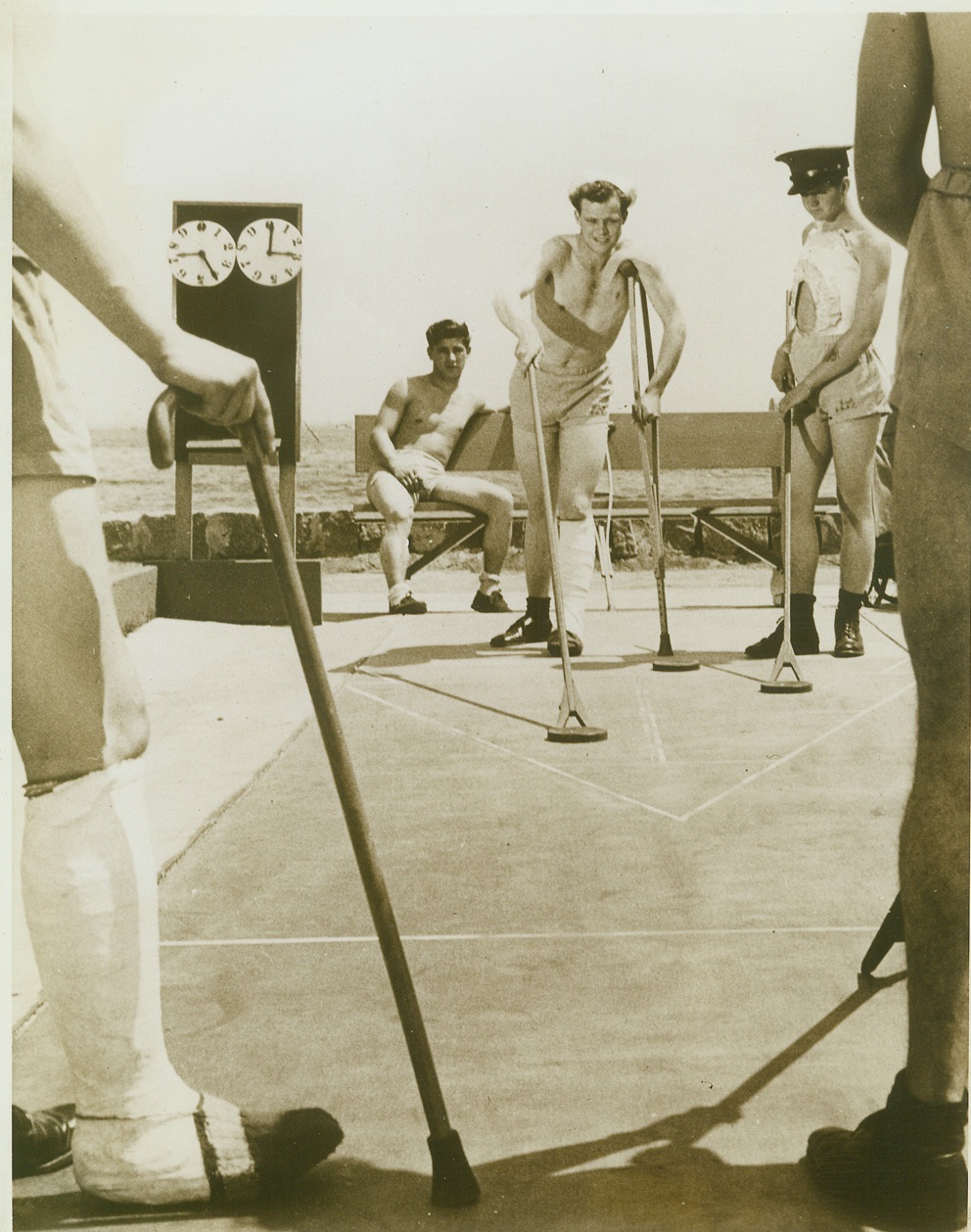
Crutches and Canes and Shuffleboard, 6/4/1943. San Diego, Calif.—Takes more than crutches and canes to sink the morale of Uncle Sam’s gobs. In spite of their injuries, these boys enjoy a game of shuffleboard during an outing for patients of the San Diego Naval Hospital. M.R. McConnell, shipfitter third class, leans on his crutch as he sends a disc down the deck. Credit: Official U.S. Navy photo from ACME.;
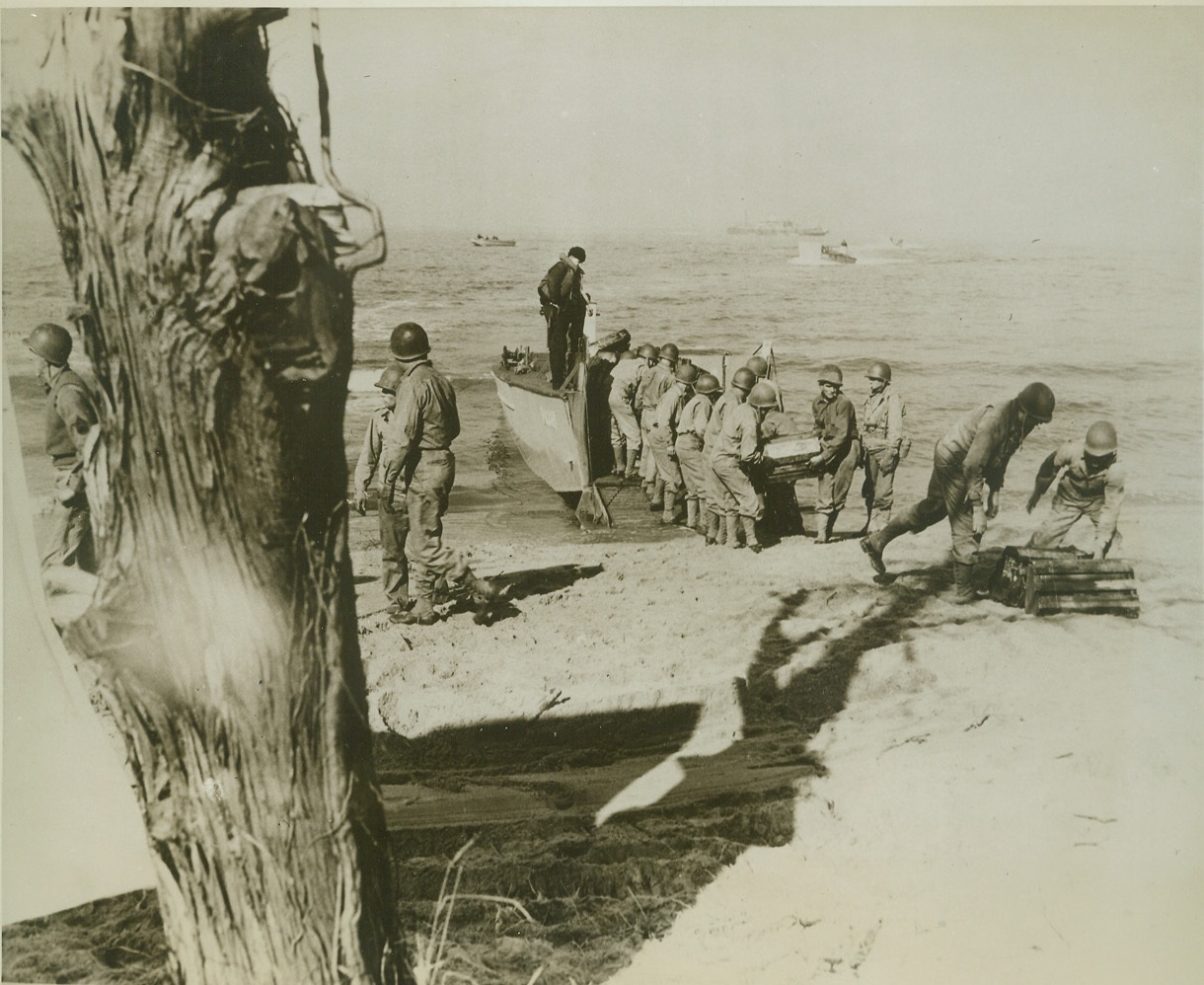
Bringing Up the Ammunition, 6/17/1943. Somewhere on the East Coast—Carting heavy loads of ammunition from a landing barge, these Yanks hold a dress rehearsal in preparation for the day when they’ll stream from U.S. Navy transports to invade enemy seaside strongholds, training to work as part of a unified Army-Navy amphibious force, composed of ricked officers and men from both services, these boys learn to carry out the most difficult of all military assignments—landing on a fortified, hostile shore. Credit: Official U.S. Navy photo from ACME.;
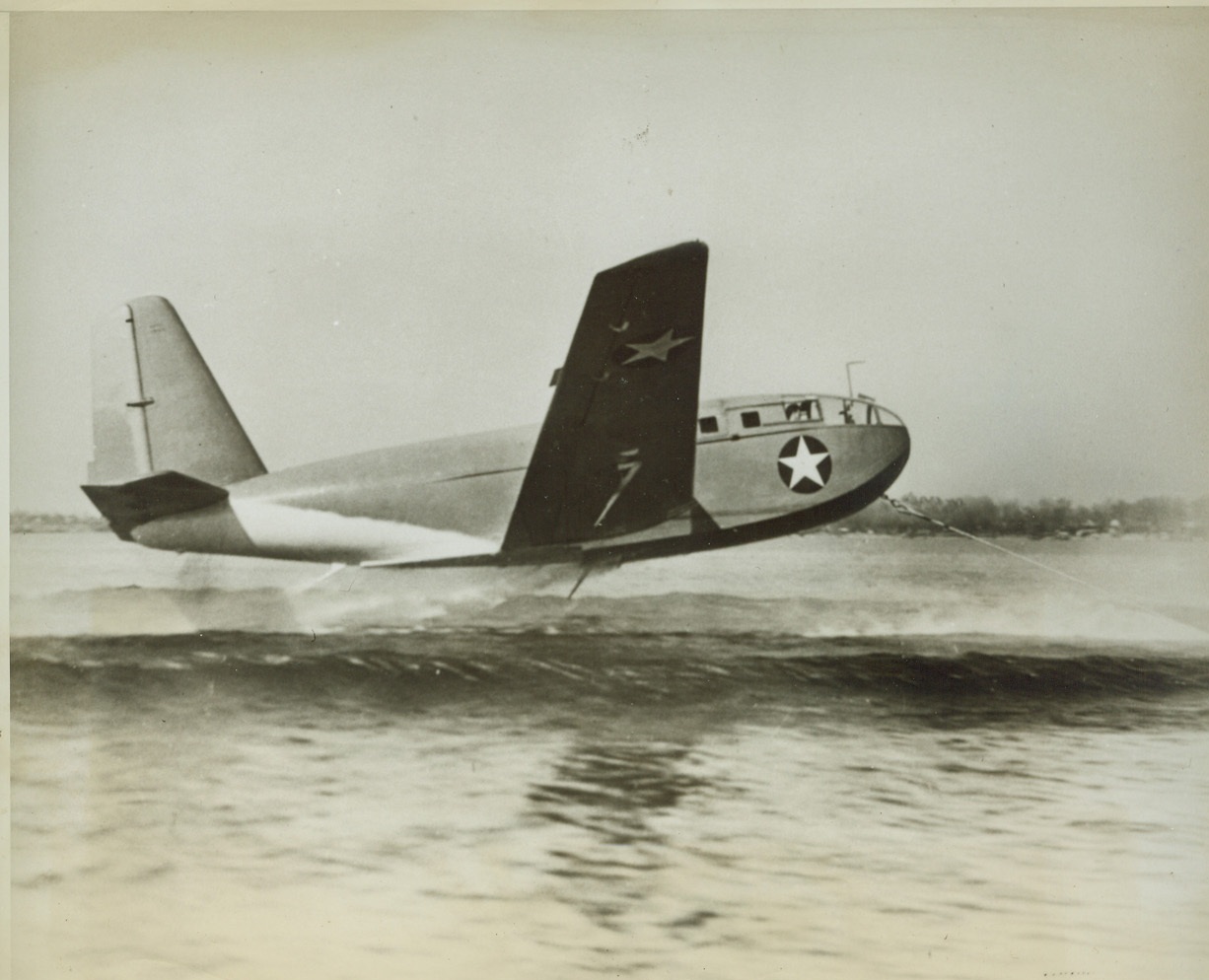
Glider Takes to Water, 6/14/1943. An amphibious transport glider skims the water in the first picture released of one of America’s newest invasion weapons to be used by the Marines. Produced of moulded plywood and other non-strategic materials, the sky fish that can swim was designed for the U.S. Navy by the Allied Aviation Corp., of Baltimore, MD. Credit: ACME.;





 Trash & Recycling
Trash & Recycling
 Online Payments
Online Payments
 City Documents
City Documents
 Parks
Parks
 Traffic Court
Traffic Court
 CITY PARKS
CITY PARKS
 Outdoor Recreation
Outdoor Recreation
 Volunteer
Volunteer
 Home
Home TRANSLATE
TRANSLATE
